Author: JapaChat
-

Top Picks for Nigerians: The Best Places to Live in Canada
Moving to Canada from Nigeria is a life-changing decision, and choosing the right city is the first critical step to ensuring your success. The goal isn't just about finding a place with jobs; it's about discovering a community where you can feel at home, where your professional skills are in high demand, and where the climate, while very different from back home, is manageable. This guide is specifically for you: the Nigerian professional, student, or family looking for practical, no-nonsense advice on the best places to settle.
We will break down the most good places to live in Canada, focusing on what truly matters to someone relocating from Lagos, Abuja, or Port Harcourt. This isn't generic tourist information. Instead, we provide actionable insights on:
- Cost of Living: Realistic costs for renting a flat, transportation, and daily expenses. How much will your Naira really be worth?
- Job Markets: The specific industries that are hiring and which skills are most sought after.
- Nigerian Community: Where to find established communities, resources like African grocery stores, churches, and mosques to help you settle in.
- Immigration Pathways: The most common visa routes, including Provincial Nominee Programs (PNPs) and Express Entry streams, leading to each city.
Think of this as your personal roadmap for 2025 and beyond, designed to help you avoid common "I wish I knew" stories and choose a city that aligns with your lifestyle and career ambitions. As you plan your move and consider ways to thrive economically, understanding the key advantages of incorporating a business in Canada can be a valuable insight for entrepreneurs. For personalised immigration plans, remember that tools like JapaChat can offer AI-driven guidance tailored to your specific profile.
1. Toronto, Ontario: The Economic Engine
For many Nigerians, Toronto is the Lagos of Canada – a bustling, diverse economic powerhouse where things happen. As Canada's largest city and financial centre, it offers unparalleled career opportunities, particularly if you work in finance, technology, healthcare, or media. The city’s multicultural fabric means you are never far from home; finding egusi, yam, or stockfish is easy, and there are countless Nigerian churches, mosques, and vibrant community events creating a strong sense of belonging.

This familiarity and robust job market make Toronto one of the good places to live in Canada, but it comes at a price. The cost of living, especially housing, is among the highest in the country. Your settlement funds will go fast here, so a solid financial strategy is non-negotiable.
Why Toronto is a Top Choice
- Job Market: Home to major banks (RBC, TD, Scotiabank), a booming tech scene like a bigger Yaba, and world-class hospitals.
- Nigerian Community: A massive, well-established Nigerian population, especially in areas like Brampton and Scarborough, offers a ready-made support system.
- Immigration Pathways: The Ontario Immigrant Nominee Program (OINP) is a popular route, often targeting candidates in the federal Express Entry pool with experience in in-demand sectors. Find out more about the Ontario Immigrant Nominee Program on Japachat.
Practical Tips for Newcomers
To manage costs, consider living in well-connected suburbs like Mississauga, Brampton, or Scarborough. They offer more affordable rent and are just a GO Train ride away from downtown. Start networking on LinkedIn with Nigerians already in your field before you even land; this community is known for its willingness to help newcomers find their footing.
2. Toronto, Ontario: The Economic Engine
For many Nigerians, Toronto is the Lagos of Canada – a bustling, diverse economic powerhouse where things happen. As Canada's largest city and financial centre, it offers unparalleled career opportunities, particularly if you work in finance, technology, healthcare, or media. The city’s multicultural fabric means you are never far from home; finding egusi, yam, or stockfish is easy, and there are countless Nigerian churches, mosques, and vibrant community events creating a strong sense of belonging.

This familiarity and robust job market make Toronto one of the good places to live in Canada, but it comes at a price. The cost of living, especially housing, is among the highest in the country. Your settlement funds will go fast here, so a solid financial strategy is non-negotiable.
Why Toronto is a Top Choice
- Job Market: Home to major banks (RBC, TD, Scotiabank), a booming tech scene like a bigger Yaba, and world-class hospitals.
- Nigerian Community: A massive, well-established Nigerian population, especially in areas like Brampton and Scarborough, offers a ready-made support system.
- Immigration Pathways: The Ontario Immigrant Nominee Program (OINP) is a popular route, often targeting candidates in the federal Express Entry pool with experience in in-demand sectors. Find out more about the Ontario Immigrant Nominee Program on Japachat.
Practical Tips for Newcomers
To manage costs, consider living in well-connected suburbs like Mississauga, Brampton, or Scarborough. They offer more affordable rent and are just a GO Train ride away from downtown. Start networking on LinkedIn with Nigerians already in your field before you even land; this community is known for its willingness to help newcomers find their footing.
3. Calgary, Alberta – Energy City Boom
Calgary is often called the “Texas of Canada,” and for a good reason. Its economy has long been powered by the oil and gas industry, similar to Port Harcourt but on a much larger scale, creating high-paying jobs for engineers, geoscientists, and skilled tradespeople. However, the city is rapidly diversifying into tech, agribusiness, and renewable energy, offering new avenues for professionals from various backgrounds.
Unlike Toronto, Calgary offers a much lower cost of living, especially for housing. You can rent a decent apartment or even think about buying a house much sooner. This affordability, combined with high average salaries and no provincial sales tax (imagine no VAT on most things you buy!), makes it one of the good places to live in Canada for building wealth. Plus, the stunning Rocky Mountains are nearby for weekend trips.
Why Calgary is a Top Choice
- Job Market: A global hub for energy companies (Suncor, Cenovus), with a growing tech scene and opportunities in logistics and engineering.
- Nigerian Community: A growing and very welcoming Nigerian community is present, with several cultural associations, churches, and stores, particularly in the northeast and northwest parts of the city.
- Immigration Pathways: The Alberta Advantage Immigration Program (AAIP) is a key route, with streams like the Alberta Express Entry Stream targeting candidates who can support the province’s economic diversification. Find out more about the Alberta Immigrant Nominee Program on Japachat.
Practical Tips for Newcomers
Prepare for the weather. Calgary winters are no joke—they are cold and snowy. Investing in proper winter gear (thermal wear, insulated boots, a warm parka) is non-negotiable. When looking for a place to live, communities in the Northeast (NE) like Saddletowne or Martindale are popular among new immigrants for their affordability and access to amenities and transit.
4. Montreal, Quebec: The Cultural Capital
For those drawn to a European flair and a vibrant arts scene, Montreal offers a unique experience. As Canada's cultural capital, it combines historic charm with a modern, creative energy. This French-speaking city is significantly more affordable than Toronto or Vancouver, allowing for a higher quality of life on a more modest budget—a huge advantage for students and young families.
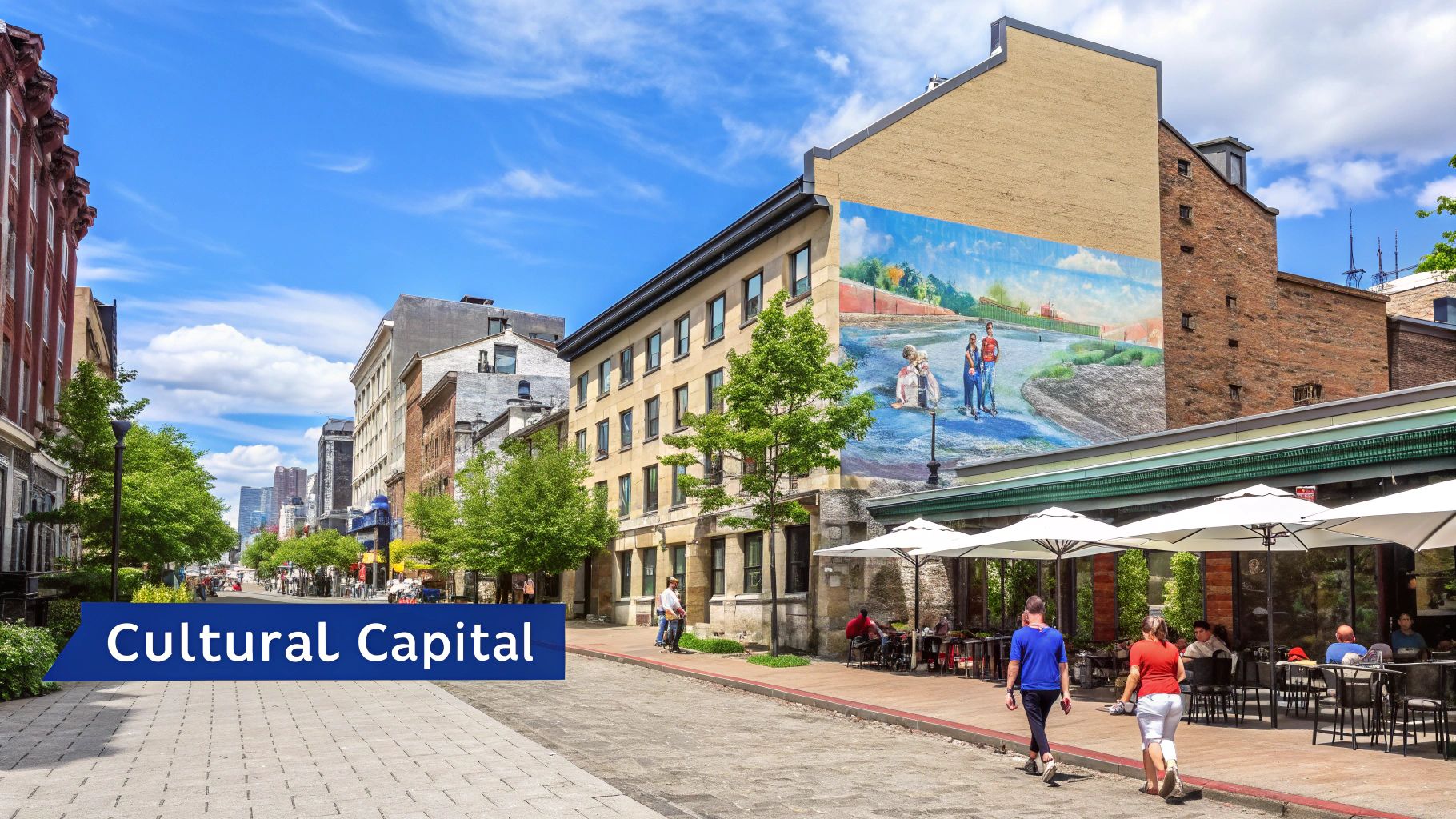
While the French language is central to life here, the city is cosmopolitan, with a growing Nigerian community adding to its diverse fabric. Montreal's blend of affordability, culture, and opportunity makes it one of the most appealing and good places to live in Canada, but only if you are willing to embrace the French language.
Why Montreal is a Top Choice
- Affordability: Enjoy a lower cost of living, particularly for rent and heavily subsidised daycare (around $10/day), which is a massive help for families with young children.
- Job Market: A global hub for artificial intelligence (AI), video game development (Ubisoft, EA), and aerospace.
- Immigration Pathways: The Quebec Skilled Worker Program (QSWP) and the Quebec Experience Program (PEQ) are primary routes. Both heavily favour candidates with French language proficiency.
Practical Tips for Newcomers
Learning French is not a suggestion; it is essential for getting a good job and integrating socially. Start taking lessons before you arrive. Look into neighbourhoods like Côte-des-Neiges, which is known for its multicultural population and has a visible Nigerian presence with accessible grocery stores and community centres.
5. Ottawa, Ontario: The Government Hub
For Nigerians who value stability, a structured career path, and a family-friendly atmosphere like Abuja, Ottawa is a compelling choice. As the nation's capital, it is the centre of the federal government, providing secure and well-paying public service jobs that are a major draw for professionals in administration, policy, and IT. Beyond government, a strong tech sector offers even more opportunities.
Often considered one of the good places to live in Canada for raising a family, Ottawa boasts a calmer pace of life, excellent schools, and plenty of green space. Its cost of living is lower than Toronto's, making it a more financially manageable major city.
Why Ottawa is a Top Choice
- Job Market: The Federal Government is the largest employer, offering stable careers. Major tech companies like Shopify and a thriving ecosystem of start-ups also provide high-demand roles.
- Family-Oriented: Known for its safety, numerous parks, and family-focused communities like Kanata and Barrhaven, making it ideal for those with children.
- Immigration Pathways: As an Ontario city, the Ontario Immigrant Nominee Program (OINP), particularly its French-Speaking Skilled Worker stream, is a key route, given Ottawa's bilingual nature. Federal Skilled Worker programs also feed directly into the city's job market.
Practical Tips for Newcomers
Bilingualism (English and French) is a huge advantage in the federal job market and will open many doors. Consider taking French lessons to boost your career prospects. To find housing, look beyond the city centre to suburbs like Orléans or Nepean for more affordable options with good transport links. The winters are very cold, so investing in proper winter clothing is essential.
6. Waterloo, Ontario: Tech Innovation Hub
Often called the "Silicon Valley of the North," Waterloo is a dynamic city that punches well above its weight in the global tech scene. For Nigerians with a background in software engineering, data science, or entrepreneurship, this city is like a focused version of Yaba, offering high-calibre opportunities without the overwhelming scale and cost of Toronto. Its innovation ecosystem, anchored by the University of Waterloo, fosters a thriving start-up culture.
This focus on technology and a more manageable cost of living make Waterloo one of the good places to live in Canada for those looking to build a career in innovation. The city is smaller and quieter than a metropolis like Lagos but offers a supportive and ambitious professional environment.
Why Waterloo is a Top Choice
- Job Market: A major hub for tech giants like Google and Shopify, alongside hundreds of start-ups constantly hiring for tech roles.
- Affordability: The cost of housing and daily expenses is significantly lower than in Toronto, allowing your salary to go further.
- Immigration Pathways: The Ontario Immigrant Nominee Program (OINP) is crucial here, especially its Human Capital Priorities stream, which frequently issues invitations to tech workers. The federal Start-up Visa Program is also popular due to the city's strong entrepreneurial support systems.
Practical Tips for Newcomers
Before arriving, connect with tech communities like Communitech, which is central to Waterloo's tech ecosystem. Attend their virtual events to start networking. The region (Kitchener-Waterloo-Cambridge) is spread out, so having a car is a major advantage for getting around, especially with a family. Focus your job search on roles that align with the city's strengths: AI, cybersecurity, and enterprise software.
7. Halifax, Nova Scotia – Atlantic Charm
For those seeking a slower, more relaxed pace of life without sacrificing career opportunities, Halifax is a refreshing choice. This East Coast city combines historic charm with a growing economy. Think of it as having the coastal vibe of Lagos Island but with a much calmer, community-focused feel and a rising tech scene.
The city's affordability, especially in housing, is a major draw, allowing newcomers to achieve a quality of life that might be out of reach in Toronto. This balance of cost and opportunity makes Halifax one of the good places to live in Canada for young professionals and families looking for community and coastal living.
Why Halifax is a Top Choice
- Growing Sectors: The city is experiencing a boom in technology, ocean sciences, and healthcare, creating strong demand for skilled workers.
- Affordability: Housing and general living costs are significantly lower than in Canada's major urban centres, meaning your money goes further.
- Immigration Pathways: The Nova Scotia Nominee Program (NSNP) has several streams, including the Occupations in Demand stream, which targets specific jobs needed in the province, offering a direct path to residency for qualified candidates.
Practical Tips for Newcomers
When looking for accommodation, consider suburbs like Dartmouth or Bedford. They offer more affordable living options and are well-connected to downtown Halifax by ferry and bus services. The Nigerian community, though smaller than in larger cities, is tight-knit and growing. Connecting with the Nigerian-Nova Scotian Association on social media before you arrive can provide invaluable support and local insights.
8. Banff, Alberta: The Mountain Paradise
For those who dream of a life far removed from the hustle of a major city, Banff offers a unique and breathtaking alternative. Nestled in the heart of the Canadian Rockies, this world-famous resort town is a paradise for anyone who loves nature, hiking, and stunning scenery. Life here is slower, centred around the outdoors and the vibrant tourism industry.

While not a typical destination for newcomers, its unique lifestyle makes it one of the more unconventional good places to live in Canada. The Nigerian community is very small, so this location is best suited for independent individuals who are drawn more to nature than to establishing a large cultural network immediately.
Why Banff is a Top Choice
- Job Market: The economy is almost entirely driven by tourism and hospitality. Jobs in hotels, restaurants, tour companies, and retail are plentiful.
- Unmatched Lifestyle: Offers world-class outdoor activities right at your doorstep. The quality of life is exceptional for nature lovers.
- Immigration Pathways: The Alberta Advantage Immigration Program (AAIP), particularly the Rural Renewal Stream and the Tourism and Hospitality Stream, provides dedicated pathways for workers in these key sectors to gain permanent residency.
Practical Tips for Newcomers
Securing housing in Banff is the biggest challenge due to strict regulations and limited supply; many jobs come with staff accommodation, which is often the best option. Focus on securing a job offer before moving, as this will be critical for both your visa and your housing situation. This town offers a truly unique Canadian experience, but it requires careful planning.
9. Victoria, British Columbia: The Garden City
For those who dream of a Canadian life without the harsh winters, Victoria is a breath of fresh air. Situated on Vancouver Island, this city is famous for its mild climate and a relaxed pace. It’s a stark contrast to the hustle of Lagos or Abuja, offering a serene environment perfect for families and individuals prioritising quality of life.
This slower, community-focused lifestyle makes Victoria one of the good places to live in Canada, especially for those in specific sectors like government and tourism. While not a major economic hub, it offers stability and a unique work-life balance.
Why Victoria is a Top Choice
- Job Market: Key sectors include provincial government, technology (nicknamed "Tectoria"), tourism, and education.
- Climate & Lifestyle: Victoria boasts some of the mildest winters in Canada, with greenery year-round. The focus is on outdoor activities like hiking and kayaking.
- Immigration Pathways: The British Columbia Provincial Nominee Program (BC PNP) is the primary route. Its tech stream is particularly relevant for IT professionals.
Practical Tips for Newcomers
Housing in Victoria is expensive. Consider looking at municipalities outside the core, such as Langford or Saanich, for better value. Since the Nigerian community is smaller here, proactive networking through platforms like Meetup and professional associations is crucial to building your circles.
10. Kitchener-Waterloo, Ontario: The Innovation Corridor
Think of Kitchener-Waterloo (KW) as a blend of Aba's manufacturing spirit and Yaba's tech innovation. These twin cities, located about an hour from Toronto, offer a unique mix of traditional industry and cutting-edge technology, making it a land of opportunity for engineers, tech professionals, and skilled tradespeople alike.
This synergy creates a dynamic job market in a region that is significantly more affordable than Toronto. For many Nigerians, KW represents a smart balance, providing access to high-quality jobs without the extreme cost of living, making it one of the most practical and good places to live in Canada.
Why Kitchener-Waterloo is a Top Choice
- Job Market: A strong base in advanced manufacturing, automotive (like Toyota), and insurance, coupled with a thriving tech ecosystem featuring companies like Google and Shopify.
- Affordability: Housing and general living costs are considerably lower than in the Greater Toronto Area.
- Immigration Pathways: As part of Ontario, the Ontario Immigrant Nominee Program (OINP), especially its Human Capital Priorities stream, is a key route for tech and skilled workers.
Practical Tips for Newcomers
To maximise your job prospects, highlight any experience in manufacturing, software development, or FinTech on your CV. The region is well-connected by GO Transit. Upon arrival, connect with settlement organisations like the YMCA of Three Rivers or the KW Multicultural Centre, which provide tailored support to help newcomers integrate smoothly.
11. Edmonton, Alberta: The River Valley City
While Calgary often gets the spotlight in Alberta, Edmonton offers a compelling, more affordable alternative. Known as "Festival City," it provides a balanced lifestyle with strong job prospects in government, healthcare, and a rapidly expanding tech scene. For Nigerians seeking a major city experience without the intense costs of Toronto, Edmonton is a hidden gem.
The city's economy is diversifying beyond oil and gas, creating opportunities in sectors like artificial intelligence and health sciences. Edmonton's affordability, especially in housing, makes it one of the good places to live in Canada for families and young professionals aiming to build a solid financial foundation.
Why Edmonton is a Top Choice
- Affordable Living: Housing and general living costs are significantly lower than in Calgary, Toronto, or Vancouver, allowing your money to go further.
- Job Market: Strong public sector employment with the provincial government, a robust healthcare system (Alberta Health Services), and a growing tech hub.
- Immigration Pathways: The Alberta Advantage Immigration Program (AAIP) offers clear pathways for skilled workers to gain permanent residency.
Practical Tips for Newcomers
Edmonton winters are cold. Investing in proper winter clothing like thermal wear, insulated boots, and a warm parka is essential from the start. Look for accommodation in family-friendly neighbourhoods like Mill Woods or the more central Oliver area. The city has a small but growing Nigerian community, which can be a valuable source of support.
12. Whistler, British Columbia: The Adventure Capital
For Nigerians with a passion for the great outdoors and a career in tourism or hospitality, Whistler offers a unique, world-renowned lifestyle. Famous for its epic ski slopes, this resort town is a hub for international tourists and adventure enthusiasts. It provides a life far removed from the hustle of a major city.
While the opportunities are specialised, for those in the right sectors, Whistler can be one of the good places to live in Canada. However, be prepared for a very high cost of living and a job market that can be seasonal.
Why Whistler is a Niche Choice
- Job Market: Primarily focused on hospitality, tourism, retail, and outdoor recreation.
- Lifestyle: Unmatched access to skiing, snowboarding, mountain biking, and hiking.
- Immigration Pathways: The British Columbia Provincial Nominee Program (BC PNP) has streams for workers in the tourism and hospitality sector.
Practical Tips for Newcomers
Securing housing before you arrive is critical, as the rental market is extremely competitive and expensive. Many jobs are seasonal, so having a financial buffer to get through the slower "shoulder seasons" (spring and autumn) is essential. Network with local businesses online well in advance.
12 Top Canadian Cities: Livability Comparison
City 🔄 Relocation complexity ⚡ Cost & housing ⭐📊 Opportunities & outcomes 💡 Ideal use cases Vancouver, BC – Pacific Gateway High 🔄: competitive job market, pricey housing market Very high ⚡: median $850k+, rent $2k–2.5k Strong tech & film jobs, high QoL ⭐⭐⭐ 📊 Global tech careers, outdoor lifestyle 💡 Toronto, ON – Economic Engine High 🔄: intense competition, long commutes Very high ⚡: median $750k+, rent $1.9k–2.2k Largest job market (finance/tech), rapid growth ⭐⭐⭐ 📊 Finance/ corporate/tech careers, urban amenities 💡 Calgary, AB – Energy City Boom Medium 🔄: industry-dependent hiring cycles Moderate ⚡: median $500k–550k, no PST Strong energy employment but volatile ⭐⭐ 📊 Energy sector jobs, mountain recreation access 💡 Montreal, QC – Cultural Capital Medium‑High 🔄: French often required for roles Lower ⚡: median $450k–500k, affordable rent Thriving arts/creative industries, good value ⭐⭐ 📊 Arts, film, students, French immersion 💡 Ottawa, ON – Government Hub Medium 🔄: stable gov’t hiring; bilingual advantageous Moderate ⚡: median $500k–550k, cheaper than Toronto Stable public sector + growing tech ⭐⭐ 📊 Public service, families seeking stability 💡 Waterloo, ON – Tech Innovation Hub Medium 🔄: tech-focused job market, university pipeline Moderate ⚡: median $550k–600k High concentration of startups & engineering talent ⭐⭐⭐ 📊 Tech professionals, founders, students 💡 Halifax, NS – Atlantic Charm Low‑Medium 🔄: smaller market, easier housing access Low ⚡: median $350k–400k Growing tech/startup scene but limited scale ⭐ 📊 Remote workers, affordable coastal living 💡 Banff, AB – Mountain Paradise High 🔄: very limited housing, seasonal jobs dominate High ⚡: median $700k+, scarce rentals Tourism-driven; limited year‑round careers ⭐ 📊 Outdoor lifestyle, seasonal/tourism employment 💡 Victoria, BC – Garden City Medium‑High 🔄: island logistics, limited career variety Very high ⚡: median $750k–800k Good for retirees, govt/tourism jobs ⭐⭐ 📊 Retirees, families seeking mild climate 💡 Kitchener‑Waterloo, ON – Manufacturing & Tech Medium 🔄: mixed manufacturing + growing tech Moderate ⚡: median $500k–550k Balanced career options; rising tech sector ⭐⭐ 📊 Manufacturing + tech careers, commuters to Toronto 💡 Edmonton, AB – River Valley City Medium 🔄: diversified but public‑sector dependent Lower ⚡: median $450k–500k Diverse jobs (gov, healthcare, emerging tech) ⭐⭐ 📊 Public sector, arts, affordable urban living 💡 Whistler, BC – Ski Resort Town High 🔄: heavily seasonal economy, limited stability Extremely high ⚡: median $1M+, rent $2.5k+ Resort/tourism jobs dominate; limited career growth ⭐ 📊 Ski professionals, seasonal workers, luxury tourism 💡 Making Your Final Choice: Match the City to Your Goals
We have journeyed across Canada, from the vibrant streets of Toronto to the stunning mountains of Calgary and the welcoming shores of Halifax. This guide has showcased a dozen of the good places to live in Canada, each offering a unique blend of opportunities and lifestyle for Nigerians. The key takeaway is this: there is no single "best" city. The right choice depends entirely on your unique aspirations, career, and family needs.
Choosing a city can feel like standing at a major roundabout in Lagos trying to pick the right exit. This guide is your map. It is crucial to move beyond what you hear on social media and dig into the details that will shape your daily life and long-term success.
Synthesising Your Options: From List to Shortlist
Your next step is to transform this list into a personal shortlist. Think of it as filtering rice; you need to separate what truly works for you. Create a simple priority list. What can you not compromise on?
- Career First: If your primary goal is a high-paying job in finance, technology, or oil and gas, be laser-focused. A tech professional should prioritise Toronto or Waterloo. An experienced petroleum engineer should be looking almost exclusively at Calgary or Edmonton, where the Alberta Advantage Immigration Program (AAIP) could be their most direct pathway.
- Affordability and Family: For those moving with family, the cost of living is a major factor. While Toronto offers opportunities, the high cost of housing is a huge burden. In contrast, cities like Halifax or Edmonton provide a much softer landing. You can secure comfortable family housing without intense financial pressure, allowing your settlement funds to stretch further.
- Lifestyle and Pace: Do you thrive in a fast-paced environment like Lagos, or do you seek a calmer life? Toronto offers the former. Cities like Ottawa or Halifax provide a more relaxed pace, where work-life balance is a reality.
Actionable Next Steps for Your Journey
Reading is the first step; action is what turns the dream into reality. Here is a practical checklist:
- Deep-Dive into PNPs: The Provincial Nominee Program (PNP) is often the most strategic route to permanent residency. Once you have a shortlist of 2-3 cities, visit the official immigration websites for their provinces. Check the eligibility criteria. Do they have a tech draw? Is your profession on their in-demand list?
- Connect with the Community: Use platforms like Facebook, LinkedIn, and Nairaland to find Nigerian community groups in your target cities. Ask practical questions: "How much is a two-bedroom flat in a decent neighbourhood in Calgary?" or "What are the best Nigerian food stores in the GTA?" These firsthand accounts are invaluable.
- Analyse Your Financials: Create a detailed, realistic budget for your first six months in each potential city. Use tools like Numbeo to compare the cost of rent, groceries, and transport. This exercise will reveal which of the good places to live in Canada truly aligns with your financial reality.
Ultimately, choosing where to live in Canada is the foundation upon which your success story will be built. It is a choice that deserves careful, strategic, and personalised consideration. By matching a city's strengths to your personal and professional goals, you are not just moving to a new country; you are setting yourself up for a prosperous future.
Navigating the complexities of visa applications and pathway requirements for your chosen city can be daunting. JapaChat simplifies this entire process by providing personalised, AI-driven guidance to help you analyse the best immigration routes and organise your documentation with precision. Get started on your journey with a clear, strategic advantage by visiting JapaChat today.
-
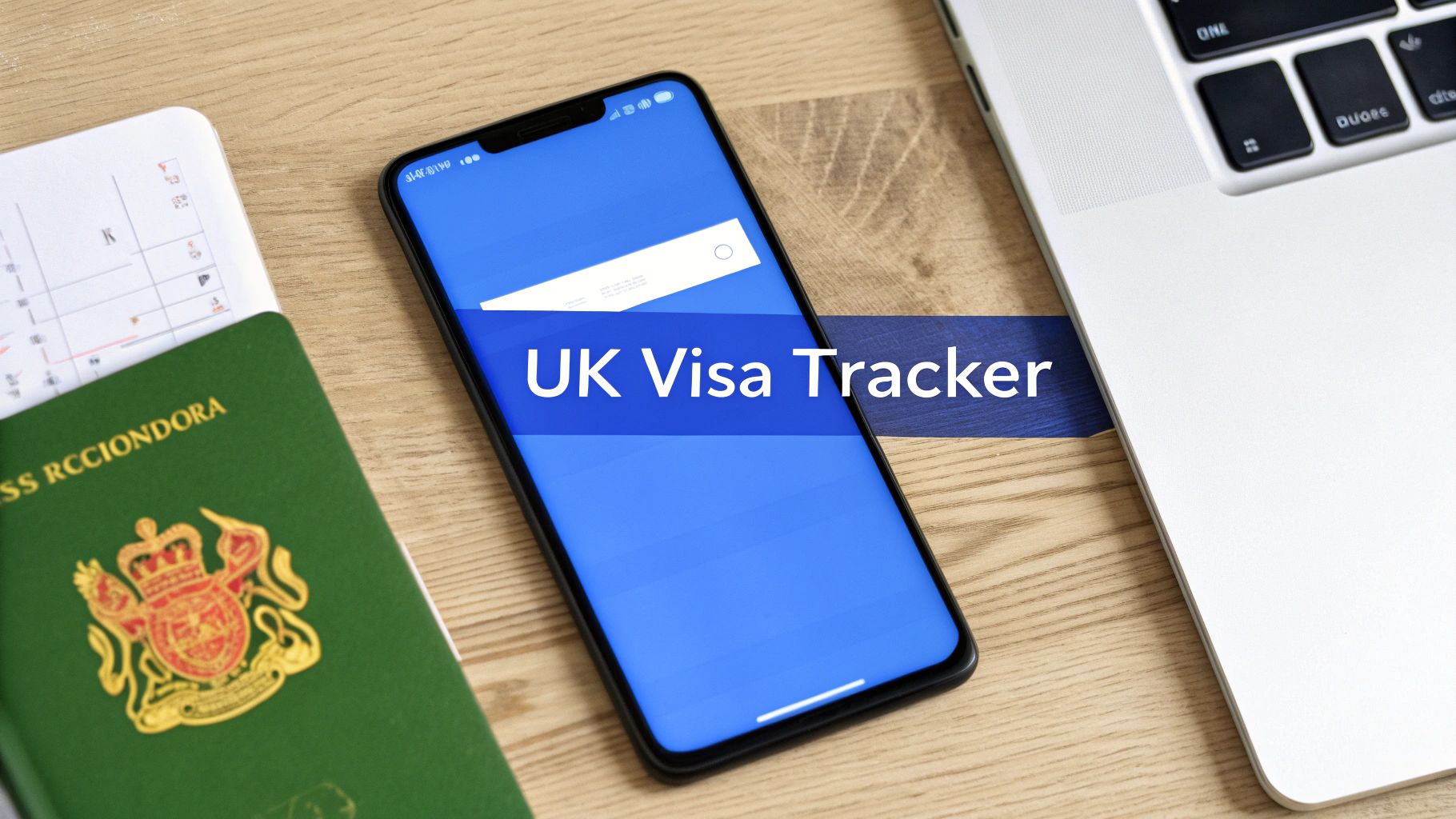
UK Visa Application Tracking: A Nigerian’s Guide to Staying Updated
Once you’ve submitted your UK visa application and your biometrics are done, the real waiting game begins. It’s a nerve-wracking period, but thankfully, you aren’t completely in the dark. You can keep an eye on your application's progress using the official GOV.UK portal or through their commercial partners in Nigeria, VFS Global or TLScontact.
To do this, you’ll need the GWF reference number you received after submitting your application online. Let’s dive into what you can realistically expect from the tracking process from Nigeria.
The Reality of Tracking Your UK Visa From Nigeria
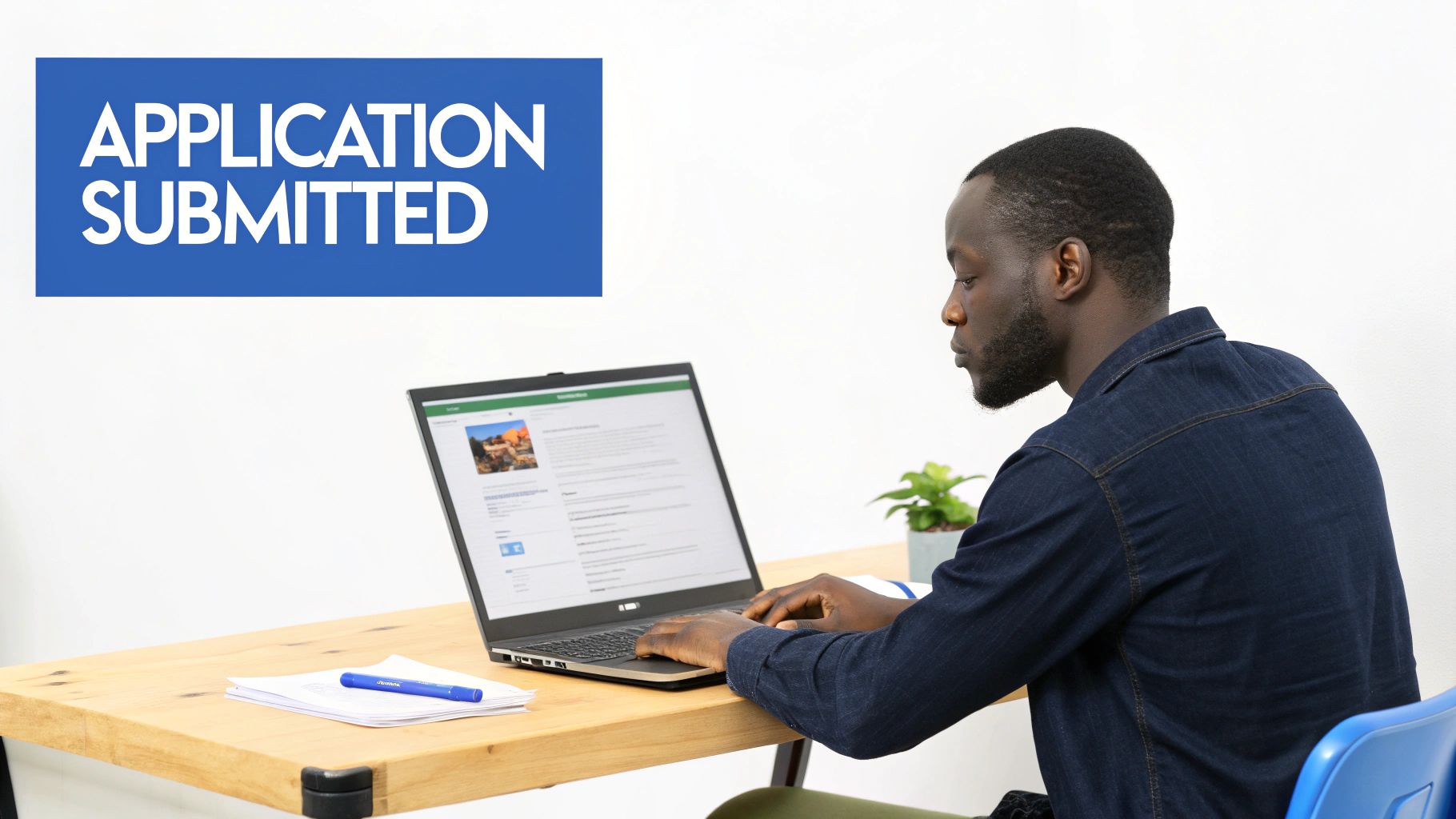
The moment you walk out of the VFS Centre in Ikeja or Abuja is a mix of relief and pure anxiety. That feeling is completely normal. The first question on every applicant's mind is, "How do I check what’s happening?" For many Nigerians, the tracking process can feel like a black box, leading to days of obsessively refreshing web pages and a whole lot of stress.
First things first, let's set some realistic expectations. Tracking a UK visa isn't like tracking a Jumia delivery with minute-by-minute updates. It’s more like a series of checkpoints. Your application moves through key stages, and you’ll only see an update when it hits a major milestone.
Understanding the Key Players
To track your application effectively, you need to know who’s handling what. Two main organisations are involved in this journey from Nigeria:
- UK Visas and Immigration (UKVI): This is the official UK government department. They are the ones who actually review your documents, check if you meet the criteria, and make the final decision on your visa. They are the decision-makers.
- VFS Global & TLScontact: Think of these as the middlemen, or the "logistics guys." They are UKVI's commercial partners in Nigeria, running the Visa Application Centres (VACs) in places like Lagos and Abuja. Their job is purely logistical: they collect your biometrics (fingerprints and photo), take your passport, and send everything securely to UKVI. They have zero say in the decision.
Understanding this difference is critical. When you check the VFS or TLScontact website, you're mostly just tracking the physical location of your passport. An update from UKVI, on the other hand, is about the decision-making process itself.
Your Most Important Tracking Numbers
After you pay and submit your application online, you'll be given a couple of reference numbers. Guard these with your life; they're your keys to getting any information.
- GWF Number (Government Web Form): This is your main application ID. It starts with 'GWF' followed by nine digits (e.g., GWF123456789). You’ll use this number most of the time you’re checking for updates.
- UAN (Unique Application Number): This is a 16-digit number that also identifies your application. It’s less commonly used for tracking but can be handy for specific enquiries.
To make things simpler, here’s a quick rundown of the essential tools and numbers you’ll be dealing with.
Your UK Visa Tracking Toolkit At a Glance
Tracking Tool What It Is What You Need Where to Find It GWF Number Your primary application reference from the UK government. GWF + 9 digits In the confirmation email after you submit your online form. UAN A 16-digit number also used to identify your application. 16-digit number In your application confirmation emails or letters. VFS Global Portal The website for the Visa Application Centre (VAC). GWF Number & your date of birth. On the VFS Global website for Nigeria. TLScontact Portal The alternative VAC website, depending on your location. GWF Number & your date of birth. On the TLScontact website for Nigeria. Having these details handy will make the process much smoother and save you from scrambling for information every time you want to check your status.
The waiting period for a UK visa is a true test of patience. The key is to understand the process and trust it. Frequent, obsessive checking won't speed up the decision but will certainly increase your anxiety.
Knowing these basics—who does what and which numbers to use—gives you a solid foundation for a less stressful wait. As you prepare, it's also smart to stay current on any policy changes that might affect your application. You can learn more about the recent https://blog.japachat.com/uk-immigration-new-rules/ to make sure you're fully prepared. This knowledge empowers you to manage your expectations and navigate the tracking process with confidence.
Where to Check Your UK Visa Application Status
Alright, you've got your GWF number and you’re mentally prepared for the wait. So, where do you actually go to get updates on your UK visa application?
It's a common point of confusion because there isn't one single, all-in-one tracker. You'll be juggling two different platforms, and it’s crucial to understand the role each one plays.
Think of it this way: the official GOV.UK website is the head office where the final decision is made. The VFS Global or TLScontact portal, on the other hand, is the local branch managing the physical paperwork and logistics. You need to check both, as they tell you different parts of the story.
The Official GOV.UK Portal
Your first port of call should always be the official UK government login you used to submit your application in the first place. This portal is your direct link to UK Visas and Immigration (UKVI)—the people who actually approve or deny your visa.
A word of warning, though: the updates here can be pretty high-level and don't happen often. You won't see every little movement. The GOV.UK portal is really only for major milestones, like when the final decision has been made. It's the most authoritative source for the decision itself, but it won't give you the play-by-play on your passport's journey.
VFS Global and TLScontact: The Day-to-Day Trackers
For anyone applying from Nigeria, the VFS Global or TLScontact websites will become your most frequently refreshed page. These companies are the official partners who run the Visa Application Centres (VACs) in places like Lagos and Abuja. Their entire job is to handle the logistics—collecting your biometrics, taking your passport, and sending everything to the right people.
This is the platform you'll use to track the physical movement of your passport. For example, an IT professional in Abuja waiting on a Skilled Worker visa would use the VFS portal to see exactly when their passport has been sent to the UKVI Decision Making Centre and, more importantly, when it’s back at the VAC ready for collection.
The VFS Global tracking page is straightforward, usually asking for your reference number and date of birth.
This simple interface is your window into the logistical side of things, showing you precisely where your documents are.
To track your application on the VFS or TLS site, you'll just need two things:
- Your GWF Number: The main reference for your application.
- Your Date of Birth: For security and verification.
A Quick Tip: Don't panic if the status on the VFS/TLS portal seems slightly out of sync with an email you get from UKVI. The VAC portal is all about logistics (where your passport is), while a UKVI email is about the decision. The two systems don't always update at the exact same second.
For instance, a master's student in Lagos might log in and see the status "Application forwarded to UKVI." This simply means their documents have physically left the VAC in Nigeria and are on their way to be reviewed. It says nothing about the outcome, only the location.
Understanding this difference is key to managing your expectations. While these platforms are specific to the UK process, you can find a broader overview of how visa statuses are generally checked in our guide on how can I check my visa status. Knowing where to look and what the information actually means is half the battle won.
What Those Vague Status Updates Actually Mean
Seeing a status update pop up on the tracking portal is one thing, but figuring out what it really means for your application is a whole other story. The language is often formal and frustratingly brief, leaving you to read between the lines. Think of this section as your personal translator for those common—and sometimes confusing—updates you'll see.
When you're refreshing that page for the tenth time in an hour, every little change feels monumental. Knowing what’s happening behind the curtain can go a long way in calming your nerves. Let's break down what these updates are really telling you.
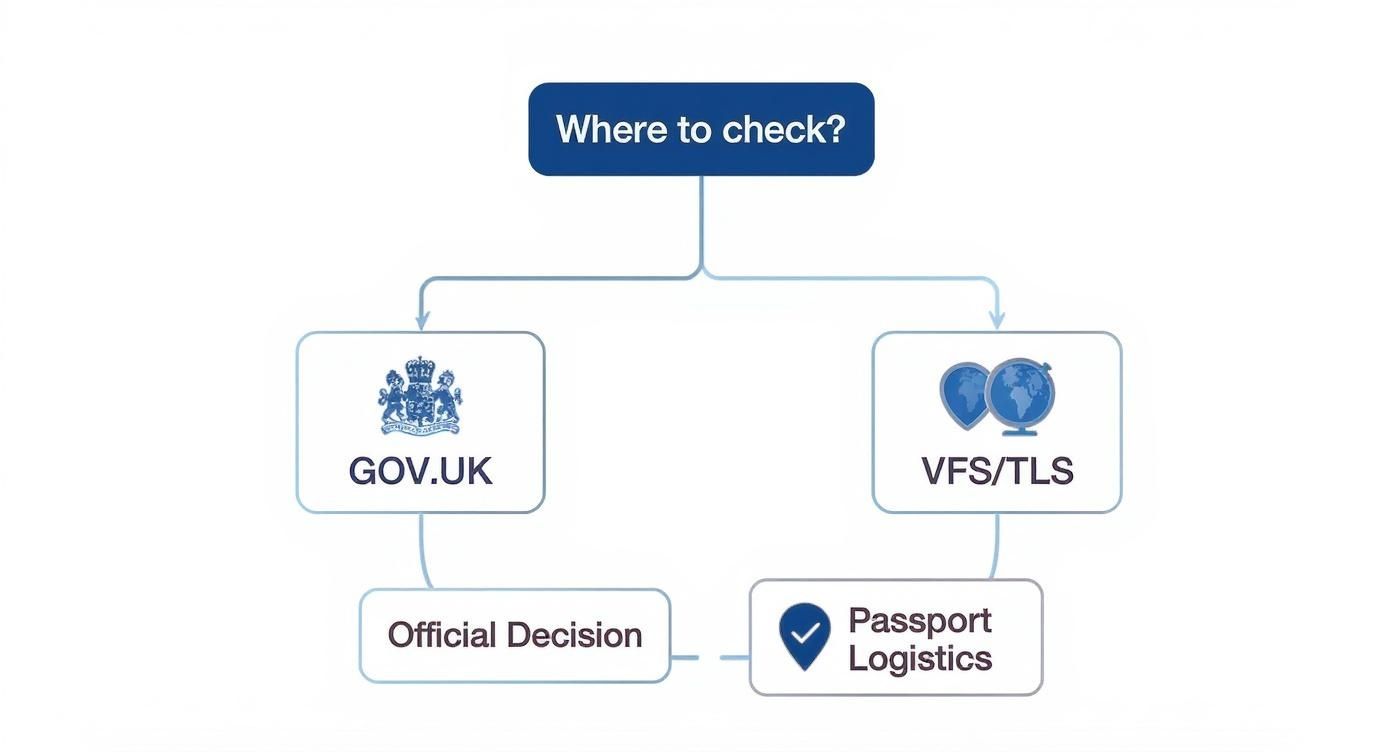
This graphic perfectly illustrates the two main tracking pathways: one for the decision itself (GOV.UK) and the other for the physical journey of your passport (VFS/TLS). They serve different purposes, but both are crucial for keeping tabs on your progress.
Common UK Visa Status Updates and Their Meanings
To make things crystal clear, I’ve put together a quick-reference table. It covers the most common messages you'll encounter on the VFS or TLScontact portals and translates them into plain English.
Status Message What It Actually Means Your Next Step Application Received by DMC Your application has safely arrived at the UK's Decision Making Centre. It's now in the queue waiting for an officer. Nothing yet. This is just a confirmation of receipt. Sit tight! Application being processed by UKVI This is the big one. An Entry Clearance Officer has your file and is actively reviewing it against the immigration rules. Patience is key here. This stage takes the longest. No news is good news. A decision has been made on your application The review is complete. This message is neutral; it does not reveal if you were approved or refused. Start checking for updates about your passport's return journey. Passport dispatched to the VAC Your passport is in transit, heading back to the Visa Application Centre where you originally applied. Prepare to collect your passport soon. This usually takes a day or two. Passport ready for collection The final step! Your passport is back at the VAC and waiting for you to pick it up. Go to the VAC with your receipt and ID to collect your passport and find out the decision. Understanding these updates helps manage expectations and reduces the anxiety of the unknown. Remember, the 'processing' stage is where most of the waiting happens.
From the VAC to the Decision Makers
The journey really begins the moment you walk out of the Visa Application Centre (VAC) in Lagos or Abuja. The first few updates you'll see are purely logistical—they're just confirming that your application is physically moving through the system.
The most important one during this phase is "Application being processed by UKVI". This is where your case is actively being assessed. It’s also the longest and most mysterious part of the process. It's completely normal for this status to remain unchanged for weeks on end.
It's during this 'processing' stage that your patience will truly be tested. Try to remember that no news is generally good news. A lack of updates doesn't mean something is wrong; it just means a thorough and detailed review is underway.
This detailed review is especially critical for popular routes like student visas. Nigerian student applications remain very high. In the year ending March 2024, Nigerians were the second-largest nationality granted study visas, receiving over 26,000 of them. This shows how competitive and thorough the process is.
The Final Stretch: Getting Your Passport Back
Once the decision is made, the updates will shift focus back to logistics, this time tracking your passport's journey back to you.
The first sign is the one everyone waits for: "A decision has been made on your application." It’s a huge milestone, but it’s strictly neutral. It doesn't give away the outcome, only that the review part of the process is officially over.
Shortly after, you should see "Passport dispatched to the VAC," which means your passport is on its way back to the VFS or TLScontact centre in Nigeria.
The final green light is "Passport ready for collection." This is your cue to head to the VAC and pick it up. Only when you open your passport will you finally see the result—either the visa vignette securely placed inside or a formal refusal letter.
Setting Realistic UK Visa Processing Timelines
Let's get straight to the biggest question on every applicant's mind: "How long is this actually going to take?" Honestly, the answer varies quite a bit. It really boils down to the type of visa you've applied for and whether you've paid for a faster service. Getting a handle on a realistic timeline from the very beginning is the best thing you can do to manage the stress and plan your next steps.
For those of us applying from Nigeria, the most common visa routes have standard processing times that give us a decent baseline. A Student visa, for instance, generally takes about 3 weeks. If you're going for a Skilled Worker visa, you're looking at a similar timeframe. The big one is the Spouse visa, which can take significantly longer—often up to a lengthy 24 weeks.
Of course, these are just the standard estimates. Your personal timeline can definitely shift, so it's smart to understand what might speed things up or slow them down.
Standard vs Priority Service
The most direct way to cut down your waiting time is to pay for a priority service at the Visa Application Centre (VAC) in Lagos or Abuja. Yes, it's an extra fee on top of your main application cost, but for many, the peace of mind and quicker turnaround are well worth it.
- Standard Service: This is the default. It follows the timelines we just talked about and is the most budget-friendly option, but it also means the longest wait.
- Priority Service: A very popular choice, especially for students and workers with a set start date. This service aims to get a decision back to you within 5 working days.
- Super Priority Service: If you're in a real time crunch, this is your go-to. It targets a next-working-day decision. It's the most expensive option by far and isn't available for every visa type.
Just remember, choosing a priority service doesn't guarantee your visa will be approved; it only guarantees a faster decision. Your application still has to meet every single one of the strict requirements.
Common Reasons for Delays
Even if you've paid for a priority service, delays can still happen. The system is always adjusting. For instance, recent UK work visa statistics show that over 182,000 work visas were issued to main applicants—a significant drop of about one-third from the previous year. This change is tied to new policies like higher salary thresholds. You can explore more of these immigration patterns on the GOV.UK website.
Several common snags can put a pause on your application's progress.
A request for more documents doesn't mean your application is weak. It simply means the case officer needs more information to make a final decision. Respond promptly and accurately to avoid further delays.
Other frequent hold-ups include applying during peak season (think the student rush from July to September) or if your case is flagged as "complex" and needs extra background checks. Knowing about these potential bottlenecks from the start helps you set a more practical timeline and can seriously reduce the daily stress of your visa application tracking UK journey.
What to Do When Your Tracking Stalls or Fails
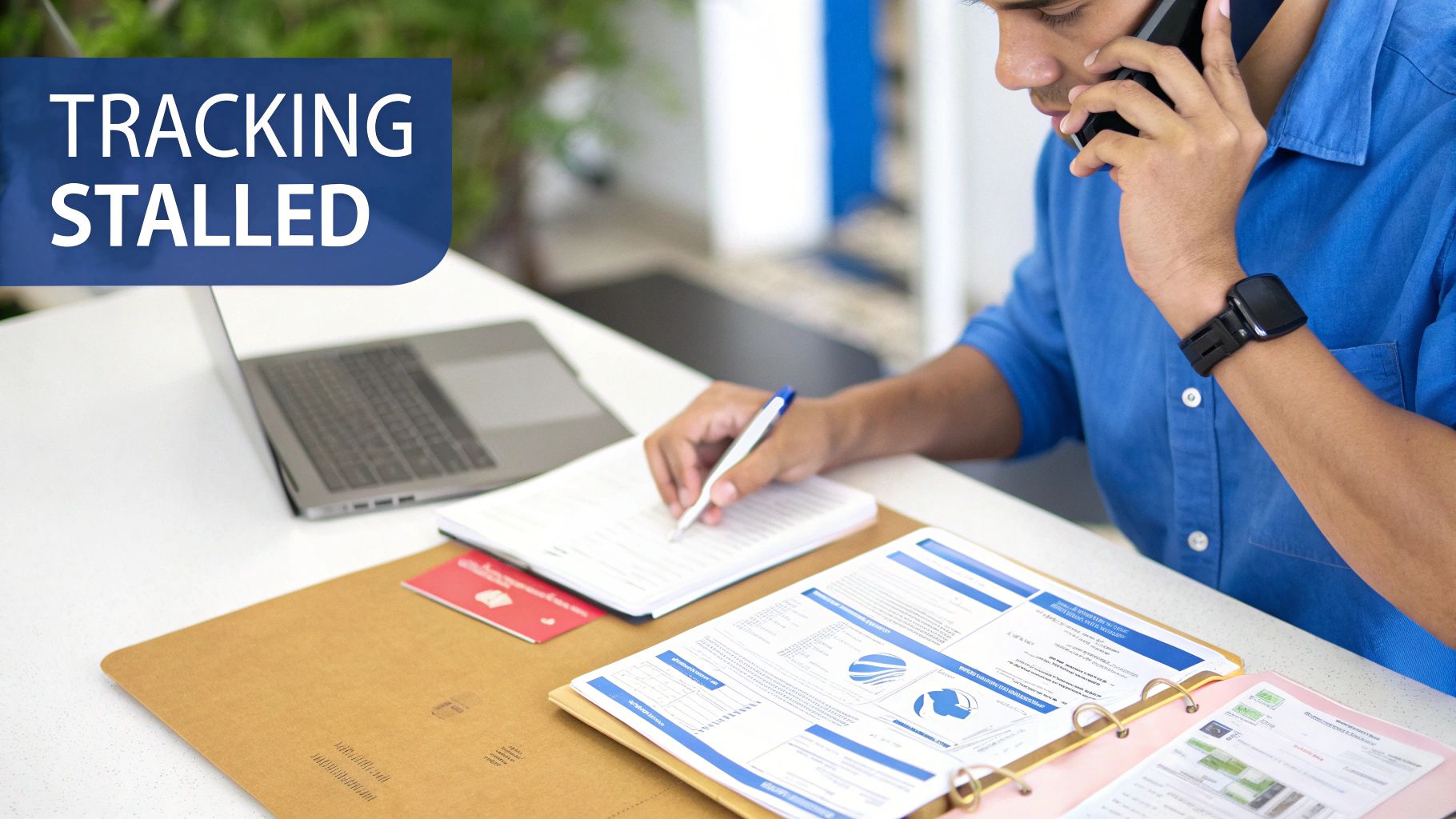
Let's be honest, the visa tracking process isn't always straightforward. It can be a real source of anxiety when things don't go as expected. What do you do when your GWF number throws up an 'invalid' error, or the status hasn't moved an inch for weeks past the standard processing time?
If you're in this boat, don't panic. You're not alone. These tracking hiccups are more common than you might think and can usually be sorted out with a bit of patience and the right steps. Here’s a breakdown of the most frequent problems applicants from Nigeria run into and what you can do about them.
When Your Status Hasn't Changed for Weeks
This is easily the number one cause of stress for visa applicants. You've blown past the usual 3-week mark for a Student visa, but the VFS or TLS portal just keeps showing that same old message: "Application being processed by UKVI."
It's natural to start thinking the worst, but a silent tracker often just means your application is sitting in a queue or undergoing routine checks. It does not automatically mean there’s a problem.
- Hold tight: First things first, give it at least 10-15 working days after the standard processing time has passed before you start raising alarms.
- Consider the season: Did you apply between July and September? That's peak student season, and delays are almost guaranteed. The system gets overloaded, and everything slows down.
"Invalid GWF Number" Error
It’s incredibly frustrating to see an "invalid" error pop up when you know you've entered the number correctly. Before you start pulling your hair out, try these simple fixes.
- Check for typos: This seems obvious, but it happens all the time. Double-check that you haven't mixed up a '0' with an 'O' or a '1' with an 'I'. To be safe, copy and paste it directly from your confirmation email.
- Give it 24-48 hours: Sometimes, the system just needs a day or two to register your GWF number after your biometrics appointment. It's not always instant.
- Use the right portal: Make sure you're on the correct VFS Global or TLScontact website specifically for Nigeria. Using a portal for a different country by mistake will definitely cause an error.
When you're facing a potential refusal, every delay feels significant. It’s helpful to understand the common visa rejection reasons so you can feel more prepared for any outcome and understand what case officers are looking for.
How to Contact UKVI for an Update
So, you've waited patiently, checked for errors, and your application is still significantly overdue. Now what? It might be time to escalate the issue. The only official way to get in touch with UKVI directly is through their paid enquiry service.
This service lets you either send an email or make a phone call to ask for an update on your application. Keep in mind that this isn't a free service—an email currently costs £2.74.
When you write to them, keep your message clear, concise, and polite. You're more likely to get a helpful response that way.
Here’s a simple template you can adapt:
Subject: Status Enquiry – [Your Visa Type] – [Your GWF Number]
Dear UK Visas and Immigration,
My name is [Your Full Name], with date of birth [DD/MM/YYYY] and passport number [Your Passport Number].
I am writing to enquire about the status of my visa application, reference number GWF123456789. My biometrics were submitted at the VAC in [Lagos/Abuja] on [Date of Biometrics].
The standard processing time for my visa category has now passed, and I would be grateful for any update you can provide on my application's progress.
Thank you for your time and assistance.
Sincerely,
[Your Full Name]
Taking this step can give you back a sense of control instead of just waiting in the dark. It’s a formal, professional way to seek answers when your visa application tracking UK journey hits a snag.
Common Questions About UK Visa Tracking in Nigeria
Even when you know all the steps, the waiting game can be tough. It's that period of uncertainty that sends everyone flocking to online forums and WhatsApp groups with the same burning questions. To save you the stress, I’ve pulled together the most common queries from Nigerian applicants and answered them straight up.
Can I Track My UK Visa With Just My Passport Number?
This question comes up all the time, but the answer is a firm no. You can't use your Nigerian passport number to check your UK visa status. The entire tracking system—both on the official UKVI side and with their commercial partners like VFS Global—is built around your GWF (Government Web Form) number.
Think of the GWF as your application's unique ID. It’s the only key that unlocks any information about where your application is in the process. Keep it safe and handy.
My Tracking Status Hasn't Changed in Weeks. Is Something Wrong?
Seeing the same status for what feels like forever is easily the most nerve-wracking part of the whole process. But honestly, it's usually nothing to worry about. Most applications will show a status like "Application being processed by UKVI" for the vast majority of the waiting period.
No news is genuinely good news here.
A silent tracker doesn’t mean a forgotten application. It simply means the Entry Clearance Officer is methodically working through their caseload. You should only start getting concerned if the processing time has gone well beyond the standard waiting period for your visa category.
Does "A Decision Has Been Made" Mean My Visa Is Approved?
Not at all. This status is completely neutral and gives zero indication of the outcome. It just means the official assessment is over and a conclusion has been reached—that's it.
You won’t know if your visa was approved or refused until you have your passport back in your hands. If it's a yes, the visa vignette will be inside. If it's a no, you'll receive a formal refusal letter explaining why. The staff at the Visa Application Centre are kept in the dark, so they can't tell you the decision either.
As you navigate the application process, you might have various questions beyond just tracking your application. For instance, many applicants often inquire about the associated UK Study Visa Fees.
What’s the Difference Between the GOV.UK and VFS Global Portals?
It helps to think of them as two different departments handling your case. The GOV.UK site is the head office where the official decision is made, while the VFS or TLScontact portal is the local logistics team managing the paperwork.
- GOV.UK: This is where you see the official status of your application with the UK government. Updates here are rare but are the most important ones.
- VFS/TLScontact: This tracks the physical journey of your passport. It tells you when it has been sent to the decision-making centre and when it's back at the VAC ready for you to collect.
They both give you different pieces of the puzzle, and together, they paint a full picture of your visa tracking journey.
Navigating the maze of UK immigration rules can feel overwhelming, but you're not on your own. For quick, reliable answers about visa routes, documents, or planning your move, check out JapaChat. Get the clarity you need to move forward with confidence by visiting https://japachat.com and signing up for free.
-
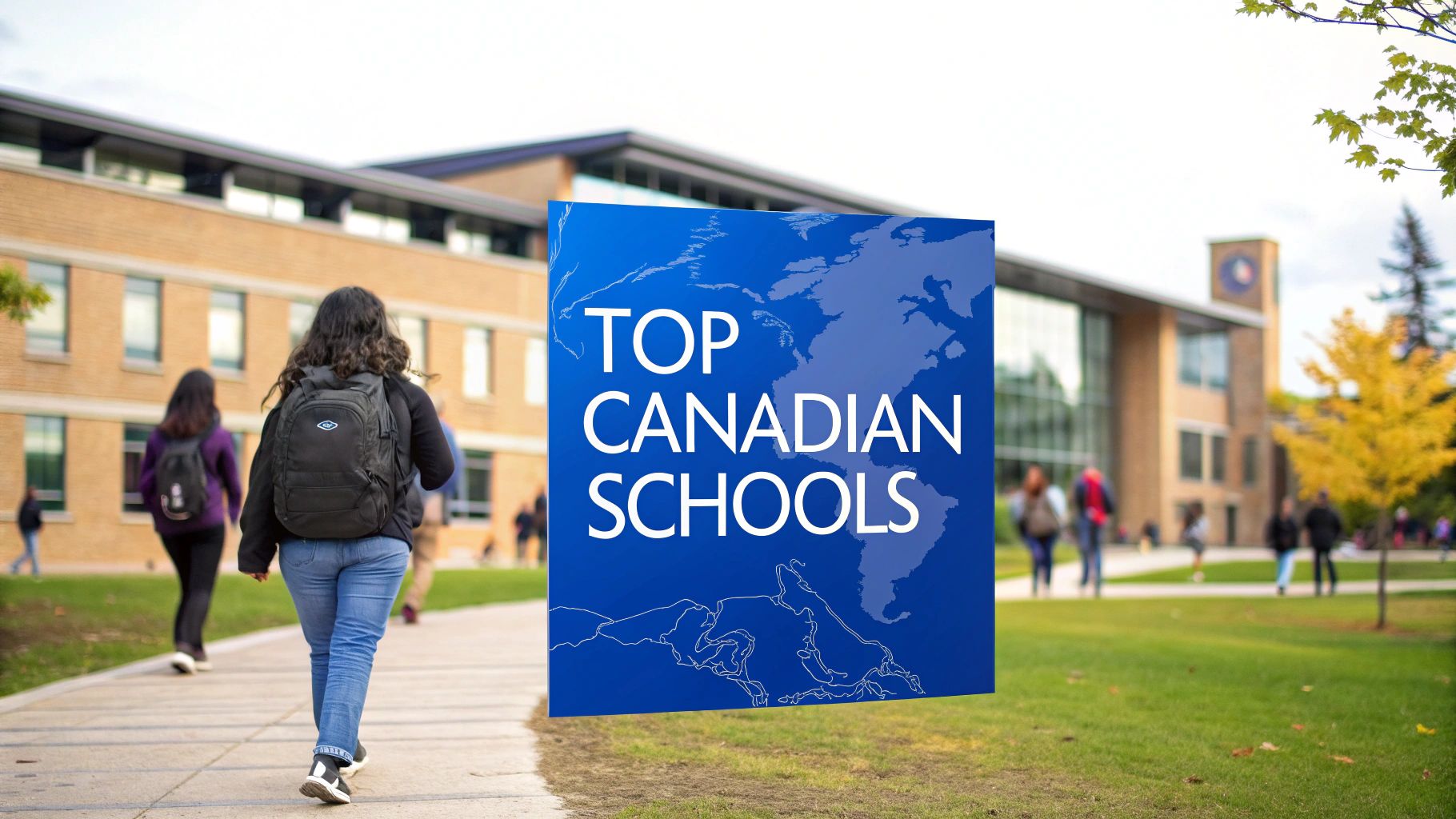
Top Schools in Canada for Nigerian International Students Guide
When Nigerian students weigh up universities, colleges, vocational schools or pathway programmes in Canada, the decision often comes down to how each option maps to your background and career goals. Graduates from Lagos Polytechnic may favour hands-on skills in digital finance, while medical school hopefuls in Abuja target research-intensive MD tracks. This guide uses practical examples from Nigeria—like fintech scenarios inspired by Jumia and Konga—to help you find the best fit.
Understanding Your Canadian Study Options
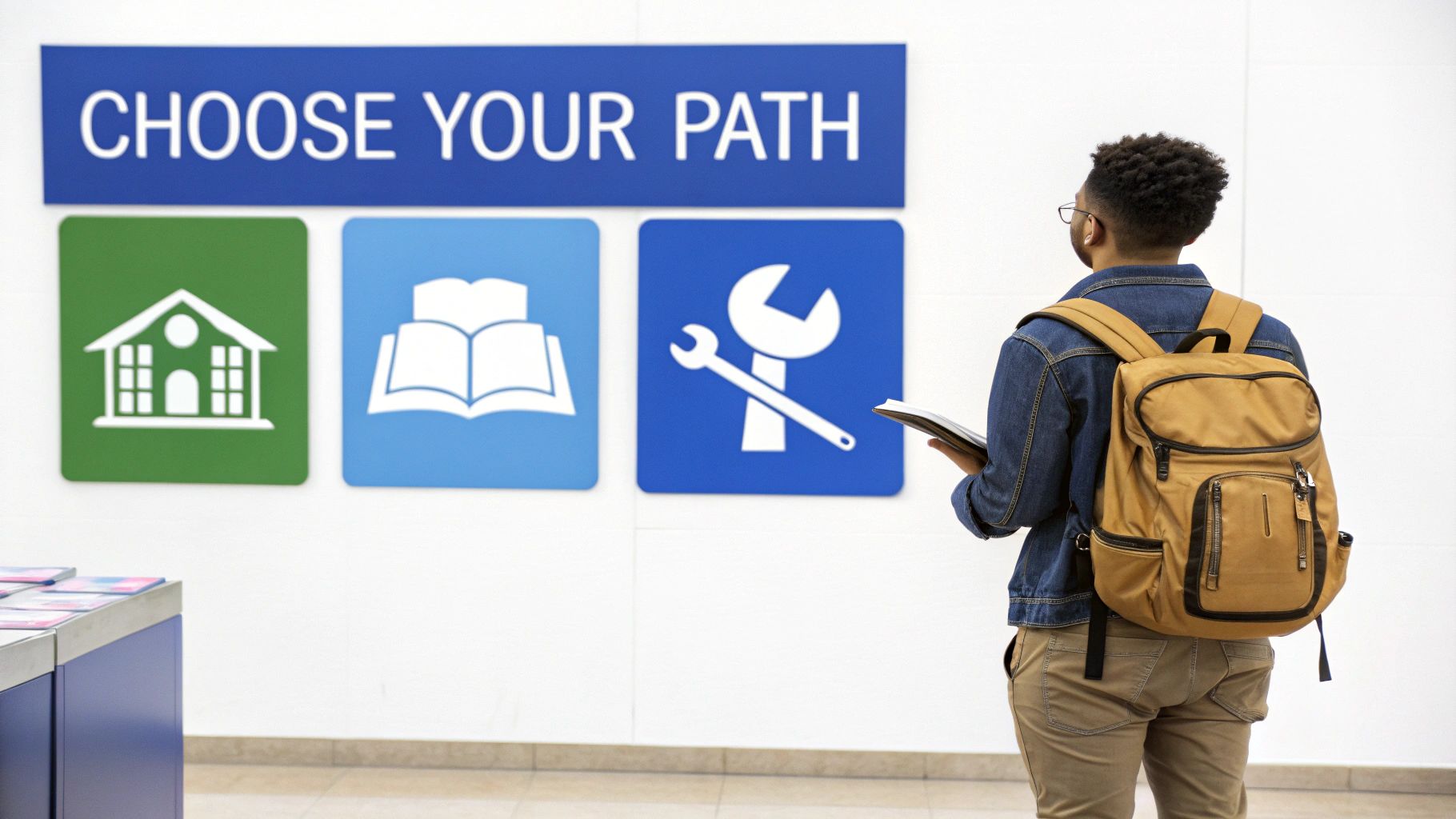
Canada offers four main pathways:
- University Programmes: Deep dives into theory and research—ideal for medicine, engineering and data science.
- College Diplomas: Blend classroom work with co-op placements; perfect for applied careers like digital finance or hospitality management.
- Vocational Schools: Fast-track training in trades—welding, electrical work or culinary arts—in as little as six months.
- Pathway Programmes: Bridge courses and IELTS support, smoothing entry into full degrees.
University Programmes And Academic Depth
University study in Canada feels like exploring an ocean of ideas. Over 3–4 years, you’ll tackle lectures, labs and research projects. For example, medical aspirants complete four years of MD rotations at teaching hospitals similar to UNTH or UCH in Nigeria, preparing for licensure and global practice.
College Diplomas And Practical Training
Colleges focus on real-world skills. In a digital finance diploma, you might work on Lagos-inspired fintech case studies, partnering with local branches of Zenith Bank or GTBank. Hospitality students gain on-site experience at Canadian resorts, much like an intern placement at Radisson Blu in Lagos. To sharpen your quantitative edge, see how to study math effectively.
University = deep-sea theory; College = a sturdy raft you can jump onto day one.
Institution Type Primary Focus Typical Programme Length Credential Awarded University Theory, research 3–4 years Bachelor’s degree College Applied skills, co-ops 1–3 years Diploma or certificate Vocational School Trades and hands-on Months to 1 year Certificate Pathway Programme Language and bridging 4–12 months Entrance qualification Pathway Programmes For Smooth Transitions
If you need extra English support, consider a six-month bridge course in Toronto. After hitting required grades, you transfer credits into a BBA or engineering programme—similar to foundation years at YabaTech, but in Canada.
Choosing Based On Career Goals
- Research-driven: engineering, sciences → University
- Applied skills: digital marketing, culinary arts → College/Vocational
- Test the waters: language or foundation courses → Pathway
Balance your ambition with application steps and visa requirements next.
You may also want to consult our guide on the cheapest universities for international students in Canada to compare cost and quality.
Navigating Recent Immigration Policy Changes
New federal caps on study permits in 2024 mean Nigerian applicants must be strategic. Think of policy shifts like Nigeria’s exchange rate—volatile, but navigable with the right plan.
The Federal Cap On Study Permits
From January 2024, Canada limited new permits to balance enrolment. Atlantic provinces saw a 28% drop (6,431 students) in 2025. Manitoba’s decline was 5.4%. Read more at Global News.
Workarounds:
- Target programmes with higher intake caps—engineering tech or data analytics.
- Achieve standout scores: IELTS 7.5+ or TOEFL 100+.
- Highlight leadership in Nigeria: school clubs, community hackathons.
- Explore pilot streams like Nova Scotia’s International Graduate Stream.
Leveraging Provincial Initiatives
Provinces offer nominee programmes to attract talent. B.C. and Saskatchewan expanded STEM seats, while Ontario prioritises digital finance diplomas.
Key Insight: Provincial streams can be a lifeline when federal slots are tight.
- Research provincial nominee requirements for your field.
- Contact each DLI’s international office for current intake numbers.
- Prepare extra proof of funds: GIC plus scholarship or sponsorship letters.
Tips For Nigerian Students
- Apply early—before August—to beat the cap and Naira dips.
- Tailor your SOP to Canada’s labour market and Nigeria’s growing fintech scene.
- Join online webinars with alumni from your province of choice.
- Connect with current Nigerian students for cost-of-living hacks in Naira and CAD.
- Keep backup options in at least two provinces.
Healthcare tech, AI and data analytics remain high-demand sectors. Show visa officers you’ve done your homework.
Case Study Of A Successful Nigerian Student
Anita from Lagos applied to Vancouver Island University for digital finance. She showcased a Zenith Bank internship and led her school’s coding club in Abuja. Using JapaChat tools, she secured B.C.’s STEM Graduate Extension and starts January with a funded research assistantship.
Strengthening Your SOP And Interviews
A compelling SOP weaves in your Nigerian experiences—like coordinating a fintech hackathon in Abuja. For visa interviews at the Canadian High Commission in Abuja, practise concise answers about your study plan and funding. JapaChat’s mock interview feature builds confidence.
Managing Financial Requirements
Canada requires proof of CAD 10,000 living funds plus tuition. Nigerian banks (e.g., GTBank) partner with Canadian banks on GICs. Convert expenses to Naira—CAD 10,000 ≈ ₦4 million—to plan effectively.
Province Key Initiative Eligible Fields Nova Scotia International Graduate Stream Engineering, IT Saskatchewan Tech Talent Pathway Data Analytics, Bioscience Ontario Digital Economy Priority Intake Finance, Marketing British Columbia STEM Graduate Extension Environmental Science, AI Tap into these regional schemes and ride policy shifts to your advantage.
Selecting The Best Canadian School For Your Goals
Choosing a Designated Learning Institution (DLI) is crucial—only DLIs qualify for the Post-Graduation Work Permit (PGWP). Next, find a programme that links your Nigerian network to Canadian and global jobs.
- DLI Status: Check IRCC’s official list before you apply.
- Program Fit: Match your Lagos background—fintech, oil & gas or agriculture—with Canadian strengths.
- Lifestyle: Big cities like Toronto cost more (rent
CAD 2,000/month) versus Fredericton (CAD 700). - Support Services: Mentorship, cultural clubs (Nigerian Students Association) and career centres.
Evaluating DLI Status And PGWP Eligibility
If a campus isn’t on the IRCC list, you can’t get a PGWP. Ade compared the University of Toronto (tuition ~CAD 60,000) with Northern Alberta Institute of Technology (NAIT, ~CAD 25,000 including paid co-ops).
Key takeaway: Alberta Polytechnic’s CAD 25,000 fee plus CAD 15,000 in co-op earnings offered a clear ROI.
Matching Program To Nigerian And Global Job Markets
At a Lagos job fair, alumni from your chosen Canadian programme can fast-track hires. Software engineering, data analytics and renewable energy are hot both at home and in Canada.
- Alumni Network: Identify Nigerians working in Toronto’s fintech hubs.
- Industry Ties: Leverage partnerships—McGill’s green-tech labs or U of T’s finance incubator.
- Co-op Earnings: NAIT students earn CAD 15,000+ across three terms.
- Employment Rate: Look for schools with 85% of grads employed within six months.
Lessons From A Growing University
The University of New Brunswick (UNB) boosted enrolment by 10% in 2025 through online courses and stronger student services. Read more on tj.news.
Considering Campus Life And Support Services
Toronto’s hustle comes with a higher price tag; Fredericton offers a tight-knit community and lower living costs. Look for:
- Nigerian Clubs celebrating Independence Day and Eyo festivals.
- Career Centres with resume workshops and employer mixers.
- Health Services with accessible mental-health support.
Balancing Costs, Co-op And Future Employability
School Type Tuition Range Co-op Earnings University CAD 40,000+ Optional paid Polytechnic CAD 20,000–25,000 Mandatory paid Polytechnic fees often sit under CAD 25,000, but include paid placements. Research universities cost more yet bolster your resume for grad school or global roles. Ade chose a CAD 22,000/year programme with three paid rotations worth CAD 12,000 total.
Putting It All Together
- Verify DLI status, fees and visa-approval stats.
- Match programmes to your Nigerian network and interests.
- Compare support, lifestyle and co-op potential.
- Join virtual info sessions and alumni Q&As for real-world insights.
Final Tips And Considerations
Remember Canada’s climate: Manitoba winters can dip below −30 °C, while Vancouver stays above 0 °C. Return flights Lagos–Toronto run around USD 1,500.
- Join Nigerian student groups for home-style gatherings.
- Check part-time work rules (20 hrs/week) to help cover living costs.
Demystifying the Application And Visa Process
Applying from Nigeria involves multiple steps. Your starting point is an acceptance letter from a Designated Learning Institution (DLI)—your golden ticket for a study permit.
- Document Prep: Have transcripts evaluated through WES and secure certified translations.
- Language Tests: Target IELTS 7.5+ or TOEFL 100+ using tailored study plans.
- References: Two academic and one professional referee strengthen your profile.
- Proof of Funds: Open a GTBank–RBC GIC for CAD 10,000 and show tuition deposit receipts.
- SOP: Craft a narrative linking your Lagos or Abuja roots to Canadian ambitions.
Check Canada eTA requirements for visa-exempt travel before booking flights.
Creating A Strong Statement Of Purpose
Frame your SOP as a story: cover your Nigerian education milestones, leadership in community projects, and specific reasons for choosing your DLI and programme.
Understanding Proof Of Funds Requirements
Canada requires a GIC of at least CAD 10,000 plus tuition deposit evidence. Nigerian banks often partner with Canadian banks for GICs; convert CAD to NGN (≈₦4 million) to prepare.
Building Your Checklist
Plan 12 months ahead for a September intake:
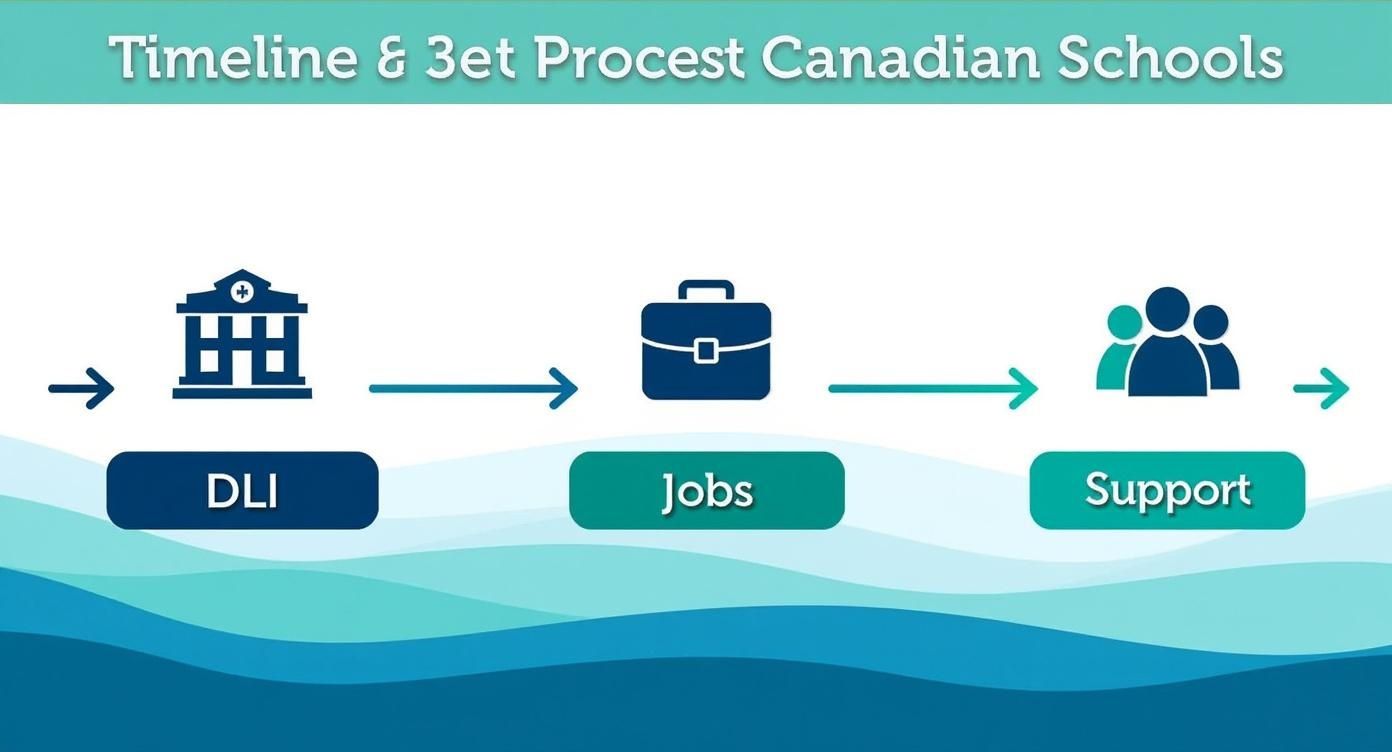
Timeframe (Before Sept Intake) Key Task Note for Nigerian Applicants 12 Months Research DLIs and programmes Confirm accreditation 10 Months Send transcripts to WES Allow 2–4 weeks 8 Months Book IELTS/TOEFL Aim for IELTS 7.5+ or TOEFL 100+ 6 Months Open GIC (CAD 10,000) and pay tuition deposit Use GTBank partnership 4 Months Draft SOP and collect references Two academic + one professional letter 2 Months Submit visa application on IRCC portal Double-check uploads 1 Month Finalise travel plans and attend biometrics Keep support letters at hand Preparing For Your Visa Interview
Interviews are held at the Canadian High Commission in Abuja or Lagos VAC. Arrive early, avoid peak traffic, and practise:
- Reason for choosing Canada/province/programme
- Explanation of your GIC, scholarship or sponsorship
- Ties to Nigeria: family, property, future job prospects
- Post-study intentions in Nigeria or Canada
Final Visa Submission Tips
Before submitting, cross-check every field with original documents. Monitor your status online and respond to any IRCC requests promptly. For more details, see our guide on Canada student visa requirements.
Managing Costs And Finding Scholarships
Balancing tuition, accommodation, meals and transport is key. University fees: CAD 30,000–55,000; college: CAD 15,000–30,000; vocational: CAD 5,000–15,000; pathway: CAD 10,000–20,000.
Budgeting For Accommodation And Living Costs
- Toronto rent (shared): CAD 1,200 (~₦480,000)/month
- Winnipeg rent: CAD 600 (~₦240,000)/month
- Transit pass: CAD 110 (~₦44,000)/month
- Groceries: CAD 250 (~₦100,000)/month
- Health insurance: CAD 600 (~₦240,000)/year
Work up to 20 hrs/week term-time and full-time on breaks.
Key Scholarships For Nigerian Students
Scholarship Name Amount (CAD) Eligibility Nigeria-Canada Merit Award 2,000–5,000 Nigerian STEM undergraduates Commonwealth Shared Scholarship 5,000–15,000 African postgraduates Graduate Teaching Assistantship 10,000–20,000 Postgraduate research assistants Combine a CAD 5,000 scholarship with co-op earnings to slash expenses.
Practical Money Management Hacks
- Track daily spend with apps like Mint or Spendee
- Cook jollof rice in bulk and share costs with roommates
- Open a no-fee student bank account (e.g., Scotiabank Student Banking)
- Shop at local farmer’s markets for produce discounts
- Note flash sales and student-only discounts in your calendar
Case Study Of A Lagos Student
Bola shared a two-bedroom flat in Montreal, paying CAD 600 each (≈₦240,000). She cooked and sold portions of jollof rice for CAD 5, earning CAD 200/month. With a CAD 1,500 bursary and weekend gigs, her textbooks and groceries were fully covered.
Visit JapaChat to get personalised cost estimates and scholarship matches.
Planning Life After Graduation And PR Pathways
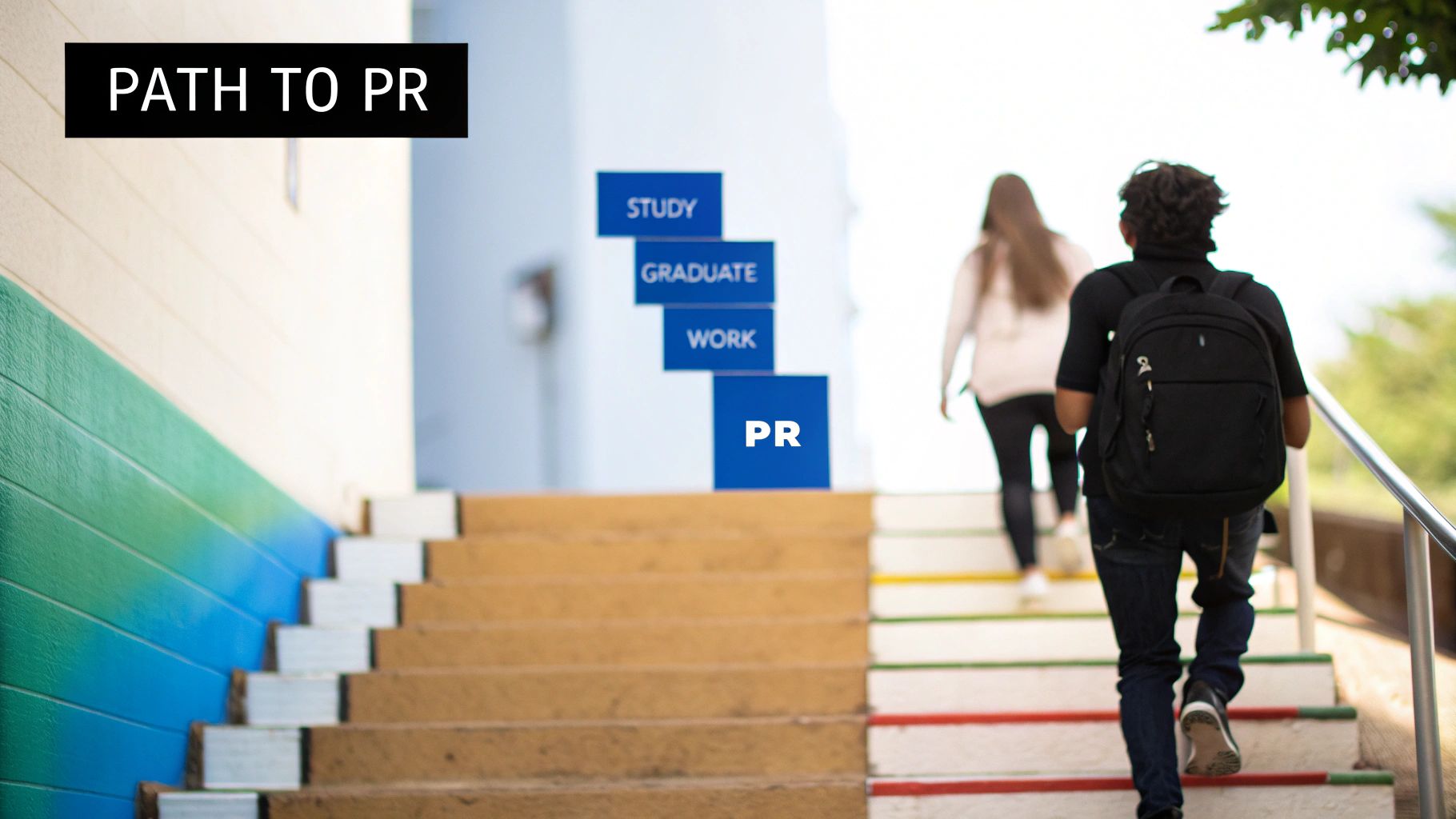
The Post-Graduation Work Permit (PGWP) is your bridge from student to worker—and eventual permanent resident.
Qualifying For The PGWP
- Full-time enrolment at a PGWP-eligible DLI
- Programme length ≥ 8 months
- Apply within 180 days of graduation
“Your PGWP duration equals your programme length—up to three years,” says JapaChat advisor Ifeoma.
Transitioning To Express Entry
After 12 months of skilled work on your PGWP, apply through Canadian Experience Class (CEC):
Stage Criteria Create Profile Submit Express Entry profile Work Required 12 months of skilled Canadian work Language CLB 7 in IELTS or approved alternative CRS Score Points for Canadian education and work A provincial nomination can add 600 points—nearly a guaranteed Invitation to Apply (ITA).
Strategic Programme Choices
- Choose a 24-month diploma for a 36-month PGWP
- Include paid co-op terms for income and references
- Keep records of work hours and request employer letters
- Target provinces with graduate streams
Read our Canada Post-Graduate Work Permit guide for details.
Case Study Of A Successful Nigerian Graduate
Bimbo from Lagos chose a three-year engineering degree in Manitoba. She applied for her PGWP first day her transcript arrived. After 12 months of work and CLB 8 in IELTS, she scored 475 CRS points and received an ITA under CEC.
Putting It All Together
Plan your journey: Study ▶ Graduate ▶ PGWP ▶ Work ▶ PR. Each step—academic results, work letters, language tests—bolsters your Express Entry profile.
Frequently Asked Questions
Q1: Can I Bring My Family on a Study Permit?
Yes. Include your spouse and children in your application. Spouses often get open work permits; children get study permits. Show proof of relationship, tuition deposit and CAD 10,000 per dependant. Expect 2–4 months processing.
Q2: Should I Use an Education Agent?
Agents can help but watch out for high fees and scams. To verify:
- Check Nigerian Council for Education Agents registration
- Read genuine student reviews
- Compare fee structures and refund policies
Q3: Which Courses Lead to Jobs?
Tech, healthcare, data analytics and skilled trades have high hire rates in Canada and Nigeria. For instance, nursing diplomas include co-ops; data analytics grads link to Lagos fintech.
Q4: How Soon Should I Start the Application?
Begin 12 months before your intake. This gives you time for research, WES evaluation, language tests and visa filings without stress.
Ready to streamline your move to Canada?
Get personalised guidance at JapaChat -
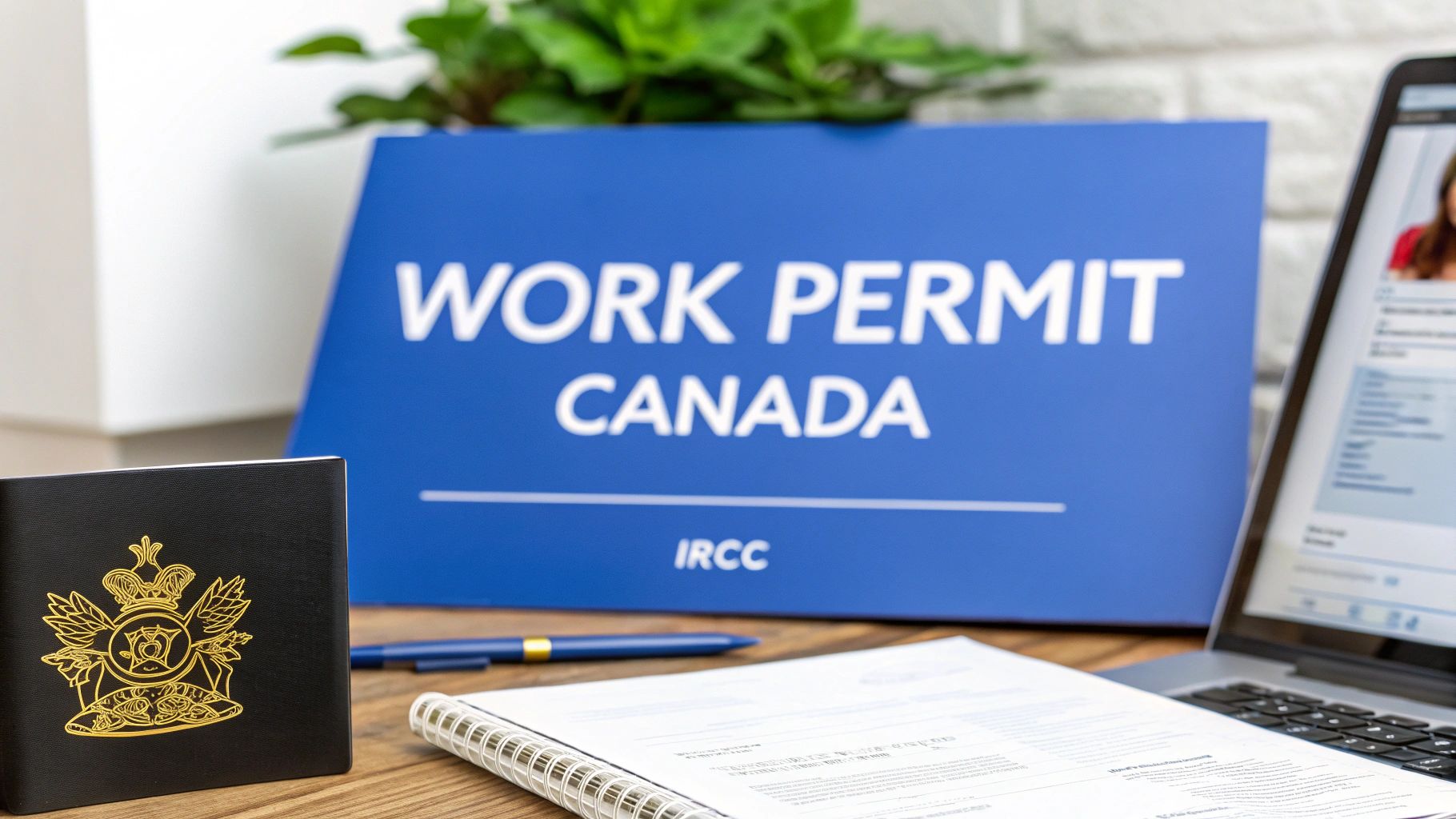
A Nigerian’s Guide to a Canadian Work Permit Application
So, you're ready to start your Canadian work permit application. Excellent. The very first step is figuring out which path makes the most sense for you, and honestly, this decision will shape your entire journey.
You're basically at a crossroads with two main routes ahead: the Employer-Specific Work Permit and the more flexible Open Work Permit. Getting this choice right from the start is critical.
Your Canadian Work Permit Options
Think of it this way. Choosing your work permit is a bit like planning your career back home in Nigeria. Do you take a secure, permanent role with a big company like MTN in Lagos, or do you go the freelance route in Abuja, where you have more freedom to pick and choose projects? Both are great options, but they suit different people and different situations.
That's the core difference here. One path gives you a direct, guaranteed job but ties you to a single employer. The other gives you the freedom to explore the Canadian job market, but getting one in the first place is a bit more restricted.
This infographic lays out the two main pathways pretty clearly.
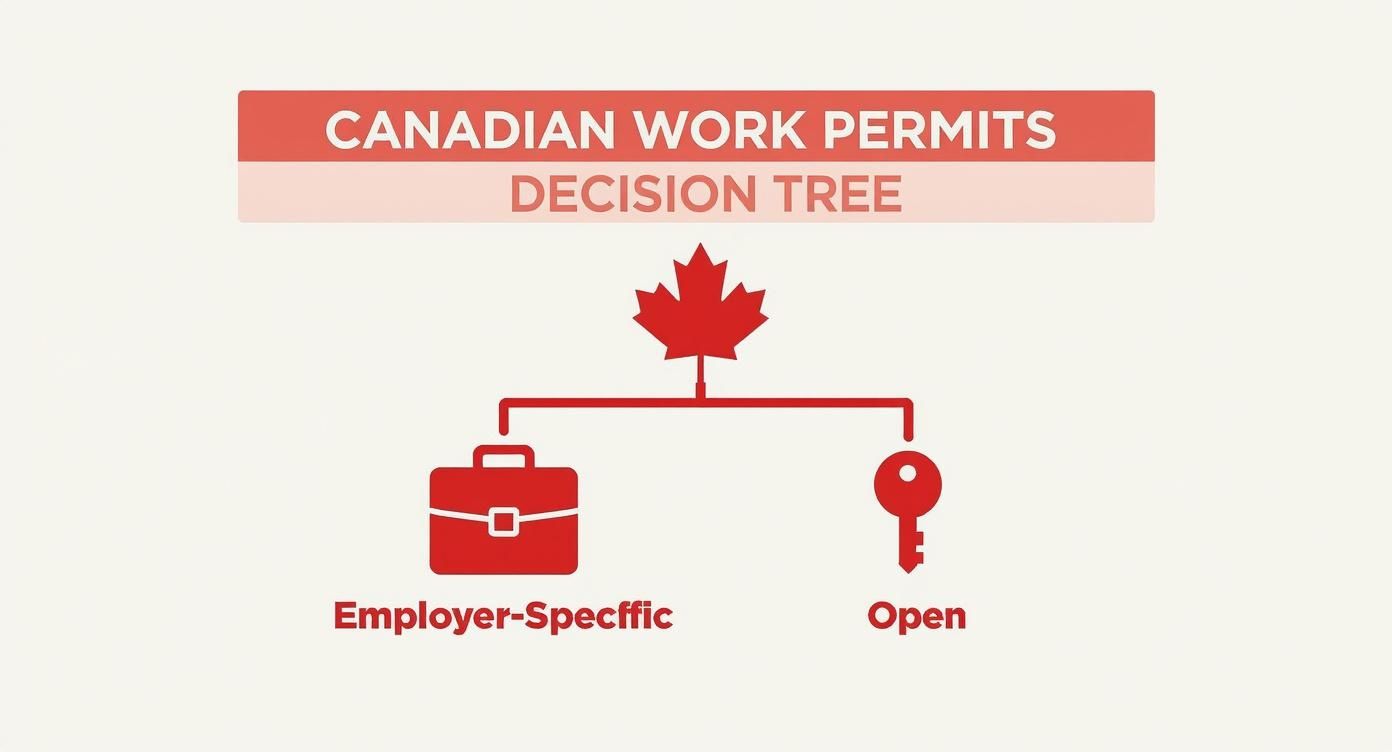
As you can see, your personal situation—whether you have a job offer, your spouse's status, or if you've studied in Canada—is what will point you in the right direction.
To make this even clearer, let's break down which permit is right for whom. This table gives you a quick side-by-side comparison to see where you fit.
Employer-Specific vs Open Work Permit Which Path Is for You?
Feature Employer-Specific Work Permit Open Work Permit Main Requirement A valid job offer from a Canadian employer. Must meet specific eligibility criteria (e.g., spouse of a worker/student, recent graduate). Employer Role The employer is heavily involved and usually needs an LMIA. No specific employer is needed to apply. You're on your own. Job Flexibility Low. You can only work for the employer named on the permit. High. You can work for almost any employer in Canada. Who It's For Professionals from Nigeria with a confirmed job offer. Spouses, partners, and eligible graduates already in or connected to Canada. Best Scenario You've landed a great job and the company is ready to support your move. You need the flexibility to find work after arriving or graduating. Ultimately, if you have a job offer in hand, the Employer-Specific route is your most direct path. If you qualify through other means, the Open Work Permit offers incredible freedom.
The Employer-Specific Permit A Direct Path
This is the most common route for skilled professionals applying directly from Nigeria. It’s straightforward: your permit literally has the name of your employer, your job title, and your work location printed on it. You can't just decide to go work for someone else.
The biggest hurdle here is usually the Labour Market Impact Assessment (LMIA). Your Canadian employer has to get this document from the government to prove they couldn't find a Canadian citizen or permanent resident for the job. It's a process that can take months and involves a lot of paperwork on their end, so you need a committed employer.
Key Takeaway: The Employer-Specific Work Permit offers security because you land with a job already waiting. But it locks you in. This is the perfect fit if a Canadian company has already offered you a position and is willing to go through the LMIA process for you.
The Open Work Permit Freedom and Flexibility
Now, this is the permit everyone wants. An Open Work Permit gives you the freedom to work for nearly any employer, anywhere in Canada. You can change jobs, work two part-time gigs, or take a short-term contract without ever having to re-apply for a new permit.
The catch? Not everyone can get one. It’s not something you can just apply for out of the blue.
Eligibility is usually restricted to very specific situations. You might qualify if you are:
- The spouse or common-law partner of a skilled worker or an international student in Canada.
- An international student who just graduated from an eligible Canadian university or college. We have a detailed guide on the Canada Post-Graduate Work Permit that covers this in-depth.
- A holder of a temporary resident permit.
This permit is a game-changer for those who qualify. It lets you dive right into the job market and grab opportunities as they pop up, giving you the kind of flexibility many of us are used to in Nigeria's dynamic work environment.
Getting Your Documents in Order: Your Essential Checklist
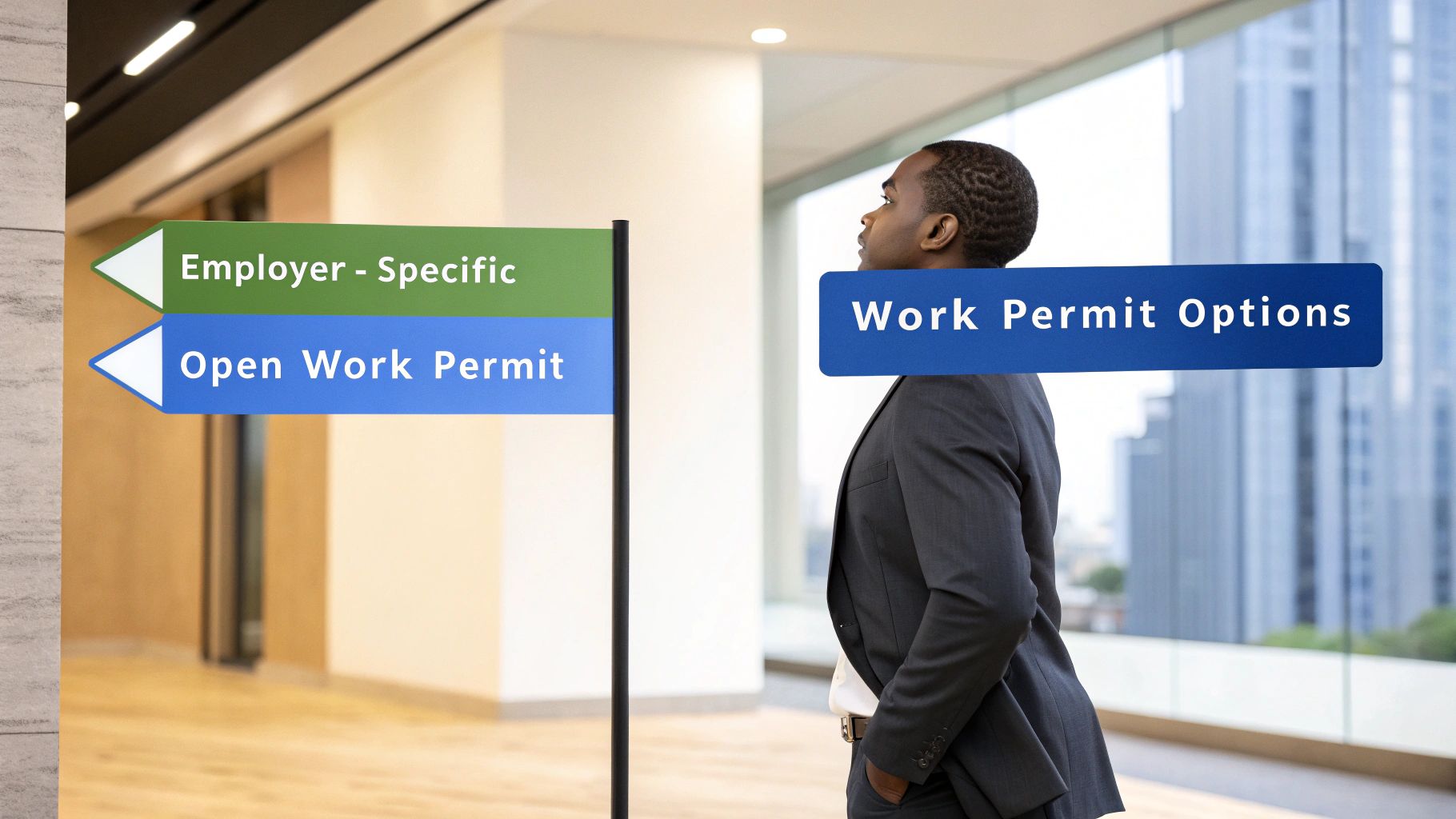
Alright, this is where the rubber meets the road. Gathering your documents isn't just a tedious task; it's you building a solid, believable case for the visa officer. A complete, neatly organised file speaks volumes—it shows you’re serious, meticulous, and ready for this journey.
Think of it this way: you wouldn't show up for a major interview with a half-finished CV, right? Same principle applies here. Your work permit application needs to be a full, convincing package. Let's break down exactly what you'll need, with some real talk on navigating this process from right here in Nigeria.
The Core Application Forms
First things first, you need the official forms from the Immigration, Refugees and Citizenship Canada (IRCC) website. These are the backbone of your entire application.
- Application for Work Permit Made Outside of Canada (IMM 1295): This is the big one. It covers your personal details, your work history, and the specifics of the Canadian job you're heading to.
- Family Information Form (IMM 5707 or IMM 5645): Here, you'll need to provide details about your immediate family—parents, spouse, kids—even if they aren't coming with you. Be painfully thorough and double-check every name and date.
- Schedule 1 – Application for a Temporary Resident Visa: You'll often need this form to give IRCC more background on things like your travel history or any past military or government service.
A quick but crucial tip: Always download the latest versions of these forms directly from the IRCC site. Submitting an old version is a classic, easily avoidable mistake that can get your application sent right back to you.
Proving Who You Are: Identity and Travel Docs
This part is straightforward but non-negotiable. Your primary proof of identity is your Nigerian international passport. The golden rule? It must be valid for the entire time you plan to work in Canada.
If your passport is nearing its expiry date, you need to get that sorted out immediately. You can find out how to renew your Nigerian passport online to avoid last-minute panic. You’ll also need two recent passport-sized photos that meet IRCC’s very specific requirements—don’t just grab any old studio picture.
The All-Important Proof of Funds
Let's be honest, this is often the most stressful part for us Nigerians. IRCC needs to be sure you can support yourself when you first land in Canada, before that first paycheque comes in. And they aren't looking for a huge amount of money that magically appeared in your account last week.
What they really want to see is a pattern of financial stability. Here’s how you can present your Naira bank statements in a way that tells the right story:
- Show 4-6 months of statements: This demonstrates your saving habits and income flow, proving the money is genuinely yours and not just a loan from your uncle for the application.
- Get a bank reference letter: This official letter from your bank (like GTB or Zenith) should confirm you're their customer and state your current balance.
- Explain any large, unusual deposits: Did you sell a car or receive a significant cash gift from family for your "japa" plans? Attach a short note in your Letter of Explanation along with proof, like a receipt of sale or a gift deed.
Inside the Visa Officer's Mind: They are trying to gauge your financial ties to Nigeria and your ability to manage money. A steady, consistent account history is far more convincing than a massive balance that showed up overnight. Their main concern is that you won't need to rely on Canadian social assistance.
Police Clearance and Medicals
Canada needs assurance that you're in good health and pose no security risk. This means getting two key documents.
Police Clearance Certificate (PCC): You'll need to get this from the Nigerian Police Force Criminal Investigation Department (CID) headquarters at Alagbon. It involves an application, getting your fingerprints taken, and then waiting for the certificate. My advice? Start this process as early as possible, as it can sometimes drag on for a few weeks.
Upfront Medical Examination: You can’t just visit your family doctor for this one. You must book an appointment with an IRCC-approved panel physician in Nigeria, who are mostly located in Lagos and Abuja. They'll do a full medical check-up and send the results directly to IRCC for you.
Your Personal Pitch: The Letter of Explanation
Your Letter of Explanation, or Statement of Purpose (SOP), is your one chance to speak directly to the visa officer. This is where you connect all the dots and give your application a human voice.
Don't just rehash the information from your forms. Use this letter to:
- Clearly state your purpose: Explain why you want this specific job in Canada and how it’s a logical step in your career.
- Highlight your ties to Nigeria: Talk about your family, property you own, or the great career you plan to return to. This reassures the officer you have strong reasons to come back home. This is crucial for temporary visas.
- Address any red flags: Got a gap in your employment history? A previous visa refusal? Explain it honestly and concisely. Don't hide it.
For instance, a young software developer from Lagos could explain how working at a Canadian tech firm will provide unique skills they plan to bring back to launch their own startup in Yaba. This shows clear intent and strong home ties. And speaking of your professional side, it's never too early to get your resume in top shape. This guide to crafting a winning resume is an excellent resource for making sure your professional documents are as strong as your immigration application.
Getting to Grips with the IRCC Online Application Portal
Diving into the IRCC online portal for the first time can feel a bit like stepping into a maze. It’s complex, and frankly, a little intimidating. But don't worry, I'm here to walk you through it, step by step, just as if I were sitting next to you. We'll get your account set up and make sure you find the exact forms you need.
First things first, you’ll need to register for a secure IRCC account. This is your personal gateway to the entire application system. You'll just need a valid email address and to create a strong password you can remember.
Here’s what the starting page looks like, so you know you're in the right place. This is where your journey begins.
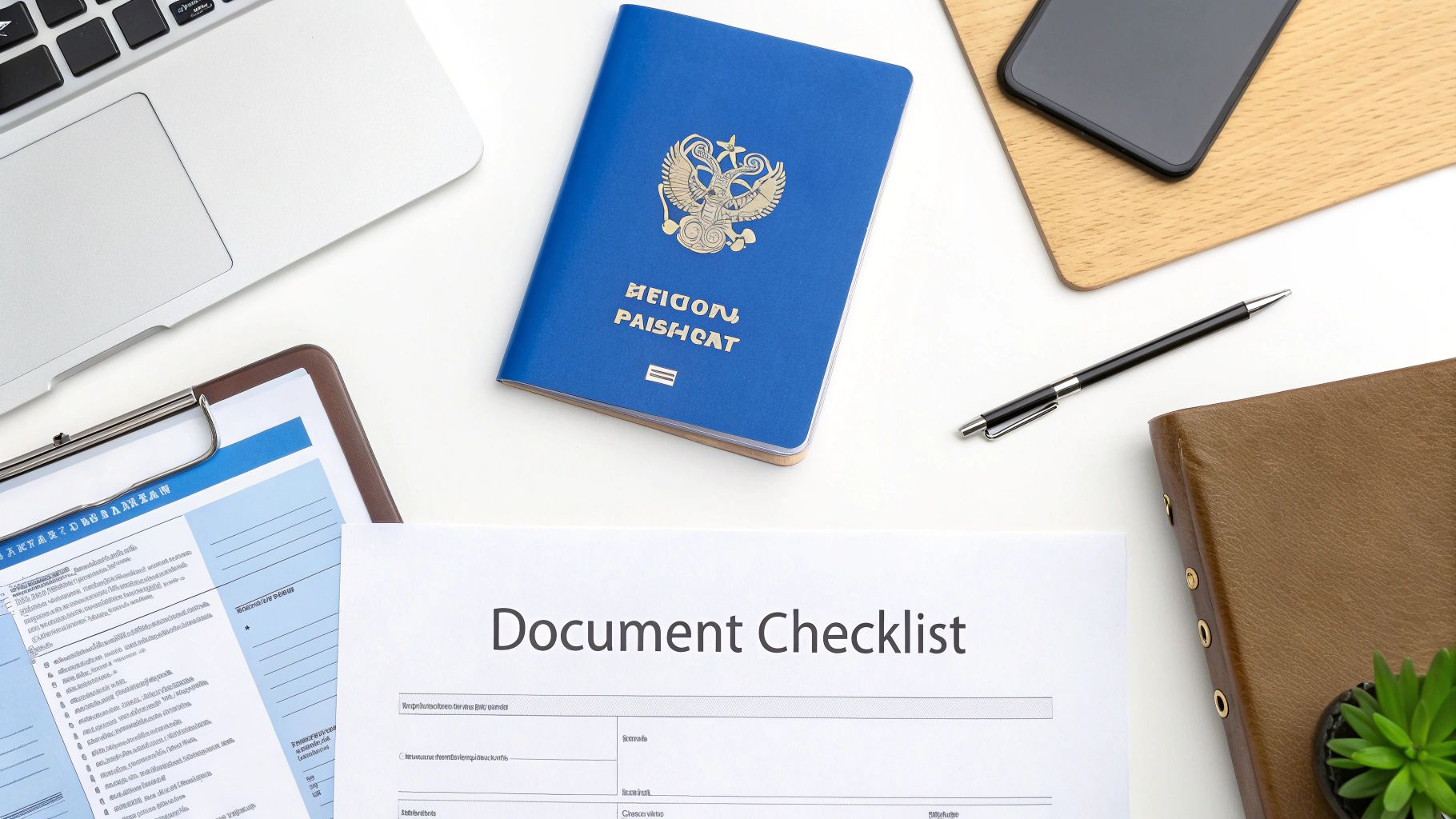
The simple layout with clear "Sign in" or "Register" options should give you some confidence that you're on the official, secure government site.
Creating Your Account and Finding the Right Forms
Once you're registered and logged in, you'll land on a dashboard. This is your mission control centre. From here, you need to find the specific application for a work permit. Look for the option that says something like “Apply to come to Canada” and then select the work permit category. The key form you're looking for is the Application for Work Permit Made Outside of Canada (IMM 1295).
When you start filling out the IMM 1295, you'll need a few key details handy:
- Your personal identification, like your passport number and its expiry date.
- All the info about your job offer, including the employer's details and the LMIA number if you have one.
- A concise summary of your education and work history, making sure it aligns with your NOC code.
Take your time here. A simple typo can cause unnecessary delays, so double-check every field before you click "next".
Pro Tip: Look for the form version date, usually at the bottom of the PDF form. Always download the latest version directly from the portal to avoid having your application returned because you used an outdated form. It happens more often than you'd think.
Nailing the Tricky Sections
From my experience, a few sections on the forms tend to trip up Nigerian applicants more than others.
The travel history section is a big one. You need to be meticulous. List every single trip you've taken outside Nigeria, no matter how short. A quick business trip to Ghana? It counts. A holiday in Dubai? It definitely counts.
- Keep your passport next to you and go through it stamp by stamp.
- If you've used different passports over the years, dig up your old flight confirmation emails to jog your memory.
Family information is another potential minefield. Make sure you have the correct birth dates and full legal names for all your family members as they appear on official documents. Consistency is key.
Uploading Your Documents Without a Hitch
When it’s time to upload your supporting documents, the portal has some strict rules. All your files must be in PDF format. Don't try uploading JPEGs or other image files directly; convert them first.
Each document also has a file size limit, typically under 4 MB. If your file is too large, you’ll need to compress it before it will upload.
- Always scan documents in a lower resolution (like 150 dpi) to keep file sizes manageable without losing clarity.
- Give your files clear, descriptive names, like "Passport_Bio_Page_YourName.pdf" or "Job_Offer_Letter.pdf". This helps both you and the officer.
As you upload, hit the "Save" button frequently. This protects your work until you're ready to submit.
Speaking of work permits, it's interesting to note how programs like the Temporary Foreign Worker Program continue to be a major pathway. In New Brunswick alone, 105,195 permits were issued in the first half of a recent year. While that's a slight dip from 109,310 the previous year, it shows just how active this route is. You can learn more about the TFWP's impact in New Brunswick here.
Outsmarting Common Portal Glitches
The IRCC portal is notorious for timing out if you leave it inactive for too long. Get into the habit of saving your progress every few minutes to avoid losing your work.
Here are a couple of tricks I've learned to keep things running smoothly:
- Before you log in, clear your browser's cache and cookies. This can solve a surprising number of loading errors.
- Work on your application in a single browser tab. Having multiple tabs open can sometimes confuse the system and cause data to be lost.
The Final Review Before You Hit 'Submit'
Before you take the final plunge, go back and review everything one last time. Read through each form, checking for typos or missing information. Click on each uploaded document to make sure the correct file is there.
The portal will show you a summary page right before payment. Use this as a final checklist. Does everything look right? Are all documents accounted for? Good. Now you can move forward with confidence.
What’s Next: Paying Fees and Booking Biometrics
Once you submit the application, the system will automatically calculate your total fees, which include the work permit processing fee and the biometrics fee. You'll pay this directly through the portal with a credit or debit card.
After your payment is confirmed, you'll receive a Biometric Instruction Letter (BIL). Only then can you book your biometrics appointment at a Visa Application Centre (VAC) in Nigeria.
Key Insight: A common cause of glitches, especially during payment, is a mismatch between the time zone on your computer and the IRCC server's time. Make sure your device's clock is set correctly to avoid frustrating errors.
Taking Control of Your Application
By handling the application yourself, you not only save on agent fees but also gain complete control and understanding of your file. You know exactly what’s been submitted.
For extra support, you can use tools from JapaChat to help you stay organised. Think of it as your personal assistant for the application process. You can get:
- Automated reminders for important deadlines.
- A progress tracker to see where you are at each stage.
- Live chat support if you get stuck on a specific form or encounter an error.
With the right preparation and tools, you can navigate this process feeling empowered and in control. Next up, we'll dive deeper into the specifics of paying your fees and booking that all-important biometrics appointment in Nigeria.
Handling Fees and Biometrics in Nigeria
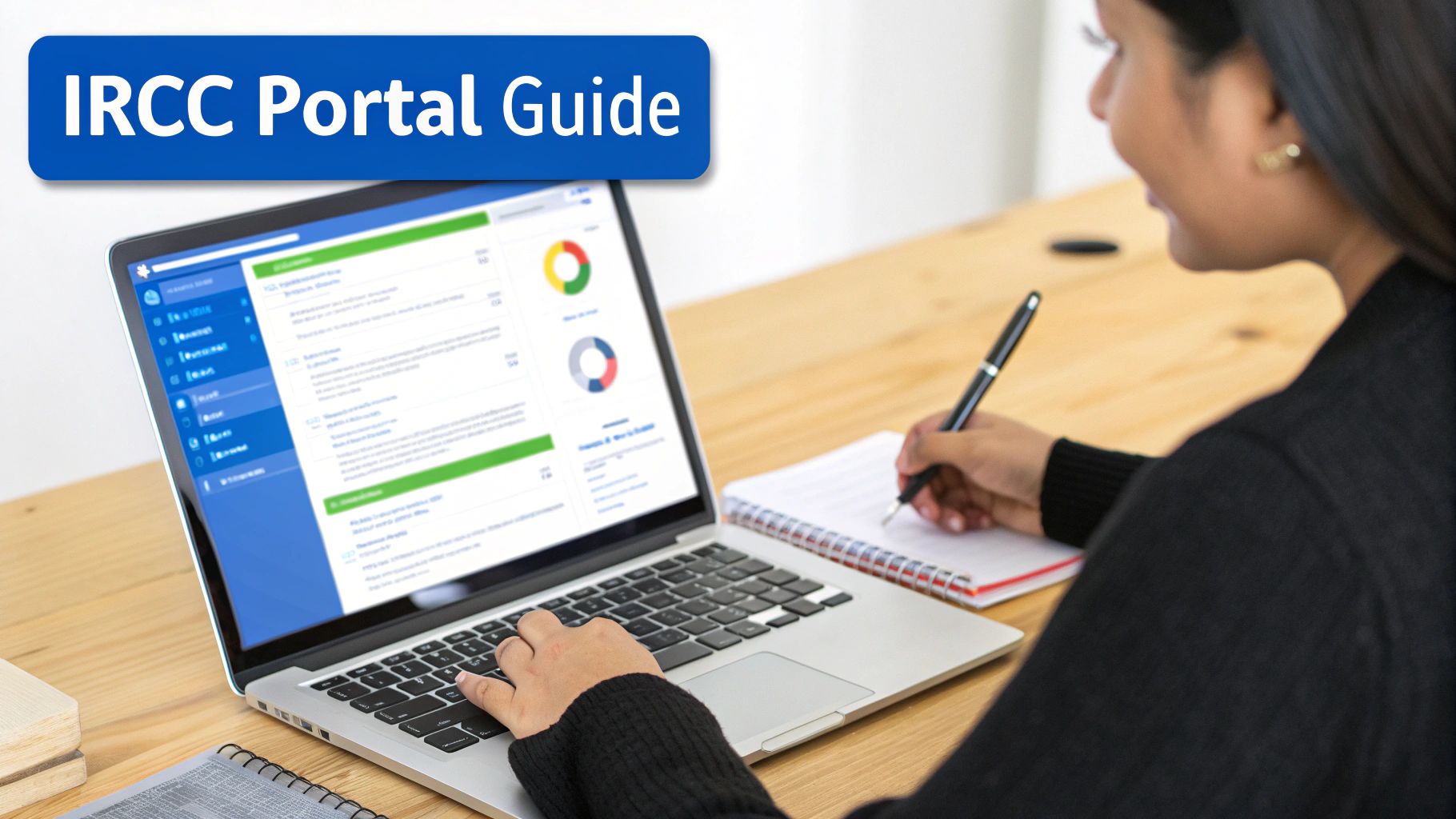
You’ve wrestled with the forms, gathered every last document, and uploaded everything to your portal. Well done. Now it's time for the final two steps that officially get your application in the queue: paying the fees and submitting your biometrics.
This part is less about paperwork and more about procedure. It's straightforward, but you need to be precise to avoid any frustrating delays.
Breaking Down the Application Costs
Once you hit that ‘submit’ button on the IRCC portal, the system will automatically calculate all the required fees. For a typical Canadian work permit application, the cost is usually split into two parts:
- Work Permit Processing Fee: The core fee for an immigration officer to review your entire application.
- Biometrics Fee: A separate charge for the collection of your fingerprints and photograph.
The total amount will be displayed in Canadian Dollars (CAD). Payment is made directly on the portal using a credit or debit card—Visa and Mastercard are your best bets.
Now, here’s a common hurdle for many Nigerians: payment failure. Our Naira-denominated cards often have strict limits on international transactions, which can lead to a declined payment. If this happens to you, don't panic. The easiest way around this is to use a domiciliary account debit card. Another option is to ask a trusted friend or relative living abroad to make the payment on your behalf.
Booking Your Biometrics Appointment
As soon as your payment is confirmed, a Biometric Instruction Letter (BIL) will appear in your IRCC account. This usually happens within 24 hours. Think of this letter as your pass to the next stage. Without it, you can't book your appointment, and it's only valid for 30 days.
With your BIL downloaded, your immediate task is to book an appointment at a Visa Application Centre (VAC). In Nigeria, the main centres are in Lagos and Abuja.
My advice: Book your appointment the very same day you receive your BIL. Appointment slots, especially in Lagos and Abuja, get snatched up incredibly fast. Waiting even a few days could mean missing the 30-day window, which will bring your application to a dead stop.
The stress of these timelines is a well-known issue. It’s become such a challenge that some Canadian provinces have even stepped in to help. For instance, New Brunswick created an emergency work-permit pathway for candidates whose permits were about to expire due to federal processing delays. You can read more about how provinces address processing challenges on visahq.com.
Your Day at the VAC
On appointment day, your goal is to be in and out smoothly. The biometrics collection itself is very quick, but getting past the entrance depends entirely on having the right documents with you.
Make sure you have these three items, no excuses:
- Your Nigerian International Passport: This is your non-negotiable proof of identity.
- The Biometric Instruction Letter (BIL): A printed copy is mandatory. They will not accept a digital version on your phone.
- Your Appointment Confirmation Letter: This is the email you got from the VAC when you booked your slot. Print this too.
Inside, an official will check your documents before calling you in. The process involves a quick digital fingerprint scan and a photo. Honestly, you’ll likely spend more time waiting than you will giving your biometrics—the whole thing often takes less than 30 minutes.
Before you leave, the VAC staff will give you a receipt. Hold on to this receipt! It's your official proof that this crucial step is complete. Within a few days, your IRCC portal should update to show that your biometrics have been successfully linked to your file.
What Happens After You Hit ‘Submit’?
You’ve done it. After all the document gathering, form-filling, and triple-checking, you’ve finally submitted your application. It’s a huge moment of relief, but it also kicks off what can be the most nerve-wracking part of the entire journey: the waiting game.
This period is often filled with a lot of uncertainty and anxiety. Every single email notification makes your heart jump. To keep your cool and manage your expectations, it helps to understand what’s actually happening behind the scenes with your application.
The Waiting Game and How to Track Your Application
Once your application is in and you’ve done your biometrics, your file officially enters the processing queue at Immigration, Refugees and Citizenship Canada (IRCC). Keep in mind that the processing times you see on the IRCC website are just estimates. They can, and often do, vary wildly for applicants from Nigeria, so try to be patient but stay proactive.
Your IRCC secure account is now your best friend. Make it a habit to check it regularly for updates. You'll see the status change from "Submitted" to "In Progress," and you might spot smaller updates like "Biometrics completed" or "Medicals passed." These little changes are good signs—they mean an officer is actively working on your file.
A Quick Tip from Experience: Try not to get obsessed with checking your portal multiple times a day. It’s a surefire way to drive yourself crazy with anxiety. A much healthier approach is to set a routine, maybe checking it once every couple of days. Consistent, calm monitoring is far better for your peace of mind.
If you want to get more strategic about it, you can explore other ways to keep tabs on your progress. We’ve put together a detailed guide on visa application tracking that dives deeper into the tools and methods you can use.
Making Sense of Messages from IRCC
During this waiting period, you might get a few different messages from IRCC. Knowing what each one means is key so you can respond quickly and correctly.
Here’s a quick rundown of the most common communications you might see:
- Biometric Instruction Letter (BIL): This is usually the first official document you’ll get after paying your fees. It’s the letter that authorises you to go to a Visa Application Centre (VAC) in Lagos or Abuja to get your fingerprints and photo taken.
- Request for Additional Documents: Don’t panic if you see this! It’s quite common. A visa officer might just need more clarity on your proof of funds, a more detailed job description from your employer, or an updated police certificate. They will give you a firm deadline to upload these documents, so make sure you act fast.
- Medical Request: If you didn’t do an upfront medical exam, you’ll receive a request to go see an IRCC-approved doctor, known as a panel physician.
Responding to these requests promptly and giving them exactly what they’ve asked for is critical. Any delay on your part can, unfortunately, lead to a much longer delay in getting your final decision.
The Final Decision and Your Port of Entry Letter
Finally, the day will come when the status in your portal changes to "Final Decision Made." You'll then get a message in your account with one of two outcomes: a refusal letter or, fingers crossed, a Port of Entry (POE) Letter of Introduction. This is also sometimes called a correspondence letter.
It's so important to understand what this POE letter is. This is not your actual work permit. Think of it as your approval letter—the golden ticket you need to present to the border services officer when you first land in Canada. That officer will ask you a few final questions and then print your official work permit for you right there at the airport.
The stability of work permit programmes is a major consideration for many people. It’s interesting to see that even when national immigration trends shift, some provinces keep a steady intake of workers. For instance, in New Brunswick, 3,080 migrant work permit holders arrived over an eight-month period, a figure that has remained surprisingly stable year over year. You can read more about New Brunswick's immigrant numbers on tj.news.
Once you have that POE letter in hand, you can confidently book your flight and start planning your big move. This is the moment you know all your hard work has truly paid off.
Common Questions I Hear from Nigerian Applicants
https://www.youtube.com/embed/_QklwdrrgTY
Going through the Canadian work permit process from Nigeria definitely brings up a lot of questions. I get them all the time. Let's tackle some of the most common ones I see, so you can move forward feeling a lot more confident.
Can I Bring My Family With Me on a Work Permit?
Yes, you absolutely can, and this is a huge plus for many Nigerian families. If you’ve landed a work permit for a skilled job (that’s usually anything in TEER 0, 1, 2, or 3), your spouse or common-law partner can often get an open work permit.
This is a game-changer because it means they can work for nearly any employer in Canada, which really helps your family settle in. Your kids can come along too, and they can slot right into primary or secondary school without needing their own study permits.
How Much Proof of Funds Do I Really Need?
There's no single magic number, but here's the reality: you need to show the visa officer you can handle your initial expenses before your first Canadian paycheque comes in.
A good benchmark for a single person is to aim for $3,000 to $5,000 CAD. Of course, if you’re bringing your family, you'll need to show significantly more. What's even more crucial than the total amount is the money's history. Funds that have been in your account for at least 4 to 6 months look far more genuine than a large, sudden deposit that appeared last week.
Can I Switch Employers If I Have an Employer-Specific Permit?
This is a really important one to understand. An employer-specific work permit means you are legally tied to that one company. If a better opportunity comes up and you want to switch jobs, you can't just quit and start somewhere else.
You must apply for a completely new work permit, which will require a new job offer and, in most cases, a new LMIA from your new employer. Only after that new permit is approved can you start the new job.
Think of it this way: changing jobs isn't just about giving notice. You're essentially starting a whole new work permit application from scratch. Make sure you plan for this and that your new employer is ready to support you through the process.
What Are My Chances of Getting a Job Without Canadian Experience?
It’s a fair question and a common worry, but it’s far from a deal-breaker. Many Canadian employers are actively looking for global talent and value international experience, especially in booming sectors like tech, healthcare, and engineering.
The trick is to frame your Nigerian experience in a way that resonates with the Canadian job market. Tweak your CV to showcase skills that are directly transferable. Get active on LinkedIn, connect with recruiters who work with international candidates, and don't be afraid to highlight your unique perspective.
A lot of Nigerians also ask about salary expectations. It's smart to get a handle on the cost of living and earning potential. A great starting point is to look up the average salaries in Canada for your profession. This knowledge will help you manage your expectations and even give you more confidence when you get to the negotiation stage.
Feeling overwhelmed by the immigration process? Let JapaChat be your guide. As Nigeria's first AI immigration expert, we provide instant, accurate answers to your questions, helping you plan your move with clarity. Start for free and join over 10,000 Nigerians planning their journey at https://japachat.com.
-
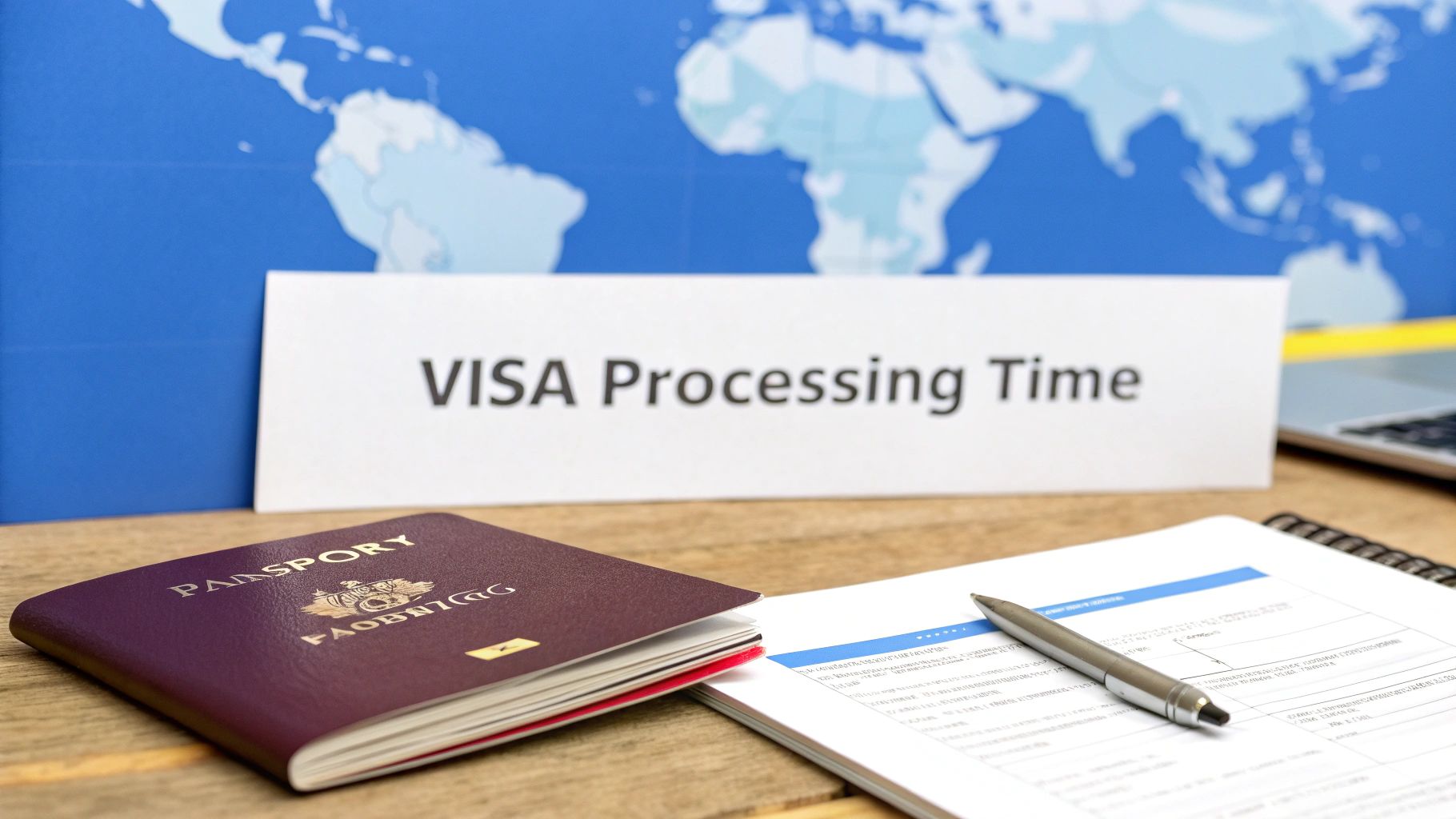
Visitor Visa Canada Processing Time: A Nigerian’s Realistic Guide
Getting a visitor visa for Canada is a waiting game, and if you're applying from Nigeria, it often feels like you’re playing on a harder level. The official visitor visa canada processing time published by Immigration, Refugees and Citizenship Canada (IRCC) might tell one story, but the reality on the ground in Lagos or Abuja can be a whole different chapter. It’s not unusual for the entire process to stretch over several weeks, and sometimes, even months.
Decoding the Visa Processing Timeline in Nigeria
Think of the Canadian visa process like planning a road trip from Lagos to Abuja. Your map app might say it’s a 12-hour drive, but anyone who's made that journey knows better. You have to factor in traffic, potholes, and maybe a few unexpected stops along the way. The official processing time is that perfect-world map estimate; your actual wait depends on the real-world conditions your application faces.
A crucial point many Nigerian applicants miss is when the clock actually starts ticking. The "processing time" doesn't begin the moment you hit 'submit' on your online form. It officially starts after you’ve given your biometrics (your fingerprints and photo) at a Visa Application Centre (VAC). Getting this detail wrong is a common source of anxiety and frustration.
The Official vs. The Real Timeline
Let's talk numbers. The gap between what IRCC's tool might show and what Nigerian applicants often experience can be quite wide. This is where setting realistic expectations becomes so important.
Here’s a breakdown to give you a clearer picture:
A Realistic Look at Visa Processing Times for Nigerians
Time Metric Official IRCC Estimate Common Nigerian Applicant Experience Initial Estimate Around 28–31 days (varies) Often 60–90+ days from biometrics Why the Difference? Based on 80% of past applications globally. High application volume from Nigeria, more rigorous document verification. Best Strategy Apply as early as possible. Plan for 3-4 months of waiting time before your intended travel date. This table isn't meant to discourage you, but to help you plan strategically. Nigerian applicants have historically faced some of the longest waits, with recent data showing the average time hovers closer to 85 days. This is often due to the sheer volume of applications and the detailed scrutiny required for documents submitted from Nigeria. You can dive deeper into these country-specific differences by checking out more info on visa processing times on Atlys.com.
This infographic really drives home how different the experience can be for Nigerians compared to applicants from other major countries.
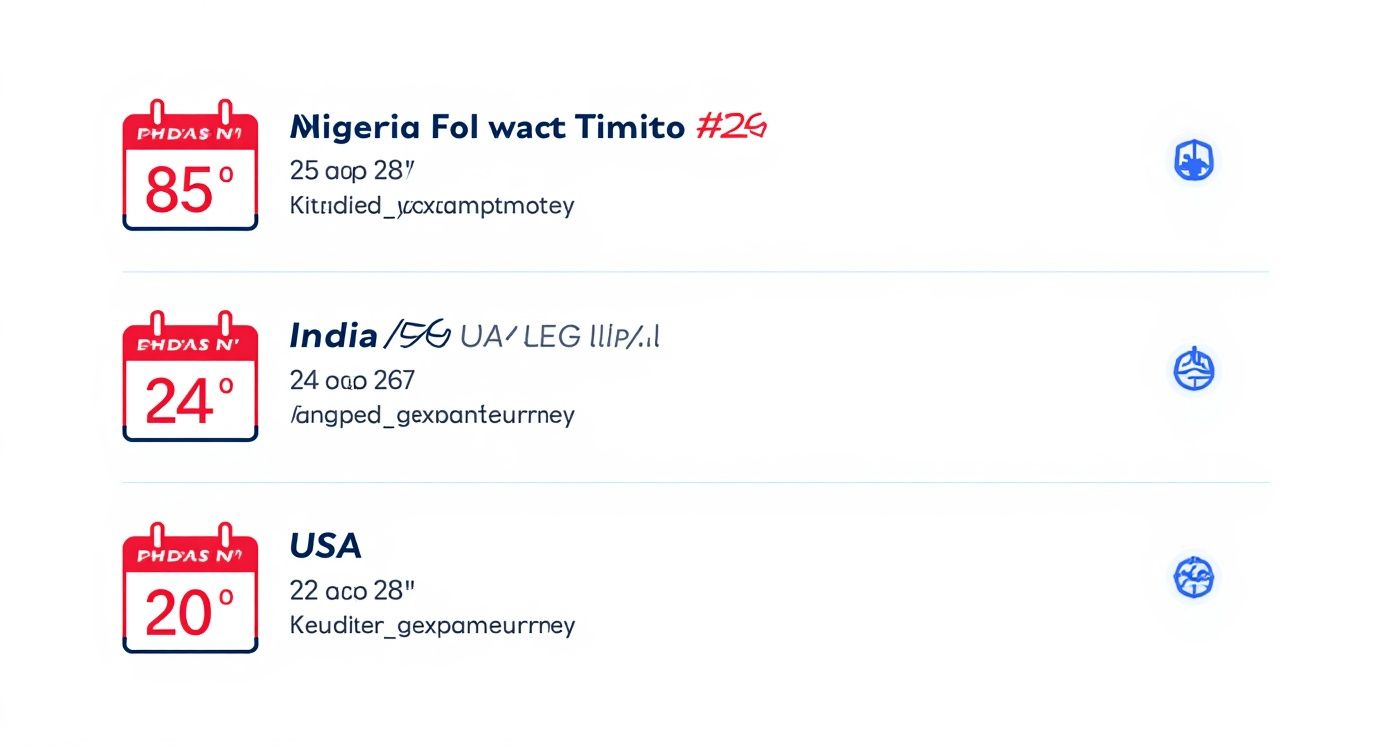
As you can see, the wait is substantially longer. This is exactly why applying well in advance of your planned trip isn't just a good idea—it's essential.
The key takeaway here is to manage your expectations from the start. Prepare for a marathon, not a sprint. A smart approach is to plan at least 3-4 months ahead of when you want to travel. This buffer accounts for potential delays and gives your application the best possible chance of a smooth journey.
Why Nigerian Visa Applications Often Face Delays
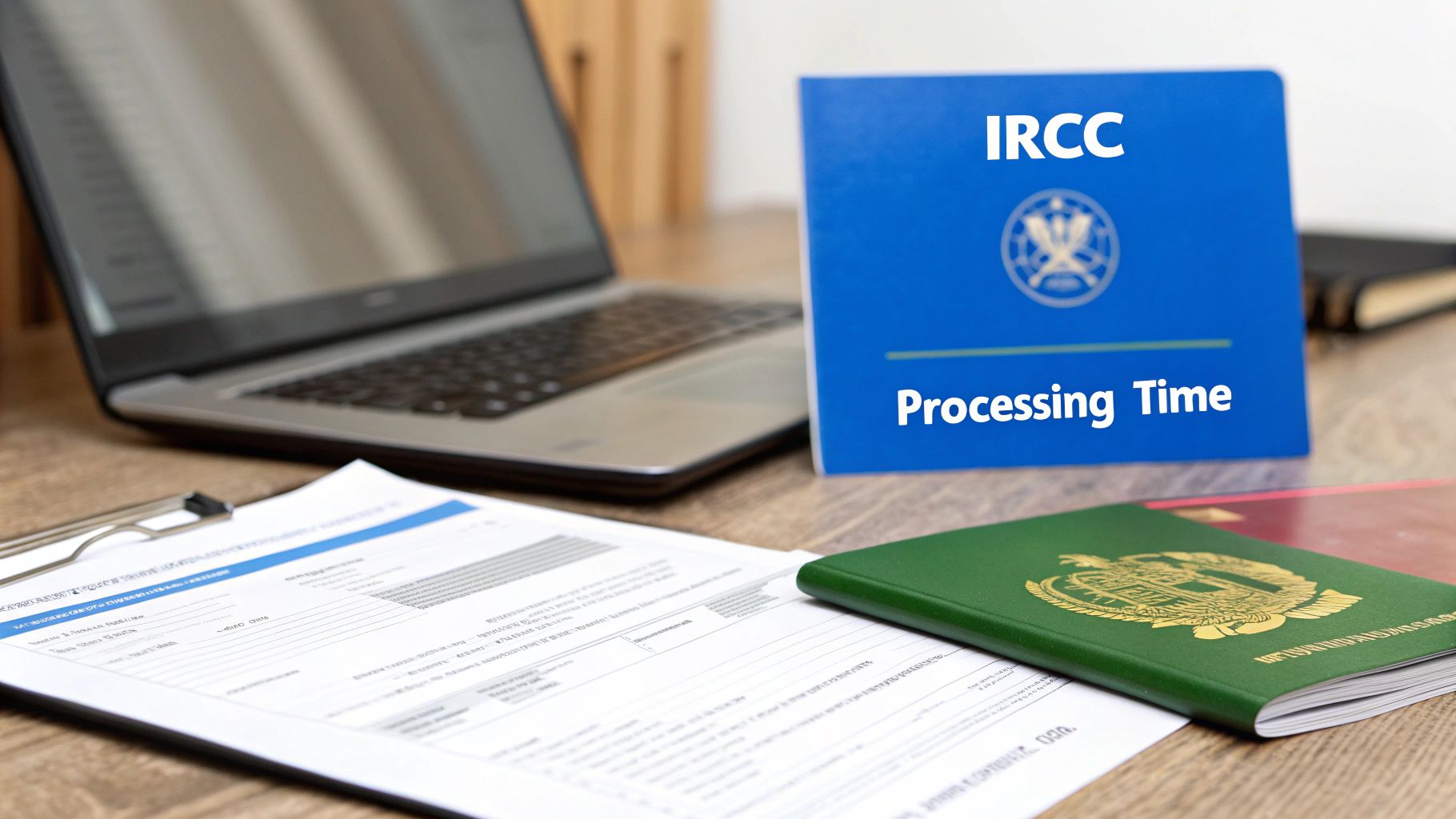
It’s the question on every Nigerian applicant’s mind: "Why is my application taking so long?" Truth be told, figuring out the reasons for the long visitor visa Canada processing time for Nigerians can feel like trying to untangle a knotted fishing line. It’s not just a simple case of a long queue; several specific factors are at play, and each one needs your full attention.
Think of your visa application as telling a story to the visa officer. If any chapter of that story is confusing, unclear, or doesn't add up, they will hit the pause button to investigate. Those pauses are what you experience as delays.
Let's get into the common issues that can put the brakes on your application, with real-world examples you can use to avoid them before you even click "submit."
Incomplete or Inaccurate Documentation
This is, without a doubt, the number one reason for delays, and it's also the most avoidable. A single missing document or a small mistake can push your application to the bottom of the pile. A visa officer isn't going to call you up for corrections; they'll simply set it aside or, even worse, refuse it outright.
It’s like trying to register a car in Lagos. If you show up at the licensing office without your proof of ownership or with a blurry photocopy of your ID, you’re not driving home with your new papers that day. The visa process is ten times stricter. Every single document has to be crystal clear, complete, and exactly what they asked for.
High Volume of Applications at the Visa Office
Let’s be realistic—the visa office that handles applications from Nigeria is one of the busiest on the planet. This massive volume naturally creates a backlog. When you add in peak travel times like summer holidays or the Christmas season, the number of applications surges, leading to even longer waits for everybody.
It's a classic case of supply and demand. You have a limited number of visa officers trying to get through a mountain of applications. The only smart move is to apply well ahead of time to beat the predictable rush.
Strong Proof of Funds and Financial Stability
For Nigerian applicants, this is where the visa officers really zoom in. It’s not just about showing you have money in the bank. It's about proving its origin and demonstrating a consistent, stable financial history. A large chunk of cash appearing in your account right before you apply is a massive red flag.
Let’s look at an example:
You're a business owner in Ikeja and just landed a big contract. A payment of ₦10,000,000 hits your account.- Weak Submission: You just provide a bank statement showing the new balance. To a visa officer, this looks suspicious and unexplained.
- Strong Submission: You provide the bank statement, a copy of the signed contract or invoice for the deal, and a short letter explaining the transaction. This paints a clear, verifiable, and believable picture.
The same logic applies if a relative is sponsoring your trip. You must provide clear proof of their financial standing and an official letter from them explaining their support. Don't leave anything to the officer’s imagination. To get a better grasp of what happens when information is unclear, you might want to learn more about the consequences of visa application misrepresentation.
Demonstrating Strong Ties to Nigeria
This is probably the most crucial part of your entire application. The visa officer must be completely convinced that you will leave Canada and return to Nigeria at the end of your visit. It’s on you to provide solid, compelling evidence that your life, your responsibilities, and your future are all firmly rooted back home.
Here’s how you can show strong ties with practical proof:
- Stable Employment: Get a formal employment letter from your company in Lagos. It should state your position, salary, and confirm your leave is approved for the trip. Back this up with your last six months' payslips to show a steady income.
- Family Responsibilities: If you have children or are the main caregiver for elderly parents in Kano, include their birth certificates or a doctor's note. This shows you have people who depend on you at home.
- Property Ownership: Owning property is a very strong tie. Make sure to include the title deeds for your house or land in Abuja or anywhere else in Nigeria.
- Business Ownership: If you run your own business, provide your Corporate Affairs Commission (CAC) registration documents and the business's bank statements.
Each of these pieces helps create a portrait of a life you are committed to returning to. The more proof you can provide, the stronger your case will be—and the less reason an officer will have to delay your application for a second look.
How to Prepare a Stronger Visa Application
Waiting for a decision on your Canadian visitor visa can feel like a marathon, but you're not just a spectator. A strong, well-prepared application is your single best strategy to get through the process without unnecessary hold-ups. It's less about just filling out forms and more about presenting a clear, convincing story to the visa officer.
Think of it like preparing for a big presentation. You wouldn't just walk in with a few notes; you'd research your audience, anticipate questions, and polish every slide. Your visa application deserves that same attention to detail.
Let's break down the key areas where Nigerian applicants often get tripped up and show you how to build a case that makes it easy for the visa officer to approve your request.
The Biometrics Bottleneck
Before your documents are even looked at, you have to get past the first major hurdle for Nigerian applicants: biometrics. The clock on your application processing doesn't even start ticking until you've had your fingerprints and photo taken at a Visa Application Centre (VAC) in Lagos or Abuja. This step is a huge bottleneck.
It's common to find that appointments are fully booked for weeks, sometimes even months. The most crucial thing you can do to avoid an early delay is to book your biometrics appointment the very same day you get your Biometric Instruction Letter (BIL). Don't put it off for even a day.
Pro Tip: Check the VAC appointment portal constantly—several times a day if you can. People cancel, and new slots open up unexpectedly. A little persistence here can shave weeks off your wait time.
Mastering Your Financial Documents
Your proof of funds isn't just a number on a page; it tells the story of your financial stability. For Nigerian applicants, this is one of the most closely examined parts of the application. Simply having a large sum of money in your account isn't good enough—you must prove where it came from.
Here's how to present a rock-solid financial picture:
- Get Official Stamped Statements: Don't just print statements from your banking app. Make the trip to your bank and ask for officially stamped statements covering the last six months. That stamp adds a layer of authenticity that visa officers look for.
- Explain Large Deposits: Sold a car recently? Received a big payment from a client? Attach a short, one-page letter explaining any large, out-of-the-ordinary deposits. Back it up with proof, like a receipt of sale or an invoice. This transparency builds trust and avoids suspicion.
- Show Consistent Income: Make sure your salary slips line up with the regular deposits in your bank statements. Consistency is what proves you have a stable job and aren't just borrowing money to inflate your account balance for the application.
Let's look at some common mistakes that can sink an otherwise good application.
Common Application Mistakes and How to Avoid Them
Many delays are caused by simple, avoidable errors. Here’s a quick rundown of what to watch out for.
Common Mistake Why It Causes a Delay How to Fix It Using an "Agent" to Fill Your Forms Many agents use generic, templated answers that raise red flags. Inconsistencies across documents are common. Fill out the forms yourself. You know your situation best. Use official IRCC guides for help, not an unofficial third party. "Dumping" Money into Your Account A large, unexplained lump sum just before applying looks suspicious and suggests the money might be borrowed. Build a consistent six-month banking history. If you have a legitimate large deposit, explain it clearly with supporting documents. Vague Travel Itinerary Simply stating "tourism" isn't enough. It suggests the trip isn't well-planned and could raise doubts about your intent. Provide a day-by-day plan. Mention specific places you'll visit, tours you might take, or events you'll attend. Show you've done your research. Weak Ties to Nigeria If you can't show strong reasons to return home (job, family, property), the visa officer may worry you won't leave Canada. Include your employment letter, property deeds or tenancy agreements, and proof of family ties (e.g., marriage and birth certificates). Taking the time to double-check these areas can make a massive difference.
Crafting a Credible Letter of Invitation
If you're visiting friends or family in Canada, their Letter of Invitation is a make-or-break document. A weak, informal email won't cut it. A strong letter provides concrete details that validate the purpose of your trip.
Your host in Canada must include these specific details to make the letter credible:
- Their Full Information: Name, address, and phone number in Canada.
- Proof of Status: A clear copy of their Canadian passport, permanent resident (PR) card, or work permit.
- Your Full Information: Your full name, date of birth, address, and your relationship to them (e.g., "my mother," "my childhood friend").
- Purpose and Duration: Be specific about why you're visiting (e.g., "to attend my nephew's graduation ceremony on June 15th") and the exact dates you plan to be in Canada.
- Accommodation and Expenses: The letter must state where you will be staying and who is covering your living costs. If your host is paying for everything, they should include their own proof of funds, like a recent payslip or bank statement.
For a more in-depth guide on making your application's purpose crystal clear, read our post on creating a compelling letter of intent for a visa application.
By zeroing in on these critical areas—booking biometrics instantly, preparing meticulous financial records, and getting a detailed invitation letter—you turn your application from just another file in the pile into a powerful, convincing case. These proactive steps are your best defence against preventable delays.
Tracking Your Application Status Step by Step
So, you’ve submitted all your documents and done your biometrics. Now comes the hard part: the waiting game. This period can be incredibly stressful, filled with uncertainty about your visitor visa Canada processing time. But thankfully, you don't have to just sit and wonder. Immigration, Refugees and Citizenship Canada (IRCC) has an online tool to keep you in the loop.
Knowing how to check your status gives you back a little bit of control and helps manage the anxiety. Think of it like tracking a package you’ve ordered online; you get to see its journey. This transparency helps you know exactly where your application is in the system.
Using the IRCC Online Portal
Your single source of truth for updates is the official IRCC website. To get started, you'll need to create a secure IRCC account or simply sign in if you already have one. For those who applied on paper, the first step is to link that paper application to your new online account.
Here’s a glimpse of the official portal where the process begins.
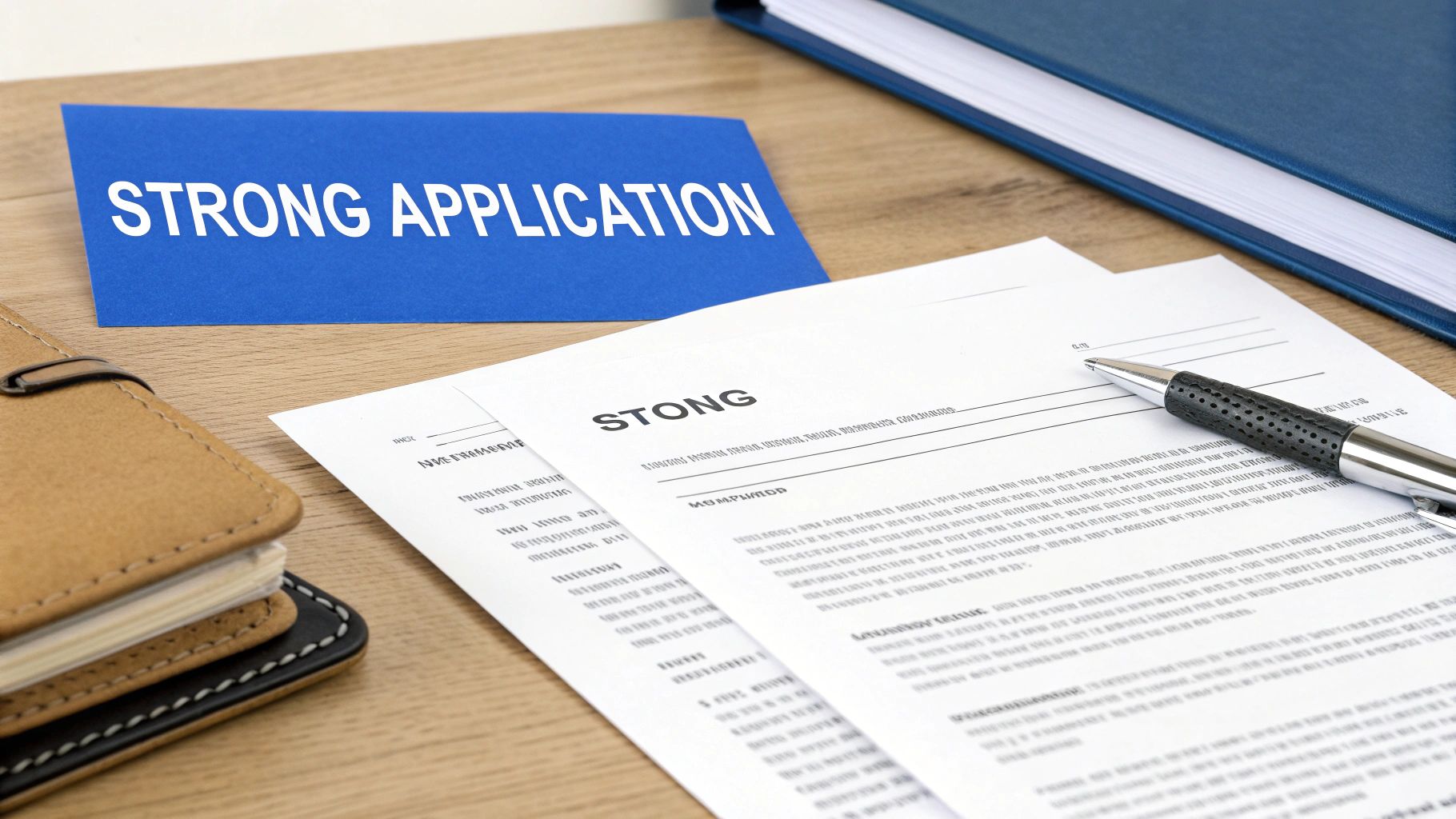
This screenshot shows the main page where you'll select the application you want to check—in this case, a visitor visa. It’s the starting line for getting updates directly from the source.
Once everything is linked up, you'll see a detailed view of your application's progress. Don't be alarmed if the status seems stuck for weeks at a time. This is completely normal, especially for applications coming from Nigeria. The real key is understanding what each of those little updates actually means.
Understanding Key Status Updates
The language on the IRCC portal can be a bit formal and confusing. Here’s a simple breakdown of what the most common statuses mean for you as a Nigerian applicant:
- Application Received: This just means your file has been created. A visa officer hasn't actually started reviewing it yet.
- Biometrics Completed: Good news! This confirms the VAC has successfully forwarded your fingerprints and photo to IRCC. Your application is now officially in the queue to be processed.
- Background Check in Progress: IRCC is now doing its due diligence and verifying the information you provided. This is a standard and necessary step for everyone.
- Medical Results Received: If you were asked to do a medical exam, this status confirms that IRCC has received the results from the panel physician.
- Final Decision: This is the big one everyone is waiting for. It means a decision—either an approval or a refusal—has been made. You'll soon receive instructions on what to do next, like submitting your passport for stamping if you've been approved.
Keep in mind, the status checker provides a high-level overview. It won't tell you why there might be a delay, but it does confirm your application is still alive and moving. Patience is your best friend during this phase.
If your application has been processing for a lot longer than the average time, it might be time to make a formal enquiry. First, double-check the latest processing times on the IRCC website. If your wait has gone far beyond that estimate, you can use the IRCC web form to request an update. When you do, be polite and make sure to provide all your application details clearly. For a more detailed look into this, our guide on visa application tracking has some extra tips that might help.
What to Do When Your Application Takes Too Long
It’s one of the most frustrating feelings imaginable. Your application has sailed past the average visitor visa Canada processing time, and all you’re getting is silence. It can feel like your travel plans are stuck in a bureaucratic black hole with no updates and no one to call.
But you aren't powerless. There are clear, practical steps you can take to follow up on your application and hopefully get some clarity.
Before you take any action, the first step is to check if your wait is genuinely outside the normal range. Head directly to the official IRCC processing time calculator and see the latest estimate for a visitor visa from Nigeria. If your application has been sitting there for a time that is significantly longer than what’s listed—say, 20-30 days beyond the estimate—then it’s perfectly reasonable to make a formal enquiry.
Using the IRCC Web Form for an Official Enquiry
Once you've confirmed your application is truly delayed, the official channel to use is the IRCC web form. This is your direct line to the immigration authorities, and it's vital to use it correctly to get a helpful response. Rushing this step or giving them incomplete information will only lead to more delays.
Think of the web form as a formal letter. You need to be polite, professional, and precise.
Here’s the essential information you must include in your enquiry:
- Your Full Name and Date of Birth: Make sure it's written exactly as it appears on your passport and application.
- Your Unique Client Identifier (UCI): You'll find this number on all correspondence from IRCC.
- Your Application Number: This is the one that starts with the letter 'V'.
- A Clear, Concise Message: Politely explain that your application has exceeded the standard processing time and that you are requesting an update on its status. Avoid emotional language; just stick to the facts.
A common mistake is to send multiple web form enquiries in a short period. This won't speed up your application. In fact, it can clog up the system and may even work against you. Send one detailed enquiry and then wait patiently for a response, which can take several weeks.
Exploring Other Avenues for Help
What if the web form yields no response after a month, or your situation is genuinely urgent? There are other, less common avenues you can explore. These options aren't for everyone, but just knowing they exist can be helpful in extreme cases.
Contacting a Member of Parliament (MP)
If you have a close relative who is a citizen or permanent resident in Canada, they can seek help on your behalf. They can contact their local Member of Parliament (MP) to make an enquiry about your delayed application. An MP's office has a dedicated channel for communicating with IRCC and can sometimes get more detailed information than you can through the public web form.
To do this, your relative will need to provide your full application details and sign consent forms that allow the MP’s office to act on your behalf. This is a powerful tool, but it should be reserved for cases with very significant delays.
The Last Resort Legal Option
In the most extreme circumstances, where an application has been delayed for an unreasonably long time with no decision or communication, there is a final legal option: a 'Writ of Mandamus'.
This is not a simple step. It involves hiring a Canadian immigration lawyer to file an application in the Federal Court of Canada. Essentially, you are asking the court to order IRCC to make a decision on your application.
This is a serious and expensive legal action, often costing thousands of dollars. It should only be considered after all other options have been completely exhausted and your application has been stuck for many, many months without any justification.
Your Top Questions Answered
Going through the Canada visitor visa process can bring up a lot of questions. Let's tackle some of the most common and pressing queries we hear from Nigerian applicants, giving you the straightforward answers you need.
Can I Pay Extra to Speed Up My Canada Visitor Visa from Nigeria?
It's a question on everyone's mind, especially when travel plans are getting close. But the simple, direct answer is no.
Immigration, Refugees and Citizenship Canada (IRCC) doesn't offer any kind of paid "fast-track" or premium service for standard visitor visa applications. The process is straightforward: applications are generally handled in the order they are received once biometrics are complete.
Be very wary of any agent or third party promising to get your application pushed to the front of the queue for an extra fee. This is not an official service and is almost certainly a scam.
The only exception is for urgent, proven compassionate reasons, like needing to visit a critically ill immediate family member. This requires solid proof, such as a doctor's letter, and even then, it's not a guaranteed fast pass.
Why Did My Friend in Another Country Get Their Visa Faster?
This is a really frustrating situation. You see someone in another part of the world get their visa in just a few weeks, while you've been waiting for months. What gives?
The reality is that visitor visa Canada processing times are not the same everywhere. Applications coming from Nigeria often go through a much more detailed and thorough review.
Here are a few reasons why:
- Deeper Scrutiny: Visa officers tend to take a closer look at things like financial documents, employment history, and the purpose of travel for applications from Nigeria. They're making sure every single requirement is met to the letter.
- Heavy Workload: The visa office that handles applications from Nigeria is one of the busiest in the world. A massive backlog naturally means longer waits for everyone in the queue.
- Local Risk Factors: Every application is evaluated based on conditions and risk factors specific to the applicant's country. For Nigeria, this can sometimes translate into longer processing times compared to countries with lower visa refusal rates.
What Are "Strong Ties" to Nigeria for a Visa Application?
This is perhaps the most important part of your application. "Strong ties" is just another way of saying you have compelling reasons to return home to Nigeria after your trip. You need to show the visa officer that your life is firmly rooted back home.
For a Nigerian applicant, this isn't about just saying you'll come back; it's about proving it with hard evidence.
Think of it like this:
- A Solid Job: An official letter from your employer in Lagos stating your position, salary, and approved leave dates is gold. Back it up with your last six months of payslips.
- Family Commitments: Show that you have a spouse, children, or elderly parents who rely on you. Marriage certificates, your children's birth certificates, or even a doctor's note if you're a caregiver all help paint this picture.
- Owning Property: Do you own land or a house in Abuja, Port Harcourt, or elsewhere? Provide the title deeds. Even a formal, long-term tenancy agreement is good evidence.
- Running a Business: Your Corporate Affairs Commission (CAC) registration documents, along with business bank statements showing regular activity, prove you have something to come back to.
The more proof you can provide, the more you reassure the visa officer. And if you're concerned about handing over so much personal information, it helps to understand Canadian data privacy laws to see how your data is protected.
Can I Look for a Job in Canada on a Visitor Visa?
This is a big point of confusion for many. When you're in Canada as a visitor, your primary reason for being there has to be temporary—like tourism or a family visit. If IRCC believes your main goal is to actively look for a job, they could see it as misrepresentation, which is a serious issue.
That said, some temporary public policies might allow you to apply for a work permit from inside Canada if you get a valid job offer while you're there legally as a visitor. It’s a fine line, but an important one.
The key takeaway is this: you cannot start working on a visitor visa. If a legitimate job offer comes your way during your visit, you can then look into applying for a work permit. But you absolutely cannot begin working until that work permit is officially in your hands. Your visitor status does not give you the right to work.
Planning your journey to Canada requires reliable information, especially when it comes to navigating the often-confusing visa process. For instant, accurate answers tailored to your specific situation, turn to JapaChat. Our AI-powered platform is designed to help Nigerians like you plan their move with confidence. Get started for free and eliminate the guesswork. https://japachat.com
-
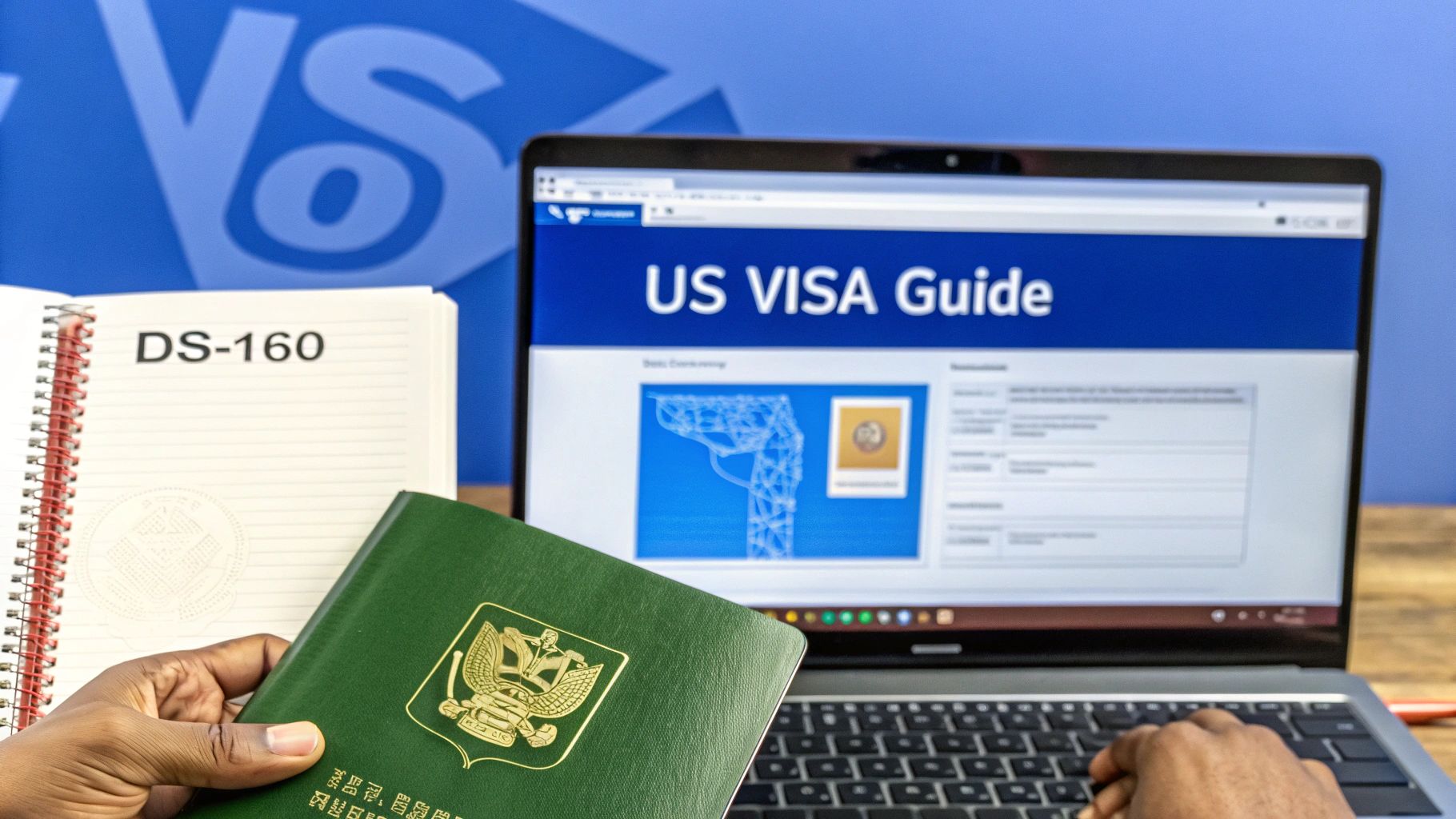
How to Apply for a US Visa in Nigeria: A Practical Guide
Applying for a U.S. visa from Nigeria can feel like a huge mountain to climb, but it’s a journey that thousands of Nigerians navigate successfully every year. It all boils down to a clear, four-part process: picking the right visa, nailing the DS-160 form, handling the fees and appointment booking, and then acing the interview.
Let's break down exactly what this journey looks like, step by step, for an applicant in Nigeria.
Starting Your US Visa Application Journey
First things first, let's get one thing straight: this process is completely manageable if you take it one step at a time. This guide is your personal roadmap, built from the real experiences of applicants just like you in Nigeria.
The absolute first step—and where many people stumble—is choosing the correct visa. Your reason for travel dictates everything.
- Going to visit your sister in Atlanta or see Times Square? That's a B-2 visa.
- Headed for a professional conference in Lagos or a business meeting in Abuja? You're looking at a B-1 visa.
- Accepted into a university to start your degree? The F-1 student visa is what you need.
Getting this wrong from the start can unfortunately lead to a quick denial, so it’s crucial to get it right.
The Four Core Stages
Once you know your visa type, the path forward becomes much clearer. Each stage builds on the last, so you can focus on one thing at a time. This simple flow shows you how it all connects.

As you can see, every part of this process, from filling out the first form to your final interview, is a vital piece of the puzzle.
To give you a clearer picture, here is a high-level summary of what to expect at each point in the application.
US Visa Application Process Overview for Nigerians
Stage Key Action Primary Goal 1. Pre-Application Determine visa type and gather initial documents. To establish the correct application path and build a strong foundation. 2. Online Forms & Fees Complete the DS-160 form and pay the MRV fee. To formally submit your personal details and secure your eligibility for an interview. 3. Appointment Scheduling Book your visa interview and biometrics appointments. To get a confirmed date and time at the U.S. Consulate or Embassy. 4. The Interview Attend the in-person interview with all required documents. To demonstrate your intent and strong ties to Nigeria to the Consular Officer. This table maps out your entire journey, making it easier to track your progress and prepare for what's next.
Understanding Your Chances
Now for some context. Nigeria consistently has one of the highest demands for U.S. visas in Africa. In the 2024 fiscal year alone, U.S. consulates in Nigeria issued around 72,463 visas—more than any other country on the continent.
While the global approval rate hovers around 72.2%, it's important to know that applications from Nigeria often receive extra scrutiny, especially concerning ties to home. This just means your preparation has to be top-notch.
Here’s the single most important piece of advice I can give any Nigerian applicant: Your entire application—every word on your DS-160 and every answer in your interview—must paint a clear picture of the strong economic, family, and social ties pulling you back to Nigeria after your trip.
Before we get into the nitty-gritty of the required documents, it's a good idea to understand the general visa requirements for foreign travel to see how the U.S. process fits into the bigger picture.
When you're ready to start gathering your paperwork, our detailed guide on https://blog.japachat.com/us-visa-requirements/ will give you a complete checklist. Starting with the right documents will put you on the path to success.
Mastering the DS-160 Form for Nigerian Applicants
Let's be clear: the DS-160 form is the absolute foundation of your entire US visa application. It's not just another piece of paperwork; it's your official story, the first and most detailed impression you'll make on the U.S. government. Every single detail you enter will be scrutinised, so honesty and accuracy aren't just important—they're everything.
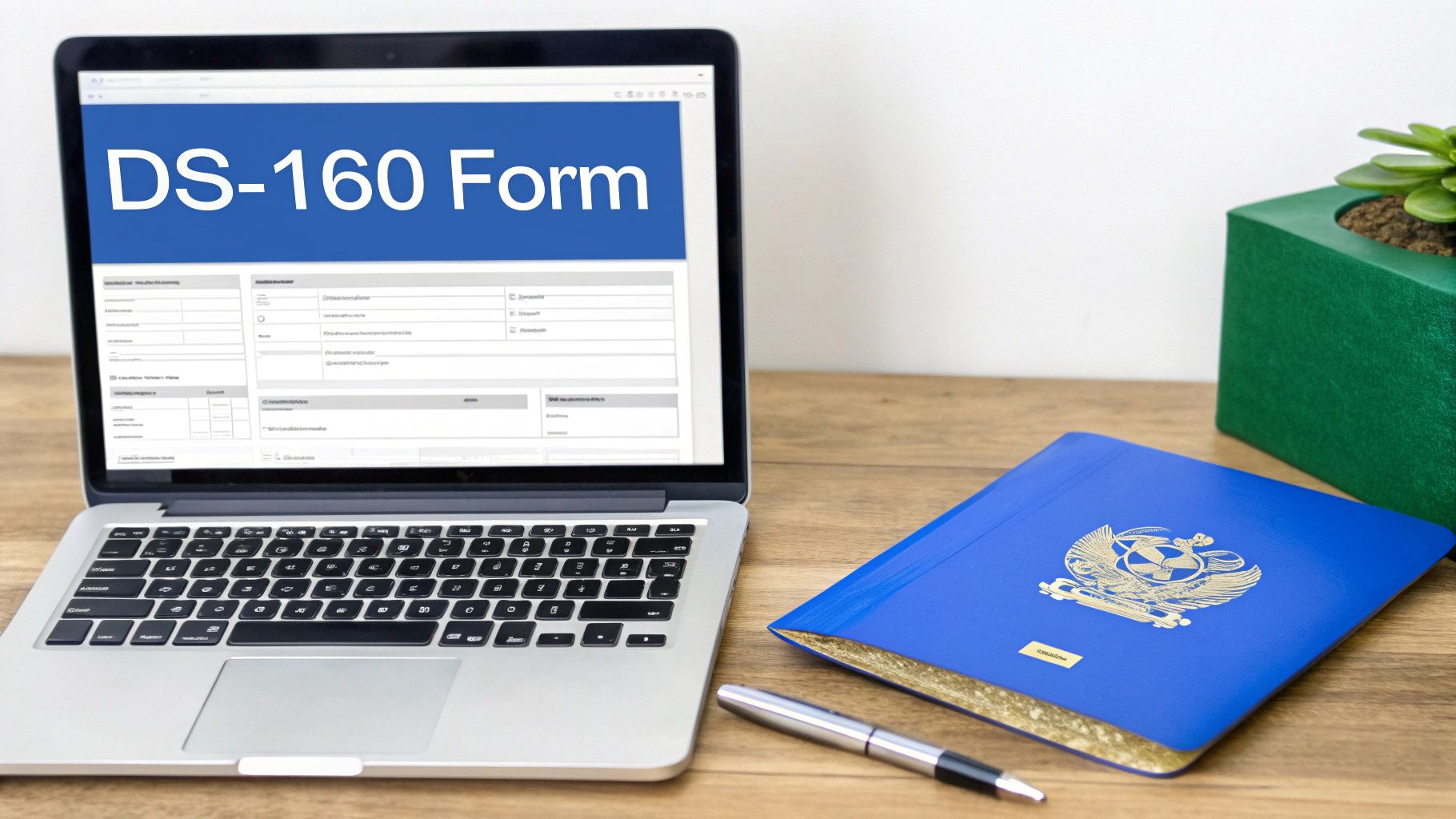
Think of it this way: a rushed or sloppy DS-160 waves a massive red flag before you even step foot in the embassy. It gives the consular officer an easy reason to say "no."
Choosing Your Visa Category Correctly
Before you type a single word, you have to be 100% sure about your visa category. This is the very first thing the DS-160 asks for, and picking the wrong one is a common, costly mistake that can derail your application from the start.
For most Nigerians, it boils down to a few key types:
- B1/B2 (Visitor Visa): This is the go-to for most applicants. It covers everything from tourism and visiting family to attending short business conferences. If you're planning to see your brother in Houston or attend a tech summit in Silicon Valley, this is the one for you.
- F1 (Student Visa): This is strictly for academic purposes. If you've been accepted into a U.S. university, college, or any other academic institution, this is your category.
- H-1B (Specialty Occupation Worker): This one is for professionals who have a job offer from a U.S. employer in a specialised field. Crucially, your employer has to file a petition on your behalf before you can even apply.
Getting this right sets the tone for your entire application. If you select "B2" for tourism but all your answers point towards looking for a job, you've created a huge contradiction that officers are trained to spot instantly.
Tackling Key Sections of the DS-160
Completing the DS-160 is a marathon, not a sprint. Give yourself a couple of hours of uninterrupted time, gather all your documents, and prepare to answer some very personal questions truthfully.
Presenting Your Employment History
This section is where you prove you have strong ties to Nigeria. It's your chance to show you have a life and career to come back to. Be specific.
Instead of writing "Trader, Alaba Market," paint a detailed picture: "Self-Employed Electronics Trader, Alaba International Market, Lagos. I have operated my business, 'Chukwudi Electronics Hub,' since 2015, importing and selling consumer electronics. My monthly income is approximately ₦XXX,XXX." See the difference? One is vague; the other shows stability and a real, established life.
Detailing Your Family Connections
List your immediate family—parents, spouse, children—with perfect accuracy. Even if they aren't travelling with you, their presence in Nigeria acts as a powerful anchor. Double-check that every name and date of birth matches their official documents exactly.
Crucial Tip: Never, ever lie about a previous visa denial. When the form asks, "Have you ever been refused a U.S. Visa?" the only answer is the truth. The embassy has detailed records. A lie here is considered misrepresentation and can get you permanently banned. Just briefly and honestly explain what happened.
Declaring Your Travel History
Your travel history shows that you're a genuine traveller who respects immigration laws. List every country you've visited in the last five years. Trips to the UK, Dubai, or even neighbouring Ghana where you returned on time all add to your credibility.
If you have no travel history, don't panic and definitely don't make things up. Plenty of first-time travellers get approved. It just means you'll need to put more emphasis on proving your other ties, like your job and family.
Navigating Financial and Sponsor Information
This is another area where many Nigerian applicants stumble. If you're sponsoring yourself, your bank statements need to show a consistent flow of income and savings. A sudden, large deposit that appeared out of nowhere a week before your application is a major red flag.
If someone else is sponsoring your trip—like a sibling in the U.S. or a parent in Nigeria—you must state this clearly. You'll need to provide their information and proof of their financial stability, such as their bank statements or a formal affidavit of support.
The U.S. visa process is incredibly competitive, and knowing the numbers helps put things in perspective. In January 2025 alone, 6,075 B1/B2 visas were issued to Nigerians, making it the top category. But refusal rates are still high, mostly due to "Section 214(b)," which is a formal way of saying the applicant didn't convince the officer they would return home. You can dig into more detailed U.S. visa statistics for Nigerians to see the trends for yourself.
Handling Visa Fees and Scheduling Your Appointment
You've submitted your DS-160. Take a deep breath—that’s a huge step out of the way. Now, let's get into the practical side of things: paying the visa fee and locking down that all-important interview date. This part requires close attention to detail, but it's pretty straightforward once you know how it works in Nigeria.
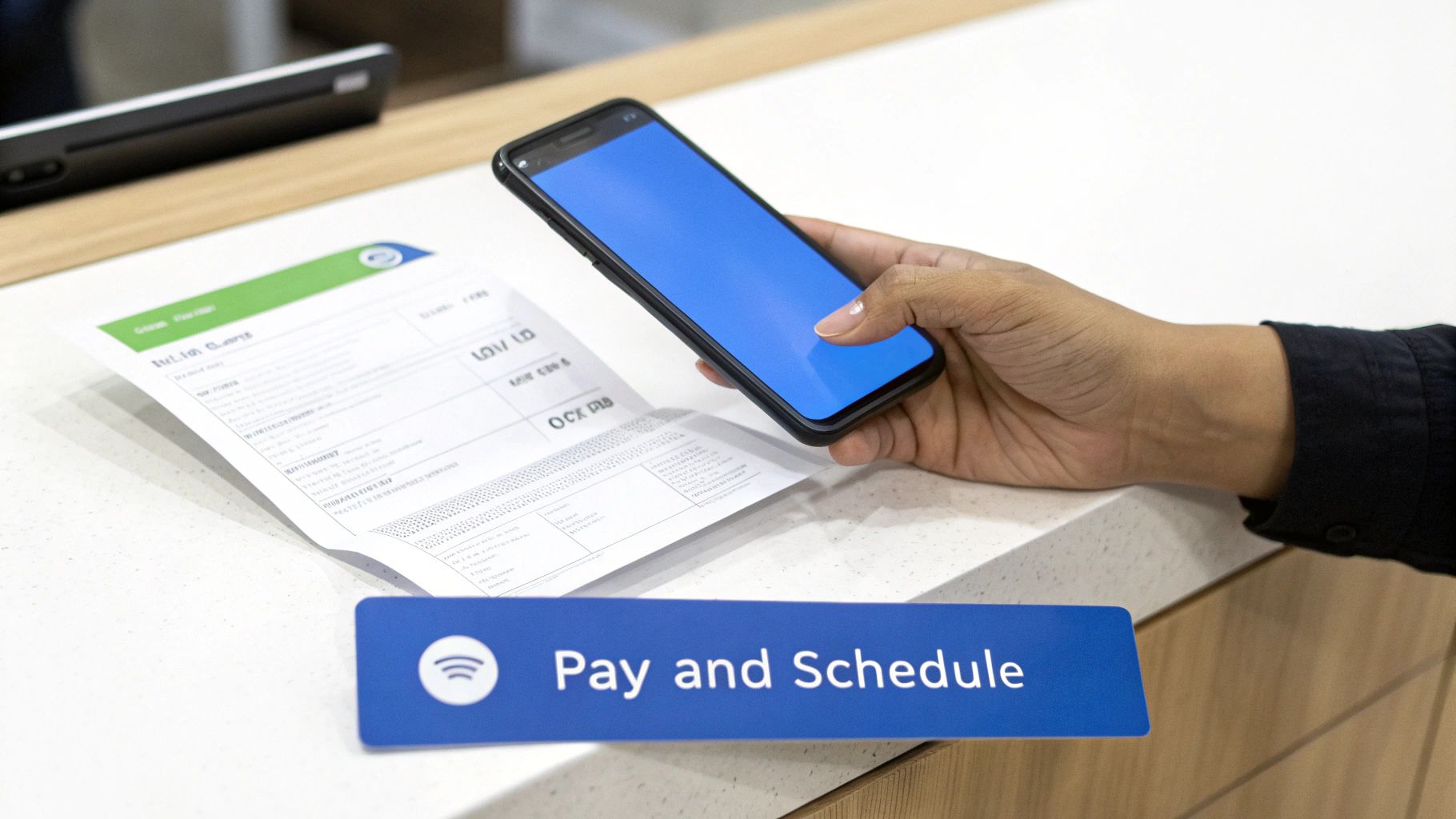
This is the point where your application moves from digital forms to real-world action. Getting this right is crucial to avoid any frustrating delays.
Paying the MRV Fee in Nigeria
First up is the Machine Readable Visa (MRV) fee. This is a non-refundable, non-transferable payment that every single applicant has to make. The cost changes based on your visa type and, of course, the ever-fluctuating exchange rate. Always, always check the current Naira equivalent on the official U.S. travel documents website before you do anything else.
In Nigeria, you can’t just pay online with your card. You have to make an in-person cash deposit at a Guaranty Trust Bank (GTBank) branch. But you can't just show up at the bank; you need a specific, system-generated deposit slip first.
Here’s exactly how you do it:
- Create a Profile: Your first stop is the CGI Federal website, which is the official visa service partner for the U.S. Mission in Nigeria. You'll need to create a profile with your personal information, passport number, and that DS-160 confirmation number you just got.
- Generate the Deposit Slip: After setting up your profile, find the payment section. The portal will create a unique U.S. visa fee collection slip just for you. Print this out. It has a CGI reference number that is tied only to your application.
- Make the Payment: Take that printed slip to any GTBank branch. You’ll pay the fee in cash, and the teller will hand you a receipt. Treat this receipt like gold. It contains the MRV receipt number you absolutely need for the next step.
My Personal Advice: The moment you get that receipt, make a photocopy. Snap a picture of it with your phone. Save it to the cloud. Losing this little piece of paper can cause a massive headache and bring your whole application to a standstill.
Booking Your Interview Appointment
With your MRV receipt number secured, you're finally ready to schedule the interview. Honestly, this can be the most frustrating part of the whole process. Appointment slots in both Lagos and Abuja are in incredibly high demand, so you’ll need a good dose of patience here.
Log back into your profile on the CGI Federal website. You’ll be asked to enter the MRV receipt number from your GTBank payment. It can take up to two business days for the system to validate the payment, so don't panic if it doesn't work immediately.
Once it's validated, the appointment calendar will open up. You'll see the available dates for an interview at the U.S. Consulate General in Lagos or the U.S. Embassy in Abuja. Don't be shocked if the earliest date is months, or even a year, away. This is the reality right now.
How to Find an Earlier Appointment Date
A far-off date doesn't have to be the end of the story. People cancel and reschedule their appointments all the time, which opens up earlier slots. The trick is to be persistent.
- Check at Odd Hours: Many people find earlier dates by logging in late at night or first thing in the morning (Nigerian time), when fewer people are online.
- Check Every Day: Make it a daily habit. Spend five minutes logging in and checking for cancellations. You never know when a spot will open up.
- Be Ready to Click: When you see an earlier date, grab it instantly. These slots can disappear in the blink of an eye.
The landscape for how to apply for a US visa in Nigeria is always changing. For example, recent policy updates have made things even more complex. As of April 22, 2025, your DS-160 confirmation barcode must match your appointment location exactly. Furthermore, from June 18, 2025, F, M, or J visa applicants will need to make their social media profiles public for screening. These new rules have created major appointment backlogs, hitting students especially hard. You can read more about these international student enrollment challenges to see the bigger picture.
Proving Your Strong Ties to Nigeria
Alright, you’ve filled out the DS-160 and booked your interview slot. Now we get to the absolute make-or-break part of your U.S. visa application: proving you have strong ties to Nigeria.
Let's be blunt. The consular officer starts with a simple assumption: everyone wants to immigrate to the U.S. Your job is to prove them wrong. You need to show them a complete, convincing picture of your life in Nigeria—a life you have every intention of returning to.
This isn't about flashing a huge bank balance. It’s about demonstrating deep roots through your job, your family, your finances, and your assets. Every document you bring is a piece of the puzzle, building a strong case that your trip is strictly temporary.
Building Your Case with The Right Documents
Think of these documents as your personal advocates. They tell your story before you even open your mouth. Some are non-negotiable, while others are the supporting cast that can truly make your application shine.
Let’s get into what you need to gather. Knowing what’s essential versus what’s just good to have will help you focus your energy where it counts.
Here's a breakdown of the documents you'll need. We've split them into two categories: the absolute must-haves and the supporting evidence that will seriously strengthen your case.
Essential vs. Supporting Documents Checklist
Document Type Purpose and Importance Nigerian Example Mandatory Documents These are the absolute essentials. Without them, your application is a non-starter. Think of them as your entry ticket to the interview room. Your valid international passport, the DS-160 confirmation page, one recent passport photograph, and your visa fee payment receipt. Employment Evidence This shows you have a steady job or business to come back to. It’s a powerful tie that demonstrates economic stability and responsibility in Nigeria. An employment letter on official company letterhead stating your position, salary, start date, and approved leave for your trip. Financial Stability This proves you can fund your trip without working illegally in the U.S. It also shows you have a consistent and stable financial life back home. Your personal bank statements for the last six months. A steady flow of salary and savings looks much better than a sudden, large deposit. Property Ownership Owning property is a massive indicator that you are settled in Nigeria. It’s a huge financial and personal commitment tying you to the country. A Certificate of Occupancy (C of O), Deed of Assignment, or property tax receipts registered in your name. Family Connections Family is a powerful social anchor. Showing your role within your family demonstrates deep personal responsibilities you need to return to. Your marriage certificate, birth certificates for your children, or proof that you are a primary caregiver for elderly parents. Business Ownership For entrepreneurs, this is your proof of employment. It shows you've built something valuable that needs you in Nigeria to run and grow. Your Corporate Affairs Commission (CAC) registration documents, business bank statements, and a tax clearance certificate. This checklist gives you a solid framework. As you start pulling these papers together, it pays to be organised. You can learn how to organize all your application documents effectively to make sure everything is presented professionally and is easy for the officer to review on the day.
Going Beyond the Basics
Look, just having the documents isn't enough. The quality and context are what really matter. A poorly written employment letter or a dodgy-looking bank statement can actually do more harm than good.
Take your bank statements, for example. Consular officers are trained to spot "funds parking"—when a huge, unexplained amount of cash suddenly appears in your account just before your application. It’s a giant red flag. What they really want to see is a consistent history of income, like your monthly salary, and a clear pattern of savings. It tells a believable story of financial discipline.
The same goes for business owners. Your CAC documents are a great start, but don't stop there. Back them up with recent invoices, client contracts, and business bank statements showing your company is active and making money. This proves your business is a real, ongoing enterprise that needs you back in Nigeria.
A very common mistake is thinking one "killer" document, like a fat bank account, is all you need. The truth is, officers are looking for a web of connections. A good job, a family, property, and stable finances all woven together tell a much more compelling story than one single piece of evidence.
Presenting Your Family Ties
Never underestimate the power of family ties. They are incredibly important. If you’re married with kids, your marriage certificate and their birth certificates are essential. These documents create a core reason for you to return home.
But what if you're single? You can still demonstrate very strong family ties. Do you support your parents financially? Show proof of this, like regular money transfers or a letter explaining your role as their caregiver. This demonstrates a deep sense of responsibility and connection to your family in Nigeria.
Ultimately, your documentation should tell an honest and consistent story. While you don't always need a formal letter of intent for a visitor visa, understanding the logic behind one can help you frame your case. If you're applying for a student or work visa, where the stakes are higher, learning how a letter of intent for a visa application works can be incredibly useful. Think of your supporting documents as the hard evidence that proves every claim you make on your DS-160.
How to Prepare for Your Visa Interview
After all the paperwork and waiting, the interview is your moment to shine. This is your one chance to sit down with a Consular Officer at the Lagos Consulate or Abuja Embassy and personally make your case. How you handle this conversation is often the deciding factor, so walking in prepared and confident is absolutely critical.
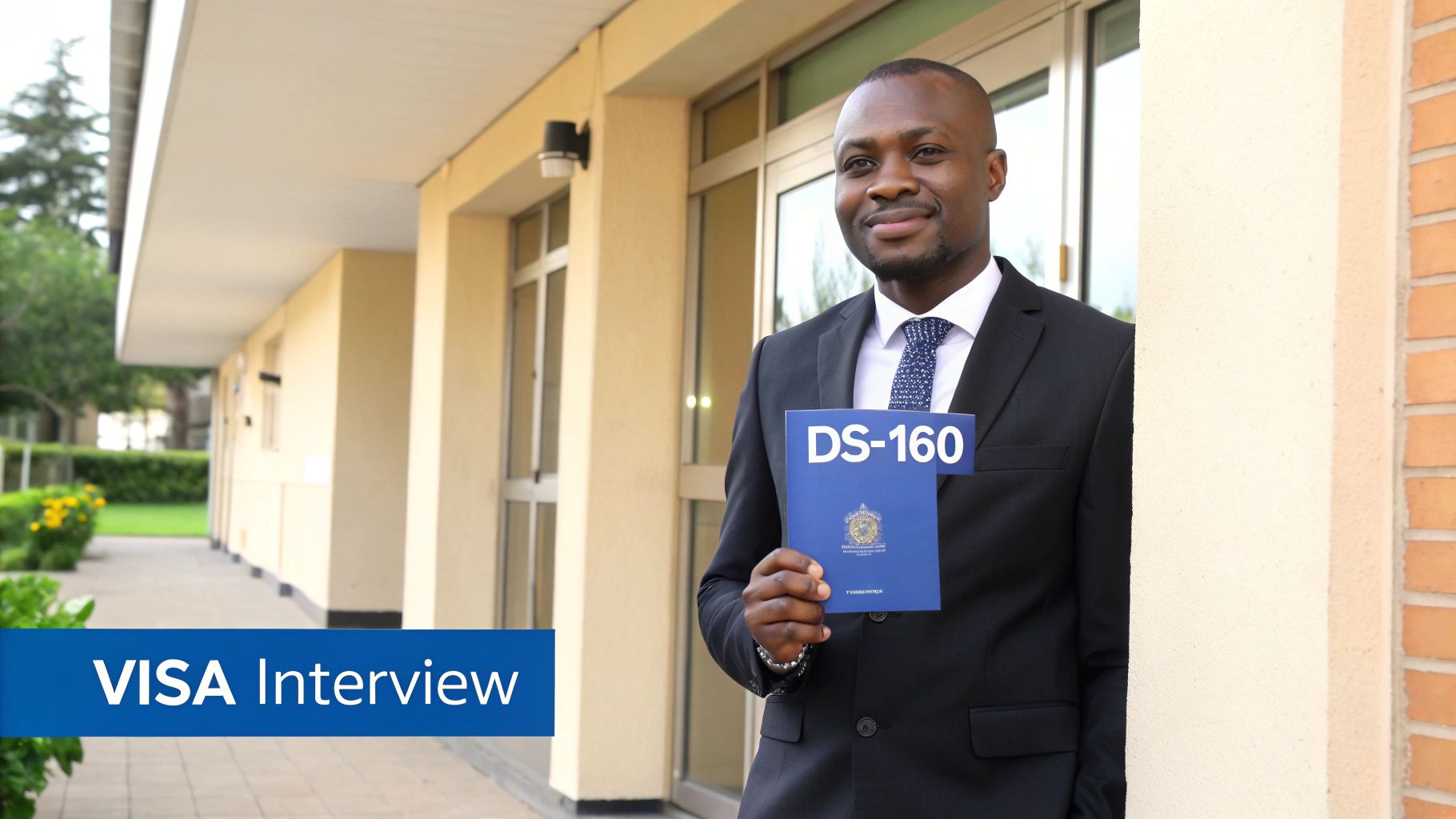
It helps to think of it less like an interrogation and more like a very brief, focused conversation. The officer's job is simple: to verify what you wrote on your DS-160 and to be convinced that you have every reason to come back home to Nigeria. Your goal is to be clear, honest, and straight to the point.
Logistics on the Day of Your Appointment
Your preparation really begins before you even step out the door. The U.S. Embassy and Consulate are notoriously strict, and a small oversight can throw you off your game before you even get inside.
What to Wear
First impressions count, big time. You don't need to show up in a three-piece suit, but you must look presentable and serious. Think business casual. For men, a clean, ironed collared shirt and a good pair of trousers will do the trick. For women, a modest dress, a smart skirt and blouse, or professional trousers are all great options. Definitely avoid anything too casual like shorts, slippers, or flashy, distracting jewellery.
Forbidden Items
Security is no joke. To avoid the headache of being turned away at the gate, it's best to leave the following items at home or with a trusted person waiting for you outside:
- Electronics: This means everything. Your mobile phone, smartwatch, AirPods—any electronic gadget. They are strictly forbidden, and there are no lockers or storage facilities available for you.
- Large Bags: You’re only allowed to bring in a small folder or clear bag with your documents. Leave your backpack or large handbag behind.
- Food and Drinks: No food or beverages of any kind can be brought into the compound.
- Weapons or Sharp Objects: This should be obvious, but absolutely nothing that could be mistaken for a weapon is allowed.
Navigating the Interview Questions
This is where it all comes together. An officer often has just two to three minutes to make a decision about your application. That’s not a lot of time, so your answers need to be direct and impactful. Giving long, rambling stories will only work against you.
The questions will almost always circle back to three main things: your reason for travelling, your financial capacity, and, most importantly, your ties to Nigeria.
Your Purpose of Travel
You need to be specific, and your answer must align perfectly with what's on your DS-160.
- If you stated you're visiting your sister, be ready for follow-up questions like, "What does your sister do for a living?" or "When was the last time you saw her?"
- If you're going for a business conference, you should know the name of the event off the top of your head and be able to explain exactly why attending is important for your job back in Nigeria.
Your Finances
The officer needs to be certain that you can pay for your trip without resorting to working illegally in the U.S.
- If you're sponsoring yourself, state your income clearly and confidently. For instance, "I earn approximately ₦750,000 a month as a software developer."
- If someone else is paying, just be honest about it. "My father, a retired civil servant, is sponsoring my trip. I have his bank statements here."
Your Ties to Nigeria
This is the make-or-break part of the interview. Every answer you give should subtly reinforce the fact that you have strong reasons to return home.
- Question: "What do you do in Nigeria?"
- Weak Answer: "I am a businessman." (This is too vague.)
- Strong Answer: "I own a boutique in Ikeja called 'Lagos Fashions'. I’ve been running it for six years and I have three full-time employees. I have to return to manage the business and pay their salaries."
A great way to structure your answers is what I call the "C-A-R" method: Context, Action, Result. State your situation (Context), explain what you do (Action), and connect it to why you must return (Result). It keeps you focused and makes your answers powerful.
The trick is to sound natural, not like you’ve rehearsed a script for weeks. For a much deeper look at how to frame your responses, check out our detailed guide on common U.S. visa interview questions and answers; it has more examples specifically for Nigerian applicants.
Common Pitfalls to Avoid
I’ve seen too many good applicants get denied over simple mistakes. Be very mindful of these common traps:
- Inconsistent Answers: If your verbal answer contradicts what's on your DS-160, it's a huge red flag. Know your application inside and out.
- Vague Responses: Avoid one-word answers, but don't tell your life story either. Find that sweet spot of being concise yet comprehensive.
- Arguing with the Officer: If you get a denial, never argue. You can politely ask for the reason, but accept the decision gracefully. An argument can seriously damage your chances for any future applications.
- Presenting Fake Documents: This is the absolute worst thing you can do. If you're caught—and they are very good at catching fakes—you'll likely be banned from entering the U.S. for life. Honesty is always the only policy.
Got Questions? Here Are Some Straight Answers
Applying for a US visa can feel like a maze. Let's clear up some of the most common questions Nigerians have with direct, no-nonsense answers.
What's the Number One Reason for Visa Denial in Nigeria?
Nine times out of ten, it’s a refusal under Section 214(b) of US immigration law.
This isn't a permanent ban. It just means the consular officer wasn't convinced you have strong enough ties to Nigeria to make you come back home after your visit. Your job is to prove you're not an intending immigrant.
So, how do you do that? You need to show deep roots. Think of it as painting a picture of your life in Nigeria.
- A steady job, backed up by an official employment letter.
- Proof of property, like a Certificate of Occupancy (C of O) or land documents.
- Bank statements that show a consistent flow of income, not a suspicious, last-minute lump sum.
- Strong family ties, proven with marriage and birth certificates.
When you're in the interview, talk about your life here. Your business, your family responsibilities, your community involvement—anything that anchors you to Nigeria is what they need to hear.
How Long Will I Wait for an Interview in Lagos or Abuja?
Honestly, the wait time is very long and unpredictable. For B1/B2 visitor visas, the wait can easily be over a year due to the massive backlog.
Student (F1) and work visa appointments are given higher priority, but even those slots are limited and get taken very quickly.
Pro Tip: Your best bet is to apply way ahead of when you plan to travel. Always, always check the official U.S. Embassy & Consulate in Nigeria website for the latest, most accurate wait times. Don't rely on hearsay or what someone told you on a forum.
Should I Use a "Visa Agent" for My Application?
I strongly advise against it. It's much safer and more effective to fill out the application yourself. The DS-160 form is designed for you to answer questions about your own life, and nobody knows that better than you.
Using an agent, sometimes called a "visa consultant," opens you up to huge risks. They might make a mistake or, worse, deliberately enter false information on your form to make your case look "stronger." If the embassy finds out—and they often do—it can lead to an instant denial and even a long-term ban for misrepresentation.
By following the official instructions and using a reliable guide, you stay in complete control of your own story.
My Visa Was Approved! What Happens Next?
First off, congratulations! That's a huge relief. The consular officer will keep your passport after the interview; you won't get it back the same day.
Your passport, with the new US visa inside, will be sent to the DHL pickup location you chose when you booked your appointment. You’ll get an email or an SMS telling you it’s ready for collection, which usually takes about 7-10 business days.
Make sure you bring a valid, government-issued photo ID (like your NIN slip, driver's licence, or voter's card) to the DHL office to pick it up. Once you have your passport in hand, open it up immediately and double-check the visa sticker. Look for any errors in your name, date of birth, or passport number.
Planning your journey abroad can be complex, but you don't have to do it alone. JapaChat offers AI-powered guidance to help you navigate every step of your immigration journey with confidence. Get instant answers to your specific questions and access helpful planning tools today. Start for free at JapaChat.
-
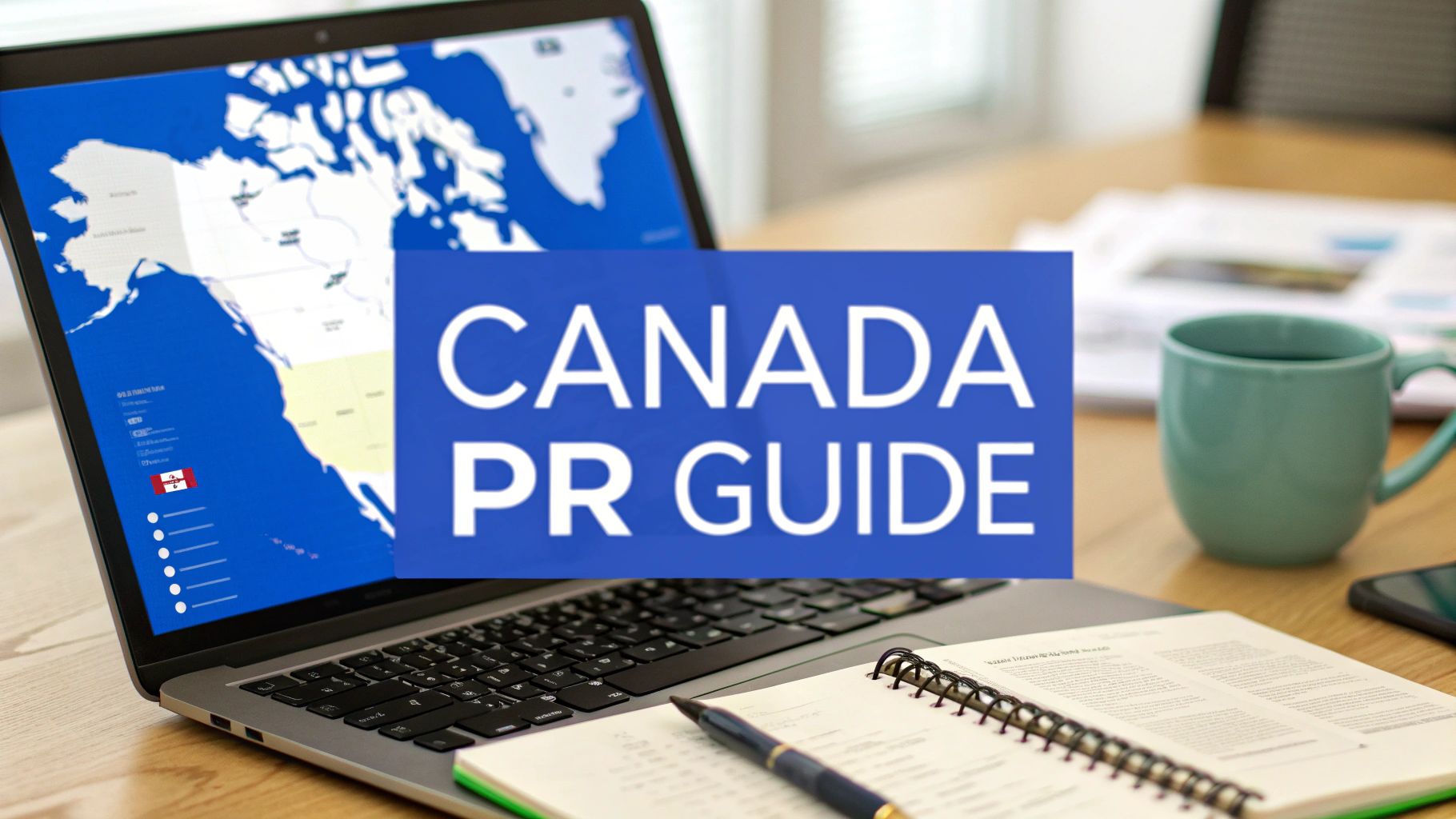
How to Apply for Canada PR: A Practical Guide for Nigerians
Thinking about moving to Canada from Nigeria? It’s a huge, exciting step, but the journey to get your Permanent Residency (PR) can feel pretty overwhelming. It all starts with a few crucial moves: figuring out if you're even eligible, chasing down all the right documents, and then putting together a flawless application.
For us in Nigeria, this comes with its own unique set of headaches, from getting transcripts out of our universities to showing your proof of funds in Naira. A successful application isn't about luck; it's about having a solid, well-thought-out plan.
Your Canadian Dream Starts with a Smart Plan
The idea of starting a new life in Canada is the easy part. The hard part is navigating the complex immigration process from here in Nigeria. A lot of the advice out there is too general and doesn't really get into the specific issues we face.
This guide is different. It's designed to be your step-by-step roadmap, giving you practical advice that actually works, whether you’re in Lagos, Abuja, or anywhere else in the country. We’re not just going to list rules; we'll break down what they mean for you.
Key Focus Areas for Nigerian Applicants
Knowing the Nigerian-specific challenges from the get-go will save you a world of time, money, and stress. Here’s a closer look at what we'll be tackling together:
- Navigating the Pathways: We'll dive into the main options. This includes the famous Express Entry system and the very powerful Provincial Nominee Programs (PNPs). A PNP can be a fantastic alternative if your points score isn't quite high enough for a direct federal invitation.
- Nigerian Document Realities: Getting your documents in order is half the battle. We’ll share practical tips on how to get your degree evaluated by WES, how to secure police clearance certificates, and—most importantly—how to handle the often-frustrating process of getting university transcripts.
- Proof of Funds Explained: This is a big one. With the Naira's exchange rate constantly changing, managing your Proof of Funds is a major source of anxiety. We’ll show you exactly how to present your bank statements and what to do if a family member is gifting you the money.
The goal here isn't just to submit an application; it's to submit a strong one with confidence. This guide is your personal playbook, built to help you sidestep the common mistakes many Nigerians make.
As you plan this major life change, it’s also wise to think about the support you'll need once you arrive. Preparing for the transition mentally is just as important as the paperwork. Knowing where to find anxiety counselling resources in Canada, for example, can be a crucial part of ensuring a smooth and healthy start to your new life. Ultimately, turning that Canadian dream into a reality begins right now, with the very first informed step you take.
Confirming Your Eligibility for Canadian PR
Before you spend a single Naira on application fees or language tests, the first and most critical step is a completely honest self-assessment. The Canadian immigration system is essentially a points-based game, and knowing your score is the only way to find out if you can even get on the field. This is where you figure out if your dream of moving from Nigeria to Canada is a realistic goal right now, or if you need to build up your profile first.
The entire system for skilled workers, which is what most Nigerian professionals use, is built around the Comprehensive Ranking System (CRS). Think of it as a scorecard. Every piece of your profile—your age, that degree from UNILAG or ABU, your years of experience as a software developer in Lagos or a nurse in Abuja—gets turned into points.
The higher your score, the better your chances of getting that coveted Invitation to Apply (ITA) for permanent residency.
Decoding the CRS Points System
Getting a handle on how these points are awarded is absolutely vital. You don't want any nasty surprises down the line. The points are split across several core areas, and even small differences can dramatically change your total score.
Here’s a quick rundown of the main factors:
- Age: Canada's system favours younger applicants. You get the maximum points if you're between 20-29. After you hit 30, the points start to decrease with each birthday.
- Education: Your Nigerian degree is a major asset, but it has to be officially assessed to count. A Bachelor's, a Master's, or a PhD each have different point values. Having two or more degrees can give your score a healthy boost.
- Work Experience: Canada is looking for skilled professionals. You earn points for the number of years you've worked in a skilled job (what they call NOC TEER 0, 1, 2, or 3). Hitting three or more years of experience will max out your points in this category.
- Language Proficiency: This is a big one. For many Nigerians, it’s the make-or-break factor. Your score on an English test like the IELTS or CELPIP is critical. A high score (aiming for a CLB 9 or 10) can add a massive number of points to your profile.
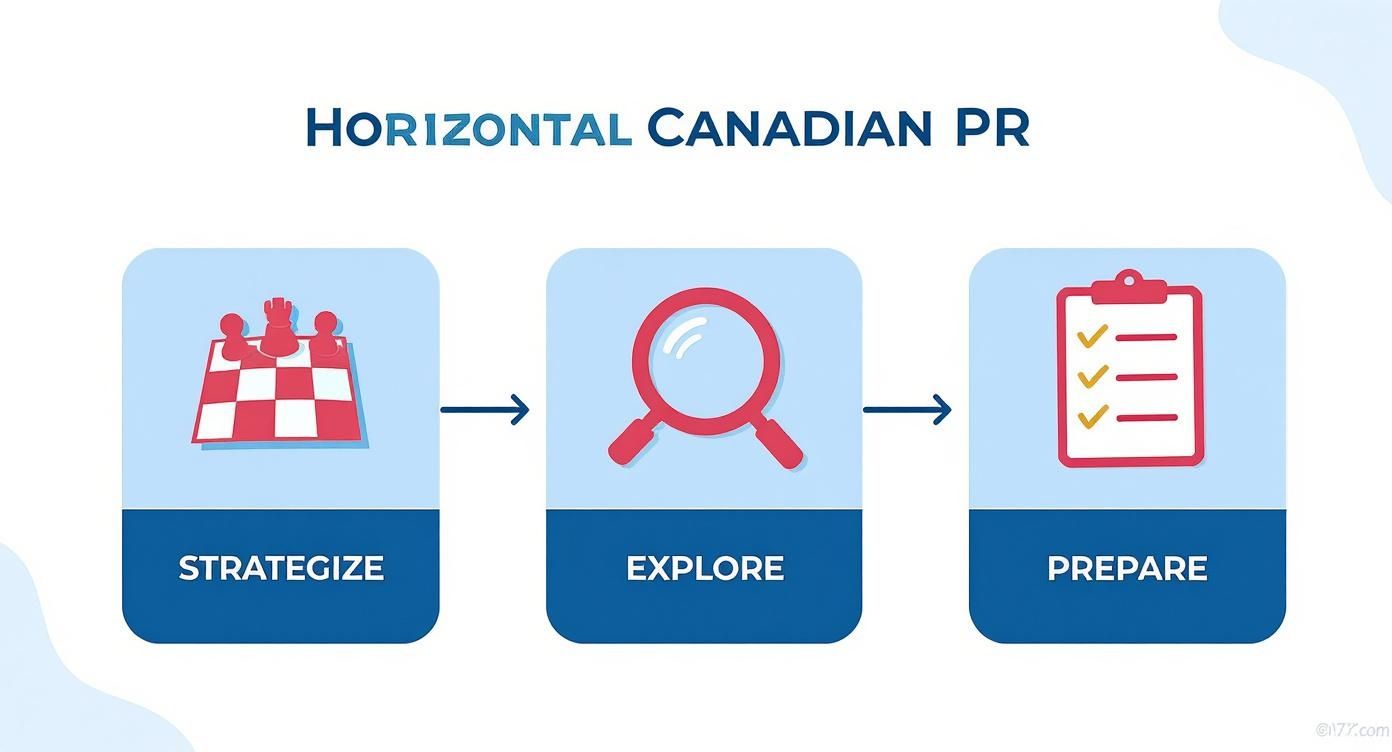
As you can see, a successful application journey begins with a solid strategy. That means knowing your numbers inside and out before you do anything else.
Using the Official CRS Calculator
Guesswork is your biggest enemy in this process. You need to know your exact score. The good news is that Immigration, Refugees and Citizenship Canada (IRCC) provides a free, official tool to do just that.
You simply answer a series of questions about your profile, and it calculates an estimated CRS score for you on the spot.
This exercise isn't just about getting a number; it's about strategy. It helps you pinpoint your strengths and weaknesses. Is your age dragging your score down? Then you know you have to smash your IELTS test to make up for it. Is your work experience your strong point? Great, you can focus your energy elsewhere. For a more detailed walkthrough of this, you can check out our guide on how to calculate your Canada PR points.
Crucial Tip: Be brutally honest with yourself when using the calculator. Don’t enter the IELTS score you hope to get. Use a realistic target based on your mock test results. This is the only way to get a true picture of where you actually stand today.
While the process is competitive, Canada remains very welcoming to newcomers. In fact, the 2021 Canadian Census revealed that immigrants make up 23.0% of the entire population. This shows a sustained, welcoming environment for new arrivals, including the thousands of Nigerians who successfully gain permanent residency each year by meeting these skilled worker criteria.
Your CRS score is your entry ticket. By calculating it accurately from the start, you can build a smart, effective strategy to make your Canadian PR dream a reality.
Getting Your Documents in Order: A Nigerian's Checklist
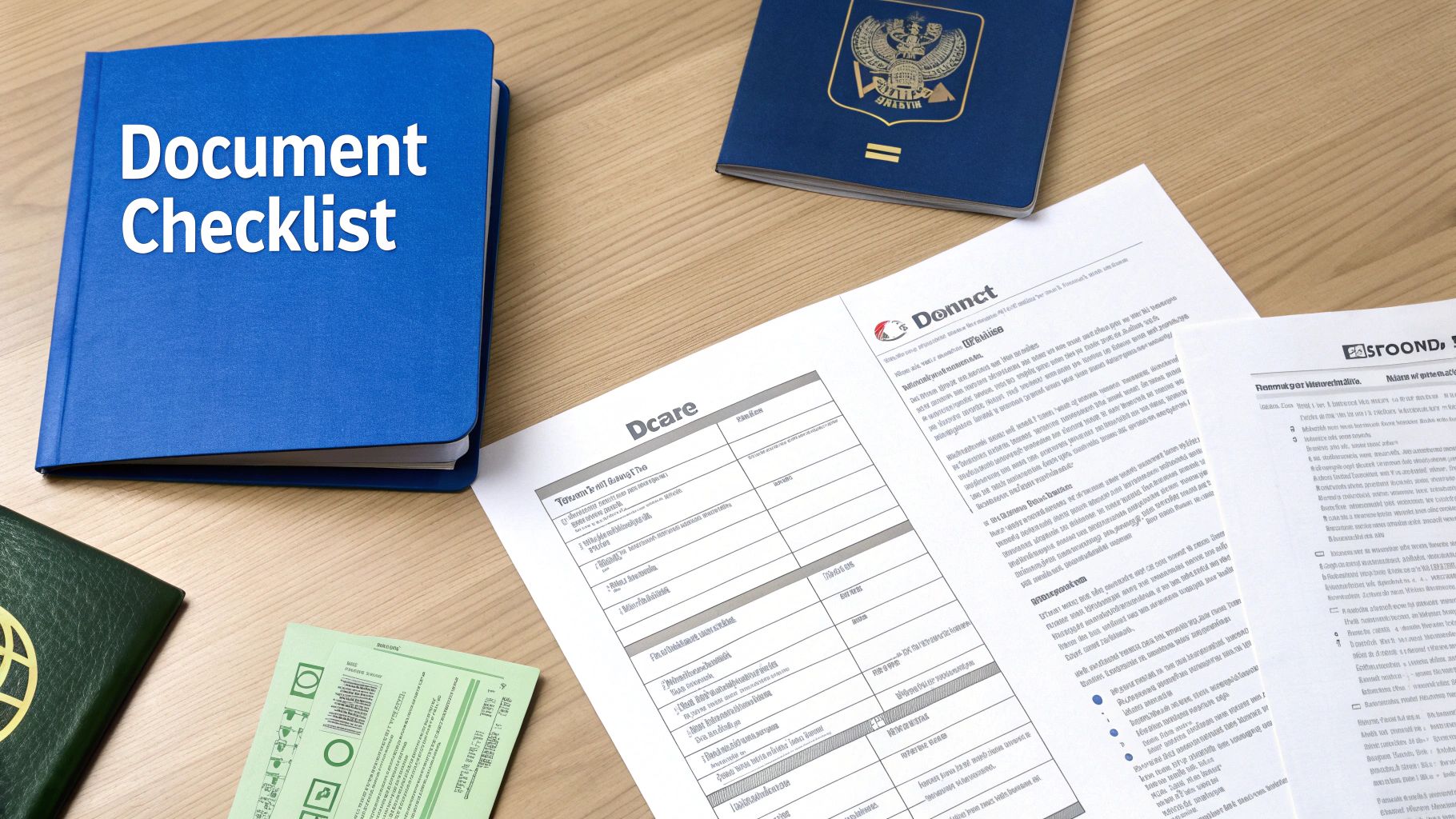
Alright, so you’ve confirmed you’re eligible. Now for the part that trips up so many people: gathering your documents. For Nigerians, this isn't just a simple box-ticking exercise. It's a test of patience, persistence, and organisation.
Think of it like this: a single missing document or a tiny mistake can set your application back by months or, worse, get it rejected outright. Let’s walk through exactly what you need to hunt down and how to handle the common Nigerian hurdles.
Tackling Transcripts and Police Certificates
Getting official paperwork in Nigeria can be… an experience. Two of the most common bottlenecks are university transcripts and police clearance certificates. You absolutely cannot leave these to the last minute.
For your academic transcripts, the process is a lottery depending on your university. Some are getting better, but many federal and state universities operate on their own timeline. If you know your alma mater is notorious for delays, request your transcripts now, even before you have an Invitation to Apply (ITA).
The same goes for the Police Clearance Certificate (PCC). You’ll need to go through the Central Criminal Registry in Alagbon, Lagos, or your state's police command headquarters. The process involves fingerprinting and background checks that can easily take several weeks. Don’t get caught out by underestimating how long this takes.
Expert Tip: When you request your transcripts, don't rely on the university to post them. Pay for a courier service like DHL or FedEx to send them straight to WES (or your designated ECA body). It gives you a tracking number and saves you the headache of lost documents.
The Make-or-Break Proof of Funds
This is where Canadian immigration officers really pay attention, especially with applications from Nigeria. You have to prove, without a shadow of a doubt, that you have enough money to settle in Canada. With the Naira’s fluctuating value, this requires serious planning.
The required amount changes based on your family size and is updated by the Canadian government every year. You must meet the minimum threshold.
Here’s what IRCC will be looking for in your proof of funds:
- A clean history: The money can't just appear out of nowhere. IRCC expects the funds to have been in your account for at least six months.
- No mysterious deposits: A sudden, large transfer of ₦5 million from an uncle a month before you apply will raise red flags. You’ll need a solid explanation.
- Official bank letter: You need a formal letter from your bank on its letterhead, stating your account details, average balance over six months, and the date the account was opened.
If you’re receiving the money as a gift, you’ll need a Gift Deed. This is a sworn legal document where the giver states the money is a true gift, not a loan, and they don’t expect it back. They’ll also need to show proof of their own finances. To get the full picture, you can learn more about the proof of funds for Canada in our detailed guide.
Essential Document Checklist for Nigerian PR Applicants
To help you stay organised, here is a clear checklist of the documents you'll need. Think of this as your master list to guide your entire application process.
Document Nigerian-Specific Notes Key Action Passport Must be valid for at least 6 months past your expected travel date. Renew if necessary, well in advance. ECA Report Start the WES/ICES/etc. process early, especially for transcripts from Nigerian universities. Request transcripts immediately. Language Test Results Book your IELTS or CELPIP test. Your scores must be less than 2 years old when you apply. Schedule your test and start practising. Proof of Funds Bank statements for the last 6 months and an official letter from a recognised bank. Consolidate funds and avoid sudden large deposits. Work Experience Letters Must be on company letterhead with job duties matching your chosen NOC code. Contact current and former employers for reference letters. Police Clearance Certificate Apply at the Nigeria Police Force Central Criminal Registry. Can take several weeks. Apply as soon as you decide to enter the pool. Birth Certificate A certified copy from the National Population Commission (NPC). Locate your original or apply for a certified copy. Marriage Certificate If applicable, a certified copy is required. Ensure you have the official government-issued certificate. Digital Photos Must meet IRCC's specific size and background requirements. Get professional photos taken; do not use selfies. Putting this package together can feel like a full-time job. But remember, the time you invest now in being meticulous and organised is what will lead to a successful application. Start early, track everything, and follow every instruction perfectly.
Choosing Your Best Immigration Pathway
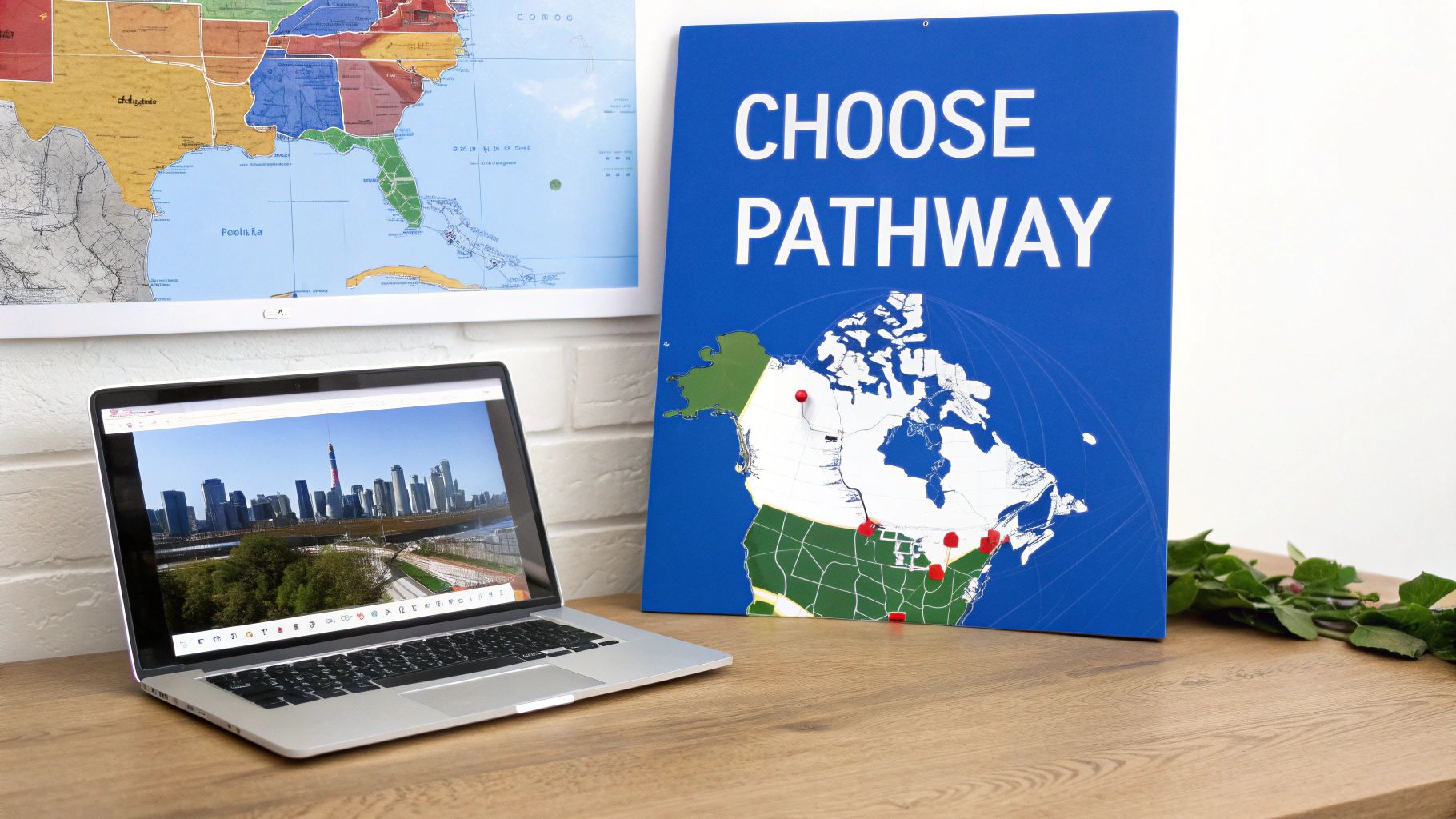
So, you've calculated your Comprehensive Ranking System (CRS) score. Now the real work begins. This is where you shift from dreaming about Canada to building a smart, solid plan to get there. For most Nigerian professionals, the journey to permanent residency involves two main highways: the well-known Express Entry system and the often-underestimated but powerful Provincial Nominee Programs (PNPs).
Getting your head around the difference between these two is absolutely critical. Think of Express Entry as the national talent competition—a massive pool of skilled people from all over the world, all ranked by their CRS scores. In regular draws, Immigration, Refugees and Citizenship Canada (IRCC) invites the highest-scoring candidates to apply.
But what if your score isn't quite hitting those top numbers? That’s precisely where the PNPs come in as your secret weapon.
The Power of Provincial Nominee Programs
PNPs are a total game-changer. They allow individual Canadian provinces to hand-pick and nominate candidates whose specific skills and work experience are needed in their local economies. For Nigerians, this opens up a whole new world of possibilities.
Imagine a software developer in Lagos with a CRS score of 470. In the main Express Entry pool, they could be waiting months, just hoping the cut-off score drops. But if a province like Ontario or British Columbia runs a tech-specific draw, that same developer could get a "Notification of Interest" directly from the province.
Accepting that provincial nomination is like hitting the jackpot. It instantly adds a massive 600 points to your CRS score. That kind of boost practically guarantees you’ll get an Invitation to Apply (ITA) in the very next Express Entry draw.
This 600-point bonus is the single most powerful tool you have to skyrocket your score. It transforms your profile from just another application in a crowded pool to a top-tier candidate on a fast track to PR.
Canada's reliance on these economic programs is clear. The Multi-Year Immigration Levels Plan for 2024-2026 aims to welcome around 380,000 new permanent residents each year, with economic immigrants making up about 239,800 of those spots by 2026. This shows just how many opportunities are available for skilled Nigerians. For more on this, you can check out Canada's ambitious immigration targets on Canadavisa.com.
Matching Your Skills to Provincial Needs
The key to making PNPs work for you is research. You have to look beyond the big, famous cities and find out which provinces are actively looking for someone with your exact profession.
Let's say you're a registered nurse in Abuja. The federal Express Entry pool is fiercely competitive for nurses. However, provinces like Saskatchewan, Manitoba, or Nova Scotia often have specific streams for healthcare workers because they're facing critical shortages. By applying directly to one of their PNP streams, you could completely bypass the high CRS cut-offs of the general draws.
Here’s how you can target your approach:
- For Tech Professionals: Keep a close eye on Ontario's Human Capital Priorities stream and British Columbia's Tech draws. They frequently invite people with experience in software development, data science, and cybersecurity.
- For Healthcare Workers: Provinces like Saskatchewan (through its International Health Worker EOI pool) and Nova Scotia (with its Labour Market Priorities stream) are excellent targets for doctors, nurses, and other health professionals.
- For Skilled Trades: If you're a welder, electrician, or mechanic, programs like the Alberta Advantage Immigration Program or the Ontario Skilled Trades stream should be on your radar.
This targeted strategy takes more effort than just creating an Express Entry profile and waiting. It means actively monitoring provincial government websites, understanding their unique rules, and sometimes submitting a separate "Expression of Interest" (EOI) directly to the province.
Express Entry Aligned vs. Direct PNP Streams
It’s also crucial to understand that PNPs come in two main flavours: those linked to Express Entry and those that are not.
- Express Entry-Aligned PNPs: These are the streams that grant you the 600 bonus points. The catch? You must already have an active Express Entry profile to be considered. This is usually the fastest route, as your final PR application is processed through the federal system.
- Direct (or Base) PNPs: With these, you apply straight to the province. If you get nominated, you then submit a paper-based application for permanent residency to IRCC. This process is generally much slower than the Express Entry route.
For most Nigerian applicants, the goal should be to secure an Express Entry-aligned provincial nomination. To do that, your very first step must be creating a complete and accurate profile in the federal pool. If you need a detailed walkthrough, our guide on creating an Express Entry profile is a great place to start.
Ultimately, choosing your pathway isn’t an "either/or" decision. It’s about using both systems together. Your Express Entry profile gets you in the game, but a sharp focus on PNPs could be the move that wins it for you.
Exploring Canada's Rural and Community Immigration Pilots
When most Nigerians dream of moving to Canada, the first places that come to mind are usually Toronto, Vancouver, or maybe Calgary. But here’s a piece of advice from someone who’s seen it all: focusing only on these big cities means you might be overlooking some of the smartest and quickest paths to permanent residency.
Canada is a vast country, and many smaller, welcoming communities are actively searching for new people to join them. This is where special immigration pilots come in. These aren't your standard immigration streams; they're designed to bring skilled workers like you directly to the towns and rural areas that need your talent. For many, this has proven to be a much more direct route than fighting it out in the hyper-competitive Express Entry pool.
A Different Way to Get Your PR
Let me put it this way. Instead of being one of thousands of highly qualified people in the Express Entry system, all hoping for an invitation, you could be one of a handful of candidates being considered by a community that genuinely wants you to move there. This is the whole idea behind programs like the Rural and Northern Immigration Pilot (RNIP) and the newer community-focused streams that are replacing it.
The entire process is flipped on its head. It’s less about a faceless CRS score and more about making a direct connection with a specific, designated community.
Here’s a look at how it generally works:
- First, you need to find a real, full-time job offer from an employer in one of the participating communities.
- Next, you have to meet that particular town's own set of requirements. They might be looking for people with experience in certain local industries or simply want to see that you genuinely plan to put down roots there.
- Once you’ve got a job offer and meet their criteria, the community's economic development board will officially recommend you for permanent residency.
- With that community recommendation in hand—which is a massive boost—you then submit your PR application to the Canadian government (IRCC).
What's Life Really Like in a Smaller Canadian Town?
I get it. You're probably wondering if you'll find a good job, if there's a Nigerian community nearby, or even where you’ll find a shop to buy egusi and stockfish. It’s true, you won’t find the same massive Nigerian population you’d see in a place like Brampton, but what you often find instead is a tight-knit and incredibly supportive community.
Living in these towns comes with some major perks that are almost impossible to find in the big cities:
- A Lower Cost of Living: Your money simply goes further. The rent for a proper family home can be a tiny fraction of what you’d pay for a small apartment in a major city.
- A Real Community Vibe: People are often friendlier and more welcoming. It's so much easier to build genuine connections and feel like you truly belong.
- Far Less Competition: With fewer people applying for the same jobs, you have a much better chance of standing out and landing a great role.
Picture this: you land a job as an accountant in a city like Thunder Bay, Ontario. The official community endorsement you get could seriously fast-track your PR application. This means you could settle your family much faster and for far less money than if you were aiming for downtown Toronto.
Canada’s immigration strategy is shifting to spread the benefits of immigration beyond just the major urban hubs. Programs like the RNIP create these unique pathways by making sure participating communities have both jobs and solid settlement services ready for newcomers.
These spots are valuable and can be competitive. In the past, high demand has even caused some regional pilots to temporarily pause new applications, which just goes to show how popular these routes are becoming. You can find more details about these community-driven pilot programs on Canadavisa.com.
Thinking outside the box and looking beyond the usual destinations isn't just a suggestion—it could be your golden ticket to becoming a Canadian permanent resident.
Common Questions from Nigerian PR Applicants
Navigating the Canadian PR process from Nigeria throws up all sorts of unique questions. Once you’ve done the heavy lifting—figuring out your eligibility, gathering documents, and choosing a pathway—a new set of practical, "what-if" scenarios will start popping into your head.
This section is all about giving you clear, straight-to-the-point answers to the most common issues we see Nigerian applicants face. Think of it as a quick guide built from the real-world experiences of people who have successfully made the move.
Let’s get into some of the questions you're probably asking yourself right now.
What Is the Next Step After Receiving an ITA?
Getting that Invitation to Apply (ITA) is a huge moment! It’s the email from IRCC that says you’ve been picked from the Express Entry pool. But this is where the clock really starts ticking—you have just 60 days to get a perfect and complete application submitted.
First, take a moment to celebrate. Then, get straight to work. Your first job is to do one last, meticulous check of every single document. This isn't the time to start gathering new paperwork; everything should have been ready to go beforehand.
Here’s what you need to do immediately:
- Final Document Check: Line up every document—your WES report, IELTS results, proof of funds, and every single work reference letter. Make sure nothing has expired and that all the details still match your Express Entry profile to the letter.
- Book Your Medicals: You need to get an upfront medical exam done by an IRCC-approved panel physician in Nigeria. Book this appointment right away, as slots can fill up fast.
- Get Your Fees Ready: You'll need to pay both the application processing fees and the Right of Permanent Residence Fee (RPRF). Have a valid credit card on hand to make the payment online.
How Do I Handle My NYSC Certificate?
Ah, the classic NYSC question. Many applicants wonder if their National Youth Service Corps experience can be counted as skilled work experience.
The short answer is almost always no.
IRCC is very specific: skilled work experience must be paid employment. Since NYSC is a mandatory government programme with a stipend, not a formal salary, it doesn't usually meet the criteria for claiming CRS points.
However, your NYSC certificate is still an important part of your personal history. You absolutely should declare the experience in the "Personal History" section of your application to ensure there are no gaps in your timeline. Just be honest and clear about what it was.
Crucial Tip: Never try to pass off your NYSC service as one year of skilled work to boost your CRS score. This can easily be seen as misrepresentation, a serious offence that could get you banned from applying to Canada for five years.
What Are Common Reasons for Refusal?
Knowing why other applications get rejected is one of the smartest ways to protect your own. For Nigerian applicants, refusals often boil down to a few common, and totally avoidable, mistakes.
Here are the top reasons we see applications get refused:
- Insufficient Proof of Funds: This is a big one. The funds must be yours and readily available. You have to prove the money wasn't just loaned to you for the application. Any sudden, large deposits without a rock-solid explanation (like a properly executed Gift Deed) are a massive red flag for visa officers.
- Misrepresentation: This covers everything from submitting a fake document to failing to declare a family member or a previous visa refusal from any country. When it comes to your application, honesty isn't just the best policy—it's the only policy.
- Incomplete or Inconsistent Information: Little details matter. If the job duties you listed in your reference letter don't line up with your chosen NOC code, or if you have unexplained gaps in your work history, you’re creating doubts. Every piece of information must be consistent across every form and document you submit.
By thinking ahead about these common issues and preparing your documents with care, you put yourself in the best possible position to turn that ITA into a Canadian Permanent Resident visa.
Ready to take the guesswork out of your immigration planning? JapaChat is Nigeria's first AI immigration expert, designed to give you instant, accurate answers to all your questions. Stop relying on hearsay and get the clear guidance you need to make your Canadian dream a reality. Start planning your move with confidence today at https://japachat.com.
-
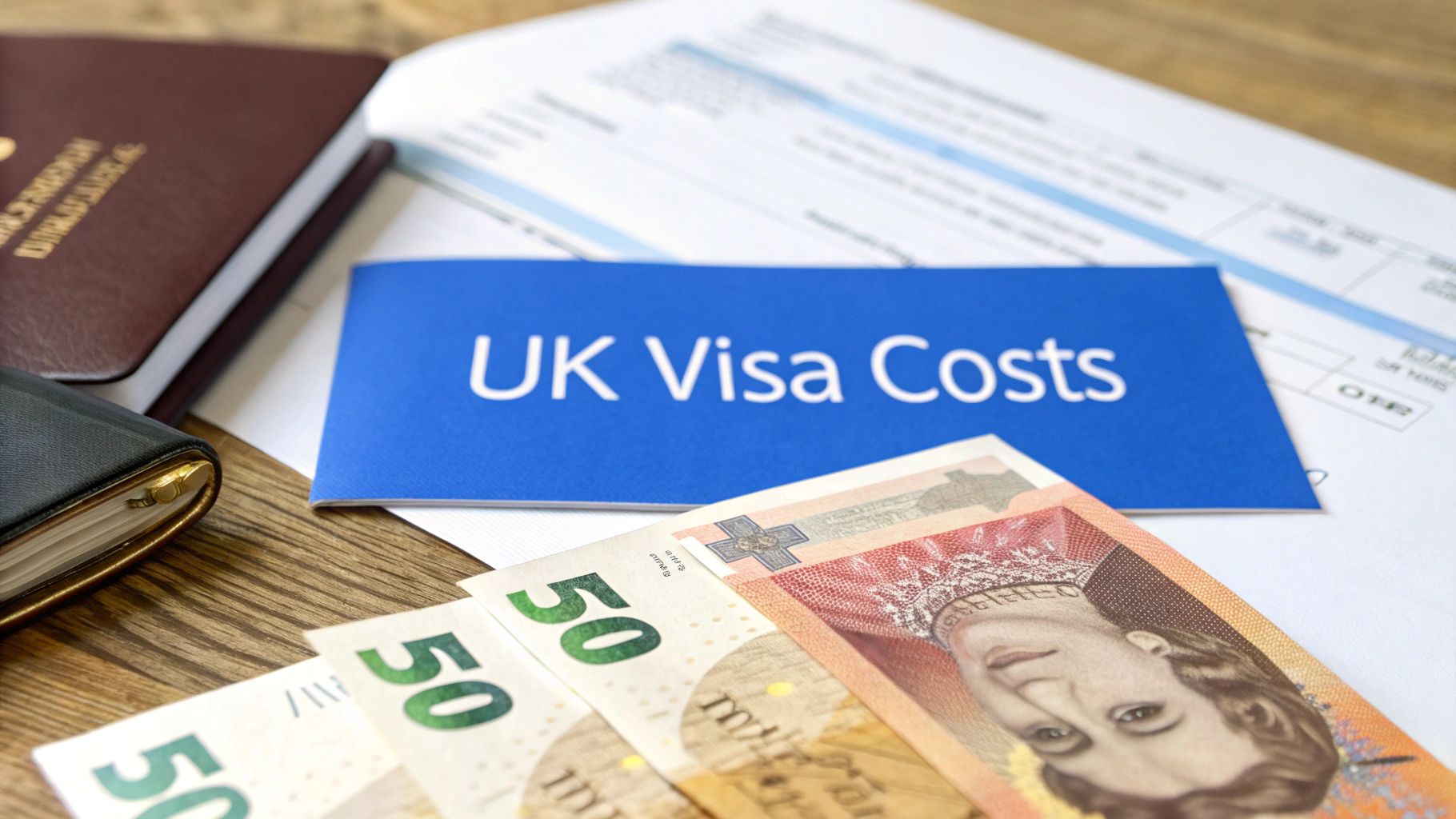
How Much is a Visa From Nigeria to UK: A Practical Guide to Fees & Costs
So, you're asking, "how much is a visa from Nigeria to the UK?" Let's get straight to it. For a standard six-month visitor visa, you're looking at a fee of around $175 USD. With the current exchange rate, that’s roughly ₦370,000.
Of course, that's just the starting point. The final amount you pay in Naira can wobble daily because of the exchange rate. Plus, the costs shoot up quite a bit if you're applying for a longer-term visa or a completely different category, like to "japa" for work or study.
Your Quick Guide to UK Visa Fees in Nigeria
The first thing to get your head around when budgeting for a UK visa is that the official fees aren't set in Naira. The UK government lists them in US Dollars (USD) or British Pounds (GBP), but you'll be paying for it here in Nigeria using our local currency.
This is a crucial detail because it means the exact Naira amount you pay today might be different tomorrow. It all comes down to the exchange rate on the day you pay on the GOV.UK website.
As of early 2024, the costs vary wildly depending on what you're going to the UK for. Here’s a quick look:
- A standard 6-month visitor visa costs $175 (around ₦370,000).
- Need to travel more often? Longer-term visitor visas for 2, 5, or 10 years are priced at $656 (
₦1.38 million), $1,172 (₦2.46 million), and $1,463 (~₦3.08 million) respectively. - If you're heading off to study, a student visa will set you back about $631 (~₦1.52 million).
- For professionals with a job offer, a Skilled Worker visa (for up to three years) starts from £719 (which is over ₦2.1 million).
UK Visa Application Fees for Nigerians At a Glance
To give you a clearer picture, I've put together a table that summarises the standard application fees for the most popular visa types. Remember, these Naira figures are estimates and will change based on the daily exchange rate.
Visa Type Official Fee (USD/GBP) Estimated Cost in Naira (₦) Standard Visitor Visa (6 months) $175 USD ~₦370,000 Long-term Visitor Visa (2 years) $656 USD ~₦1.38 Million Long-term Visitor Visa (5 years) $1,172 USD ~₦2.46 Million Long-term Visitor Visa (10 years) $1,463 USD ~₦3.08 Million Student Visa $631 USD ~₦1.52 Million Skilled Worker Visa (up to 3 years) £719 GBP ~₦2.1 Million This table should help you budget for the main application fee, but it's not the final figure you'll pay.
It's absolutely critical to remember that this application fee is just the beginning. You'll have other mandatory costs layered on top, like the Immigration Health Surcharge (IHS) and biometric enrolment fees. These can significantly increase your total outlay.
Getting a handle on the different categories is your first real step to figuring out the total cost. Before you go any further, make sure you're clear on which of the many UK visa types is the right fit for your trip.
Choosing the Right UK Visa and Its Cost
The first step in figuring out how much your UK visa will cost is knowing exactly which visa you need. It's a bit like booking a flight—the price for a quick trip to Abuja is never the same as a ticket to London. Every UK visa is designed for a specific purpose, and the fee reflects that.
Most Nigerians travelling to the UK are going for short visits, like seeing family, tourism, or a quick business trip. If that’s you, the Standard Visitor Visa is what you'll need. However, if your goal is to study, you'll be looking at a Student Visa. For those lucky enough to have a job offer, the Skilled Worker Visa is the correct path.
Each one has its own price tag, which often changes depending on how long you plan to stay.
Main Visa Categories and Their Costs
Getting your head around the UK visa fee structure can feel a little complicated at first. The prices change based on the visa's type and its duration.
For example, a six-month visitor visa currently costs £127 (around $174), but a long-term 10-year visitor visa will set you back more than £1,000. Student visas are a flat fee of about £524, while Skilled Worker visas can range anywhere from £769 to £1,751, depending on the length of your work contract.
This simple breakdown shows how your purpose for visiting immediately affects the starting cost.
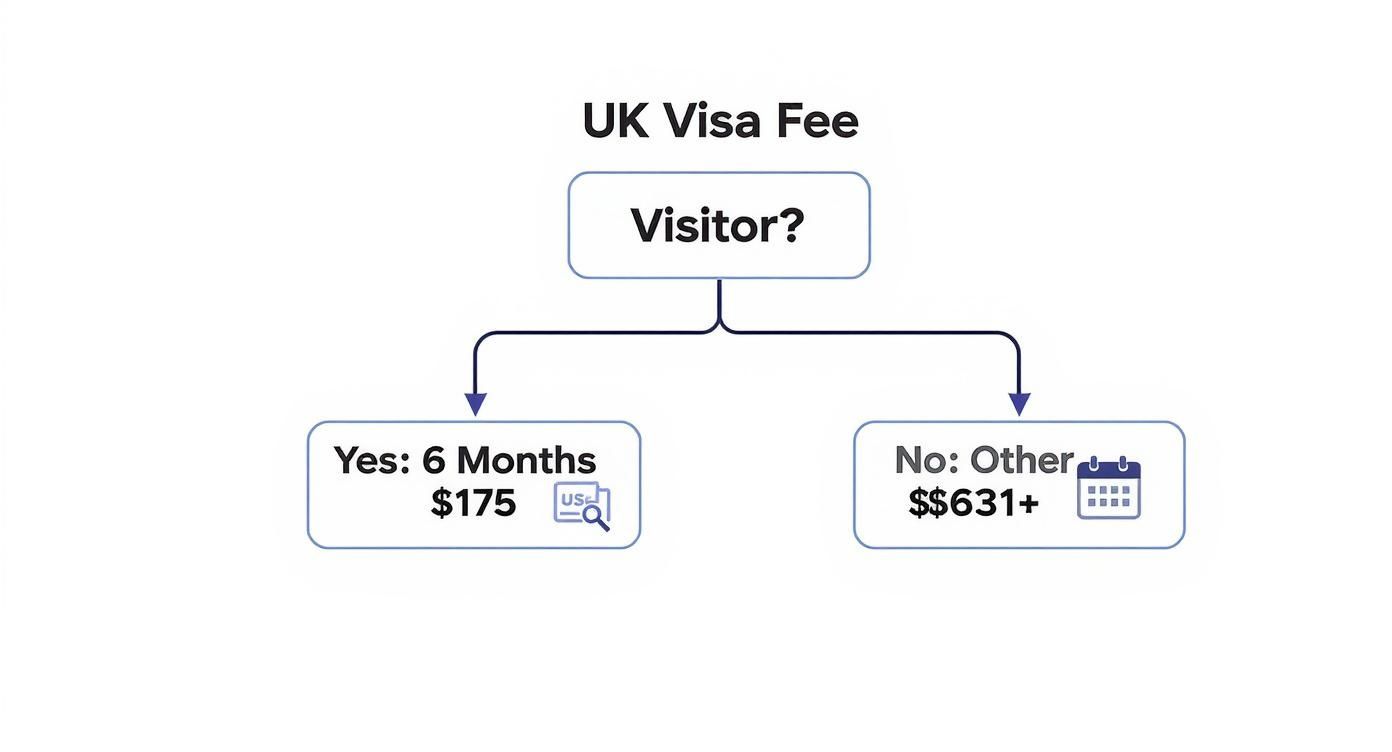
As you can see, visas for long-term purposes like work or study have a much higher base fee than a standard short-term visit.
The key takeaway is this: the longer you intend to stay or the more complex your reason for travelling (like working or studying), the higher your application fee will be. And that's before you even factor in any other costs.
This is why choosing the right visa category from the get-go is the most crucial step in budgeting for your application. If you're planning to work, it’s especially important to get a clear picture of the specific fees involved. You can get the full story on the UK work visa cost in our dedicated guide.
Uncovering the Hidden Costs of Your Application

It’s a common mistake to think the main visa fee is the only number you need to worry about. Unfortunately, that’s just the starting price. Focusing only on that one figure is a bit like buying a car and completely forgetting you'll need to pay for petrol, insurance, and those inevitable maintenance costs.
Several other charges, some mandatory and some optional, will pop up along the way, and they can seriously inflate the total cost of your UK visa journey.
The biggest add-on you'll likely face is the Immigration Health Surcharge (IHS). If you're planning to be in the UK for more than six months—say, as a student or a skilled worker—this one is non-negotiable. It gives you access to the UK's National Health Service (NHS). At £1,035 per year, this fee can quickly run into millions of Naira depending on how long your visa is valid for.
Essential Additional Fees to Budget For
Beyond the IHS, a few other costs are simply part of the package. You have to account for these to get your application successfully submitted.
- Tuberculosis (TB) Test: Coming from Nigeria to the UK for over six months? You’ll need a TB test certificate from a specific clinic approved by the UK Home Office. This will set you back about ₦100,000 for an adult.
- Biometric Appointment: You must visit a TLScontact centre in either Lagos or Abuja to have your fingerprints and photograph taken. The basic appointment is covered by your visa fee, but many applicants end up paying for extra services or more convenient time slots.
- Priority Visa Services (Optional): If you can't wait the standard processing time, you can pay extra to get a faster decision. The Priority or Super Priority services can cost an additional £250 to £1,000. They slash the waiting time but add a hefty chunk to your overall budget.
It's absolutely crucial to factor in every single one of these costs from day one. A small miscalculation or an unexpected fee can throw your entire financial plan off track and even put your application at risk.
Remember, having the money is only half the battle. Being completely honest and accurate in your application is just as important. Any attempt to misrepresent your situation can lead to a refusal and even a ban from applying in the future. You can read more about how to avoid these pitfalls in our guide on visa application misrepresentation.
A Step-by-Step Guide to Paying Your Visa Fees

You’ve meticulously filled out your application, and now you're at the final hurdle: paying the visa fee on the official GOV.UK portal. This part can be a bit nerve-wracking, but knowing what’s coming makes it a whole lot smoother. Payment is the very last step before you can hit 'submit' and book your biometrics appointment.
The payment itself happens online using a debit or credit card. For most people in Nigeria, this will be a Naira-denominated Visa or Mastercard, as long as it's cleared for international transactions. The system handles the currency conversion for you, changing the fee from Pounds Sterling (or sometimes US Dollars) into Naira based on the day's exchange rate.
How to Avoid Payment Problems
One of the most common issues people hit is their bank declining the payment. It's a large, international transaction, and that can sometimes set off a bank’s automatic fraud alerts. Imagine getting a "transaction failed" error after all that work—it's frustrating!
To sidestep this, just follow these simple steps:
- Contact Your Bank First: Before you even get to the payment page, give your bank’s customer service a quick call. Let them know you’re about to make a significant international payment to the UK Home Office.
- Confirm Your Limit: While you're on the phone, ask about your daily international spending limit. If the visa fee is higher, request a temporary increase to cover it.
- Use a Reliable Card: Make sure the card you plan to use has more than enough funds and has a history of successful online payments.
A quick chat with your bank beforehand can save you a world of stress. Taking this simple step helps you avoid the panic of a failed transaction and any delays it might cause to your application.
Why Your Application Fee is Non-Refundable
This is one of the hardest pills to swallow in the entire visa process, but it’s crucial to understand it before you pay a single Naira: your UK visa application fee is almost always non-refundable.
Think of it this way: you’re not buying a visa. You’re paying for the administrative service of having your application professionally reviewed. UK Visas and Immigration (UKVI) puts in the time and resources to go through your file, and that’s what the fee covers. It’s for the work done, regardless of the outcome.
So, whether you get a yes or a no, the work has been completed, which is why you won’t see that money returned if your application is refused.
For Nigerian applicants, this policy has a massive impact. The sheer number of applications coming from Nigeria is huge, making it a major source of income for the UK Home Office. It just goes to show how high the demand—and the competition—really is.
The Financial Stakes Are High
The numbers don't lie, and they really put into perspective why getting your application right the first time is so important.
In the year leading up to June 2024, the UK handled over 225,000 visa applications from Nigerians alone. This brought in more than $24 million in revenue. When you consider the standard visitor visa fee was $150 at the time, you can see how quickly those costs pile up, especially when denials are factored in. To get a better sense of the scale, you can learn more about how the UK earned from Nigerian visa applications in one year.
This isn't just about ticking boxes to meet the visa rules; it's about protecting your hard-earned money. A simple mistake on your form could mean losing a significant sum, with no do-overs and certainly no refunds.
Grasping this from the beginning changes how you should approach everything. It moves you from just "applying" to being absolutely meticulous. Every document, every bank statement, and every detail you provide has to be perfect. The goal is to submit an application so solid that it leaves no room for questions, making sure your money and effort count.
Common Questions About UK Visa Costs for Nigerians
Even with a detailed breakdown, it's natural to have a few more questions popping up. Let's tackle some of the most common queries we see from Nigerian applicants to clear up any lingering confusion.
Can I Pay for My UK Visa in Naira at the Bank?
The short answer is no. You can't just walk into a Nigerian bank to pay your UK visa fee over the counter. The entire payment process is handled online.
This payment is the final step you'll take on the official GOV.UK application portal before hitting 'submit'. You'll need a Naira debit card (like a Visa or Mastercard) that's been cleared by your bank for international online transactions. The system handles the currency conversion for you, charging your card in Naira based on the day's exchange rate.
Is the Immigration Health Surcharge Compulsory for a Visitor Visa?
Thankfully, no. The Immigration Health Surcharge (IHS) isn't something you need to worry about for a Standard Visitor Visa. Since this visa is designed for short stays—like tourism, visiting family, or brief business trips, typically up to six months—the IHS fee doesn't apply.
This surcharge is mandatory for those planning to stay in the UK for longer, such as students on a Student Visa or professionals on a Skilled Worker Visa. Paying it gives you access to the UK's National Health Service (NHS), much like a permanent resident would have.
What Happens to My Money if My UK Visa is Refused?
This is the hard part, and it's a crucial point to understand: if your visa application is refused, the main application fee is non-refundable. This fee covers the administrative work of assessing your application, which happens whether the outcome is a 'yes' or a 'no'.
However, there is some good news. If you applied for a long-term visa (like a student or work visa) and paid the Immigration Health Surcharge (IHS), that portion of your payment will be automatically refunded. The money is sent back to the card you used to pay, though it can sometimes take a few weeks to process.
The fact that the main fee is non-refundable is exactly why getting your application right the first time is so important. It’s not just about securing your visa; it’s about protecting the money you've invested.
Are There Any Ways to Get a Discount on the UK Visa Fee?
Unfortunately, discounts or fee waivers on UK visa applications are extremely rare. They are typically reserved for very specific, severe humanitarian situations, which don't apply to the vast majority of applicants.
For almost everyone applying from Nigeria for a standard visitor, student, or work visa, there are no discounts. You should plan to pay the full, standard fee associated with your chosen visa category.
Planning your move to the UK can feel complex, but you don't have to figure it all out alone. For instant, accurate answers to all your immigration questions, JapaChat is here to help. Get the clarity and confidence you need by visiting the official JapaChat website today.
-

US Visa Fee in Naira: Your Complete Guide for a Smooth Application
So, you're planning a trip to the US? That's fantastic! But before you start dreaming of Times Square or checking out Disneyland, there's a small but crucial hurdle: the visa application fee. For us in Nigeria, this can be tricky because while the official fee is in US dollars, you'll be paying for it right here in Naira.
For the most common non-immigrant visas, like the B1/B2 for tourism or business, you're looking at a $185 fee. It's important to know from the get-go that this money is non-refundable. So, once you pay, you've committed to the process, win or lose.
Current US Visa Fees for Nigerian Applicants
Before you even think about your interview, you have to sort out this payment. Now, here’s a very important point that catches many Nigerians out: the exchange rate used for your visa fee isn't the one you'll find on AbokiFX, Google, or your banking app. The US Mission in Nigeria sets its own special "consular exchange rate," and paying the exact Naira amount based on this rate is non-negotiable.
These fees can also change. The U.S. Department of State reviews and adjusts them periodically. For instance, on June 17, 2023, they increased the application fees for most nonimmigrant visas. The standard B1/B2 visitor visa fee jumped from $160 to $185. Similarly, fees for many temporary worker visas (like H, L, and O types) went up from $190 to $205.
Once you pay, the clock starts ticking. Your payment receipt is valid for one year, which means you must book your interview within that 365-day window. You can read the official announcement about these fee increases on the U.S. Department of State website.
A Quick Look at the Fees
To help you budget properly, we’ve put together a simple table with the fees for the most common visa types. Think of this as a starting point to plan your finances.
Quick Guide to Common US Visa Fees
Visa Type and Purpose Official Fee in USD Estimated Cost in Naira (Always Confirm) B1/B2 (Business, Tourism, Medical) $185 ₦280,000 – ₦300,000 F, M (Student Visas) $185 ₦280,000 – ₦300,000 H, L, O, P, Q, R (Work/Specialty Visas) $205 ₦310,000 – ₦330,000 K (Fiancé(e) Visas) $265 ₦400,000 – ₦425,000 Please, remember the Naira amounts here are just estimates to give you an idea. The exact amount you will pay is based on the official exchange rate on the very day you generate your payment slip.
Key Visa Fee Categories
To plan your budget accurately, you need to know which visa category applies to you. For most Nigerians, it's usually one of these:
- Visitor Visas (B1/B2): This is the most popular one, for tourism, visiting family, short business trips, or medical treatment in the States.
- Student Visas (F, M): If you've gotten admission to a US school for academic or vocational studies, this is your category.
- Temporary Worker Visas (H, L, P, O, Q): This covers a wide range of jobs, from tech professionals and nurses to artists and entertainers.
Of course, paying the fee is just one step. To get the full picture, make sure you check our complete guide on the US visa requirements for Nigerian citizens.
Why Visa Fees Fluctuate and What You're Paying For
Have you ever checked the US visa fee, only to see a different Naira amount a few weeks later? It’s a common frustration for many Nigerian applicants. You're left wondering why you can't just budget a fixed amount and what that money is even for.
The truth is, your payment covers the real costs of processing your application from start to finish. It’s what keeps the whole system running.
That fee pays for the salary of the consular officer who will interview you, the local staff who handle your documents, and even the running costs of the embassy in Abuja or the consulate in Lagos—like diesel for the generator and maintaining the building. It’s the engine that powers the entire operation for thousands of applicants like you.
The Principle of Reciprocity
But there's another big reason for fee changes, and it's a diplomatic one called reciprocity.
Basically, reciprocity means "I do to you what you do to me." It means the fees the US government charges Nigerians for visas can be influenced by the fees the Nigerian government charges Americans for similar visas. It’s a policy of mutual treatment.
So, when the US visa fee changes, it sometimes reflects adjustments based on what American applicants are paying for Nigerian visas. This principle has historically affected not just the application cost but also how long a visa is valid for. For a deeper look, you can get more details on past U.S. visa cost adjustments for Nigerians.
Understanding this helps you see the fee not as a random charge, but as a necessary part of a complex global system. It’s the cost of maintaining the infrastructure that makes your travel dreams possible.
This is the real reason the US visa fee in Naira can feel so unpredictable. It's tied to the constantly shifting exchange rate and these important diplomatic policies.
Cracking the Naira-to-Dollar Exchange Rate Code
Here's where things get really specific for Nigerian applicants. The official visa fee is in US dollars, but you have to pay for it right here in Nigeria, with Naira. So, whose exchange rate do you use? The one on the news? The black market rate from your usual BDC guy?
Forget all of them. The only rate that matters is the US Mission's special consular exchange rate.
This rate is set specifically for their services, like visa applications, and it's almost always different from the parallel market rate or even the official CBN rate. This is the only rate that counts for your payment, and there's no arguing with it.
Why You Can't Just "Pay Close Enough"
Trying to use a different exchange rate is a guaranteed way to delay your application.
Let's imagine your visa fee is $185. If the consular exchange rate on that day is ₦1,550 to $1, the exact amount you must pay is ₦286,750. If you walk into the bank and pay ₦286,700—just ₦50 short—your payment will be rejected. Simple as that. You won't be able to book your interview.
The payment system is automated. It is programmed to accept only one thing: the precise Naira amount generated on your official payment instruction slip. There's no room for rounding, no "make e balance," and definitely no doing your own maths.
The Golden Rule: Always pay the exact Naira amount shown on the payment slip you generate from the official U.S. visa application portal. That figure already has the correct consular exchange rate calculated for you.
While understanding currency movements is useful for other things (you can read up on strategies for managing foreign exchange risk to protect your funds), for this payment, there's no strategy. Your payment slip is the only source of truth for the us visa fee in naira.
How to Pay Your US Visa Fee in Nigeria: Step by Step
Alright, now that you understand how the exchange rate works, let's walk through the actual payment process. Paying for your US visa isn't like paying your DSTV bill; you can't just use your banking app. It’s a very specific procedure that you start right after submitting your DS-160 application form.
The whole process is managed through the official U.S. visa information and appointment service website, run by a company called CGI Federal. Think of this site as your control centre. Here, you'll create a profile and generate the most important document for this stage: a payment instruction slip.
This slip is your key. It tells you the exact, non-negotiable Naira amount you must pay, calculated using that day's official consular exchange rate.
Generating Your Payment Slip
Getting this slip is straightforward, but you need to be careful. Once you’ve filled out your details on the portal, it will take you to the payment section. In Nigeria, the main payment method is cash, over the counter, at a specific bank.
Here’s what you need to do:
- Log in to the CGI Federal Portal: This is the same official website you'll use to book your visa interview.
- Generate the Deposit Slip: Follow the on-screen instructions to create your unique payment slip. This document will have your name, the exact Naira fee, and a very important CGI reference number.
- Print the Slip: You must print this slip. You can’t just show a screenshot on your phone—the bank needs the physical paper copy.
This chart shows how the fee goes from the standard dollar amount to the final Naira figure you'll pay at the bank.
As you can see, the only rate that matters is the official US consular exchange rate. Don't waste time checking black market or bank rates; they simply don't apply here.
Making the Payment at the Bank
With your printed slip in hand, you'll need to go to an approved bank. For many years, GTBank has been the designated bank for these payments, but always double-check on the CGI portal just in case there are any changes.
Your CGI reference number is your unique ID. Guard it well! This number links your payment directly to your visa application. Without it, you cannot book an interview.
Remember, this is a cash-only payment. You can't do a bank transfer, use a POS machine, or write a cheque. You hand over the cash and the payment slip to the bank teller, they process it, and you get a receipt in return.
This receipt is your proof of payment and is valid for one year (365 days). Treat it like your passport, because you’ll need the number on it to finally schedule your interview. While you're at it, this is a good time to ensure your passport is up to date. Our guide on how to renew your Nigerian passport online can help with that.
Your Visa Fee Payment Checklist
The payment process can be a bit stressful, but it doesn't have to be. Follow this simple checklist to make sure you get every step right.
Phase Action Required Pro Tip Preparation Complete and submit your DS-160 application first. Have your DS-160 confirmation number ready before you start the payment process on the CGI portal. Generation Log in to the CGI portal and generate your unique payment instruction slip. Double-check that all personal details on the slip match your passport exactly before you print. Payment Take the printed slip and the exact cash amount to the designated bank (usually GTBank). Try to go to the bank early in the morning to avoid long queues and "network is down" issues. Confirmation Collect your payment receipt from the bank teller. Do not leave the bank without this receipt. It is the only proof of payment the system will accept. Safekeeping Store the receipt in a safe place. You will need the number on it to book your interview. Immediately take a clear photo of the receipt with your phone and email it to yourself as a backup. Once you’ve ticked off every item on this list, you're officially ready for the next big step: scheduling that all-important visa interview.
Common Payment Mistakes That Can Stall Your Application
The US visa application process is one where you have to be extra careful. A small mistake, especially with the payment, can cause serious delays and frustration. Knowing the common pitfalls for Nigerian applicants can save you a lot of stress.
One of the biggest mistakes people make is trying to use an old payment slip. The consular exchange rate changes, sometimes daily. This means a slip you generated last week likely has the wrong Naira amount today. If you pay that old fee, the system won't recognise it, and you'll have to start the payment process all over again.
Another classic error is misplacing the payment receipt. Seriously, that small piece of paper is like currency. It has the unique number that allows you to book your interview. Without it, your payment is invisible to the system, and you are stuck.
Avoiding Common Payment Pitfalls
Let's make sure your payment goes through smoothly on the first try. Here are the most common mistakes and how to avoid them.
-
Paying an Outdated Fee: This is easy to avoid. Always generate a fresh payment slip on the same day you plan to go to the bank. This ensures the US visa fee in Naira is calculated with the correct, up-to-date consular exchange rate.
-
Losing Your Payment Receipt: The moment that receipt is in your hand, take out your phone and snap a clear picture of it. Email it to yourself for safekeeping. Then, put the physical copy in a safe place with your passport and other important documents.
-
Using Unsupported Payment Methods: We are used to paying for things with bank transfers or our debit cards, but for the US visa fee in Nigeria, you must do it the old-fashioned way: over-the-counter cash payment at a designated bank like GTBank. Don't try to use your Naira debit card online or do a transfer unless the official portal explicitly gives you that option.
"A small mistake in the payment process can have a big impact on your timeline. The system is automated and unforgiving; precision is not just recommended, it's required."
Finally, a word of advice if you are paying for family members. Each person needs their own unique payment slip and receipt. You must pay the exact amount for every single application. Mixing up receipts or reference numbers will create a documentation headache that can take a long time to sort out, delaying everyone's application. A little extra care here will save you a lot of trouble later.
Answering Your Top Questions About US Visa Fees
Going through the US visa process brings up a lot of questions, especially about the fees. It's a significant amount of money, and you want to get everything right. Let's tackle some of the most common questions from Nigerian applicants.
Is the US Visa Fee Refundable if My Application is Denied?
This is a very common question, and the answer is a straightforward no. The US visa application fee, also known as the MRV fee, is strictly non-refundable.
You are not paying for the visa itself; you are paying for the service of having your application processed. Whether you are approved or denied, the work has been done, so the fee is not returned.
How Long is My Visa Fee Payment Valid for in Nigeria?
Your payment receipt is not valid forever. It is valid for exactly one year (365 days) from the date you pay it at the bank. This means you have a one-year window to schedule your interview appointment.
If you don't book an appointment within that year, the receipt expires. You will have to pay the full fee all over again to continue with your application. As you plan, you should also be aware of the new requirements for visa interviews starting in 2025.
Can I Pay the Fee Online with My Nigerian Bank Card?
Currently, the primary payment method in Nigeria is an in-person cash deposit at a designated bank, which is almost always GTBank. While online payment options are available in some other countries, this is typically not an option for applicants in Nigeria. For more details on the legal side of things, you can find general insights into immigration law.
Critical Reminder: Follow the official instructions to the letter! Always do exactly what the payment instructions on the CGI Federal portal tell you to do. Trying to use a different payment method is a sure way to cause delays.
What Happens if I Pay the Wrong Naira Amount?
This is where being precise is crucial. If you pay the wrong amount—even if you are short by just ₦100—the system will not allow you to book your interview. It is an automated process that is programmed to recognise only the exact Naira amount printed on your payment slip.
Whether you underpay or overpay, the system will not see your payment as valid. You will be stuck and will have to go back to the bank to sort it out, which usually means paying the correct amount again.
Still have questions about your immigration journey? Let JapaChat help. Our AI-powered platform provides instant, accurate answers to your visa and relocation questions, all tailored for Nigerians. Start planning your move with confidence by visiting https://japachat.com today.
-
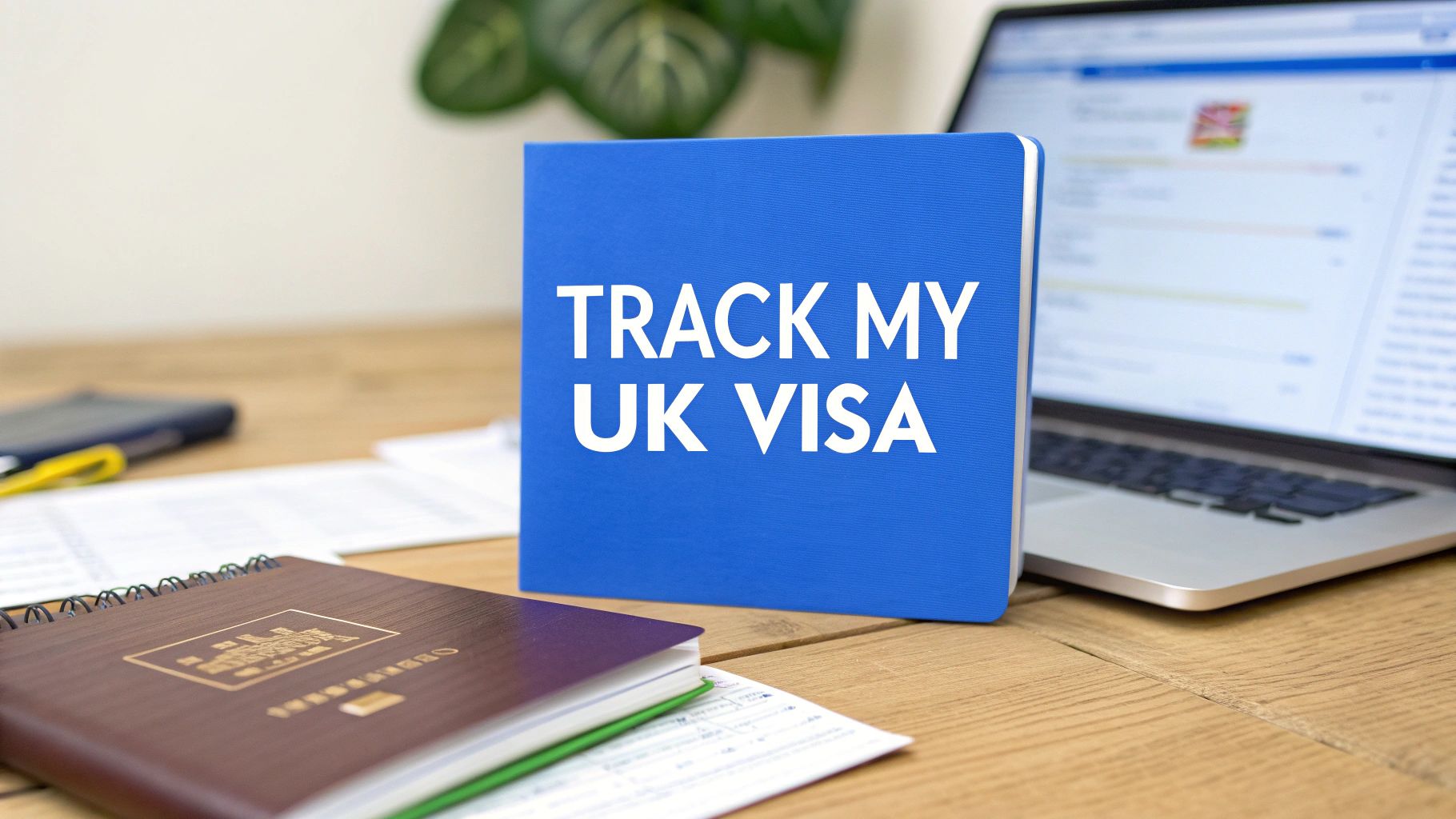
How to Track My UK Visa Application: A Practical Guide for Nigerians
So, you’ve done your biometrics for your UK visa in Lagos or Abuja, and now the real "waiting game" begins. It's a time filled with hope and, let's be honest, a whole lot of anxiety. You're probably refreshing your email every five minutes, wondering what’s happening with your application.
I've been in your shoes, and I know that having a clear way to check your application's progress can make a huge difference to your peace of mind. It gives you back a bit of control. Instead of just waiting and wondering, you can get official updates directly from the source. The good news is that the process is fairly simple, but it all depends on one critical piece of information.

What You Need to Track Your Application
Everything comes down to your GWF (Global Web Form) number. Think of it as the unique tracking ID for your visa application, like a NIN for your visa file. You received this number when you first applied online, and it's the only key that will unlock any status updates. Without it, you won't be able to track your progress at all.
This guide will walk you through exactly where to find that GWF number, which official websites you must use (either VFS Global or TLScontact, depending on where you did your biometrics), and what the different status updates actually mean for your application.
Being able to track your visa is more important than ever. With UK Home Office statistics showing a massive number of visa applications from Nigerian nationals each year, the system is incredibly busy. Knowing how to follow your application's journey helps you manage your own expectations during the long wait.
Our goal here is to cut through the confusion and give you clear, practical steps. It also helps to be aware of the bigger picture; understanding the latest policy shifts, like those discussed in the https://blog.japachat.com/uk-immigration-white-paper/, can provide valuable context while you wait for your decision.
Finding and Using Your GWF Number
Alright, the very first thing you need to track your UK visa application is your unique reference code. It's called a GWF (Global Web Form) number, and it’s the key to everything. Think of it as your application's personal ID, generated the moment you paid and hit 'submit' on the GOV.UK website.
Essentially, it's just like the tracking number you get from GIG Logistics when you send a parcel from Lagos to London. The GWF number does the exact same job, letting you follow your visa application's journey through the Home Office system. Without it, you’re just guessing.
Where Can I Find My GWF Number?
Don't worry, finding your GWF number is usually quite simple. You won't have to search through piles of paper. It's typically located in a couple of digital documents you received right after applying.
Here are the two most common places you'll find it:
-
The Confirmation Email: Remember that email you got from UK Visas and Immigration (UKVI) right after you paid for and submitted your application on the GOV.UK website? Your GWF number is almost always listed clearly in that message.
-
Your Document Checklist: The PDF checklist you printed out for your biometrics appointment at TLScontact or VFS Global will also have it. It's usually right there at the top, near your name and other personal details.
The number has a standard format: it starts with ‘GWF’ and is followed by nine numbers. It will look something like GWF012345678. Once you find it, write it down or save it somewhere safe where you won't lose it.
Quick Tip: The fastest way to find that original email is to search your inbox. Try terms like "UK visa application," "UKVI," or "Global Web Form." This usually brings up the confirmation message in seconds.
Once you have this number, you're all set to use the official tracking services. Just be sure to enter it correctly. A single wrong digit will give you an error, and that's a surefire way to cause yourself unnecessary stress. Always double-check it before you click 'Submit'.
Checking Your Application Status with TLScontact and VFS Global
Okay, you've found your GWF number—what next? For anyone applying from Nigeria, your application's first stop is one of the two official UKVI commercial partners: TLScontact or VFS Global. Where you had your biometrics appointment, whether in Lagos, Abuja, or Port Harcourt, determines which website you'll need to use.
Think of them as the front desk or reception. You submitted your application and passport to them, so their system is the first place you’ll see any sign of movement. To get started, you’ll just need the same login details (email and password) you used to book your biometrics appointment in the first place.
This infographic breaks down the simple flow of finding your GWF number and using it to check your application status.
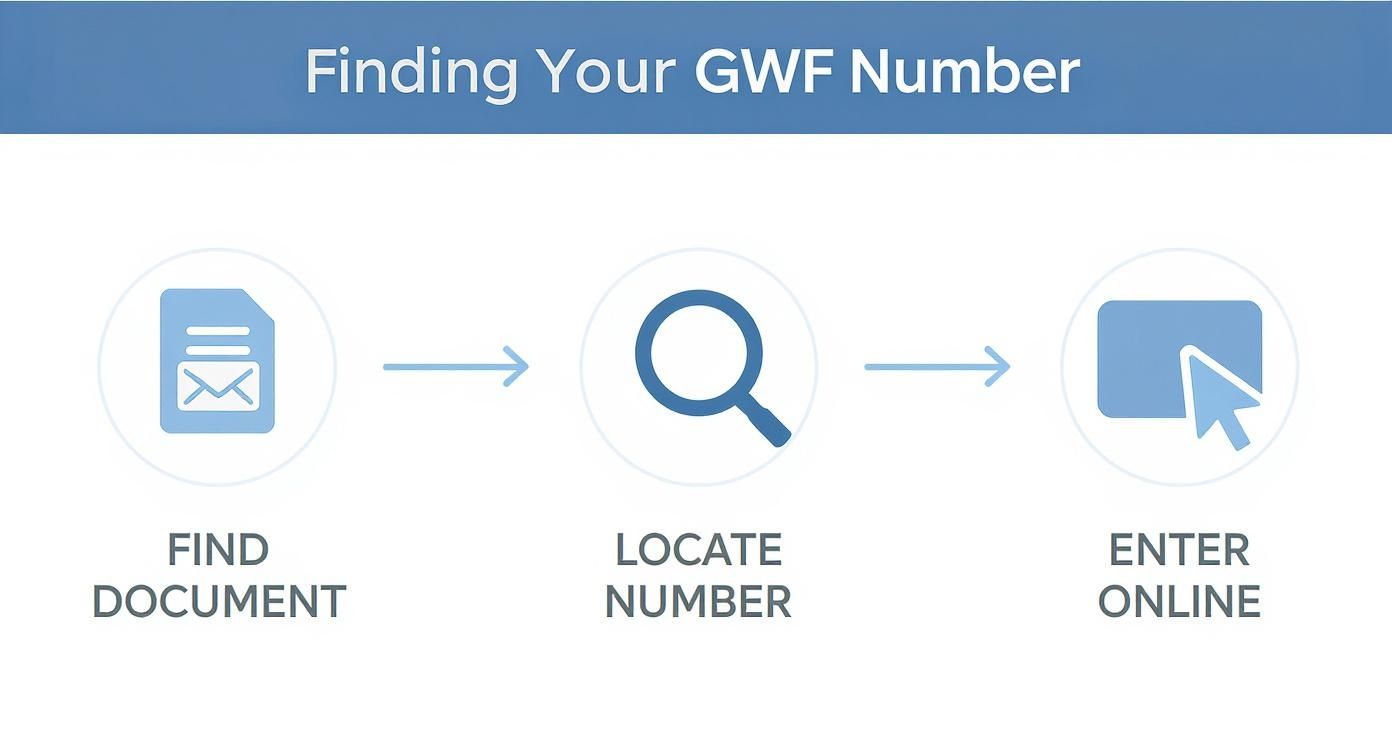
As you can see, it's a straightforward process that moves from locating your details to entering them on the correct portal.
Navigating the VFS Global or TLScontact Websites
Once you're logged in, both websites have a clear "Track your application" section. This is where you'll enter your GWF number (sometimes just called a reference number) and your surname. It's a simple form, but it's worth double-checking for typing errors to avoid any frustrating error messages.
The status updates you'll find here are quite basic. You’ll likely see messages like "Application forwarded to UKVI," which is just a confirmation that your documents have been safely sent to the decision-making centre.
A Quick Heads-Up: The tracking on the VFS or TLScontact portals is very high-level. It’s really just there to confirm your application has been received and sent to UKVI. Don’t expect a live, minute-by-minute update of its journey.
To help you choose the right tracking method at the right time, here’s a quick comparison of the main options available to Nigerian applicants.
UK Visa Tracking Portals for Nigerian Applicants
Tracking Method What You Need Typical Status Updates Best For TLScontact / VFS Global GWF Number, Last Name, Login Details "Forwarded to UKVI," "Received at DMC" Early-stage tracking; confirming your application is in the system. Paid UKVI Enquiry GWF Number, Personal Details, Payment Card "Awaiting a decision," "A decision has been made" Checking for a decision after standard processing times have passed. "Decision has been made" Email Your Email Account The official notification from UKVI The final confirmation that tells you to await passport collection details. This table shows that each tracking method serves a different purpose at a different stage of your application journey. Start with the free partner portals and only move to the paid service if you're facing significant delays.
When Should You Use the Paid UKVI Service?
So, what happens when weeks have passed and the TLScontact or VFS portal is stuck on the same message? This is the perfect time to consider the paid UKVI contact service. For a small fee (usually around £2.74, which is about N4,000-N5,000 depending on the exchange rate), you can send a direct enquiry to the Home Office.
It’s the next logical step—like asking to speak to the manager when the security guard at the gate can't give you any more information. You can do this through their paid email service or by phone.
Make sure you have this information ready:
- Your full name and date of birth
- Your nationality
- Your GWF number
- The specific visa you applied for (e.g., Skilled Worker, Student Visa)
You can generally expect a reply within five working days. This service is most valuable when your application has gone past its standard processing time and you need a concrete update, especially to find out if a decision has actually been made. It offers a more direct line to the people handling your file.
Decoding Your Visa Application Status
So you’ve logged in to check your visa status, and you’re met with official-sounding terms. What on earth does 'Transferred to DMC' actually mean when you’re waiting anxiously in Nigeria? Understanding the jargon is the first step to managing the stress of the wait.
It helps to remember that your application goes on a journey. After you’ve done your biometrics at a VAC in Lagos or Abuja, your file gets packaged up and sent on its way. This is when you'll start seeing those first few status updates pop up.
From the VAC to the Decision Makers
The first couple of updates you'll see on the TLScontact or VFS Global tracking portals are really just about logistics. They're confirming that your application is physically moving through the system as it should.
- Application Received by VAC: This is just a simple confirmation. The centre has your passport, your documents, and your fingerprints. That's it.
- Transferred to DMC (Decision Making Centre): Now, this is a milestone. It means your application has officially left the building in Nigeria and is now with the UKVI team who will make the final decision.
Once it hits the DMC, don't be surprised if the status goes quiet for a while—days, or even weeks. This is when an Entry Clearance Officer is actually reviewing your case. A lack of updates here is not a red flag; it just means your application is in the queue. It's also worth remembering that different UK visa types have different standard processing times, which can affect how long it sits at this stage.
Don't panic if your status seems "stuck" after reaching the DMC. This is usually the longest and most important part of the whole process. Your file is being properly assessed against the UK’s immigration rules.
This quiet period is completely normal. Your application is exactly where it needs to be, and the next update you get will likely be the one you’ve been waiting for: a decision has been made. A little bit of patience goes a long way here.
What Happens After a Decision Is Made?
Seeing that "Decision Made" status pop up is a massive relief, but it's also a bit of a cliffhanger. It simply means an Entry Clearance Officer has reached a conclusion. Crucially, the online portal will not tell you if your visa was approved or refused. You have to wait to get your passport back to know the outcome.
So, what's next? The final phase of waiting begins. Your passport and supporting documents start their journey back to the Visa Application Centre (VAC) in Nigeria where you first submitted everything. You're on the home stretch.
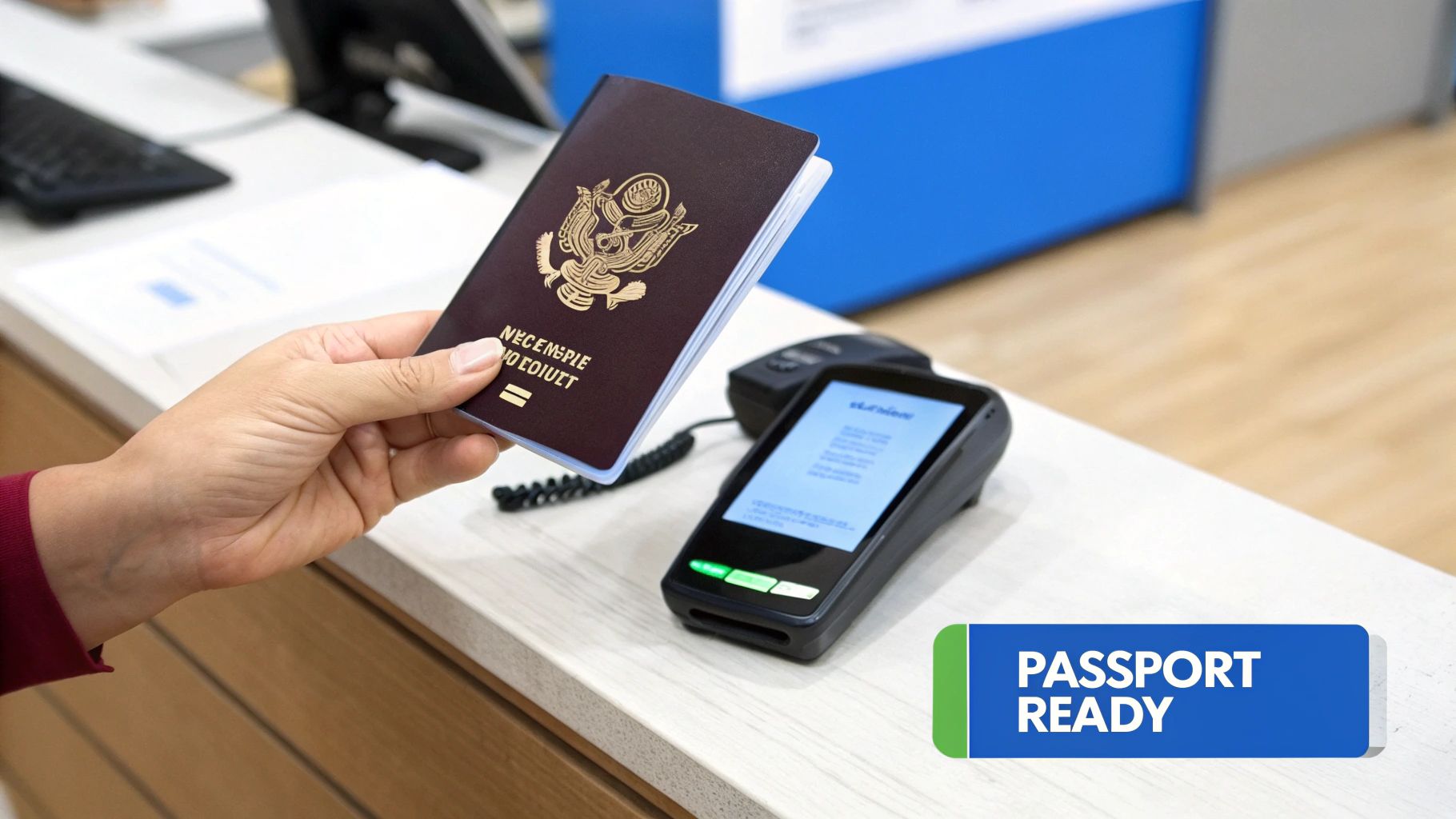
Getting Your Passport Back
You’ll get an official notification from either TLScontact or VFS Global once your passport is back and ready for collection. This will almost always be an email or an SMS, so be sure to check your phone and inbox (including your spam folder!) regularly.
Typically, it takes around 3 to 7 working days for your passport to travel from the decision-making centre back to the VAC in Lagos or Abuja after you see the "Decision Made" update.
When you go to the VAC to pick it up, don't forget these essentials:
- The original receipt you were given when you submitted your application.
- A valid form of photo ID, such as your NIN slip, driver's licence, or international passport data page.
The moment you get your passport back, open it immediately, right there in the VAC if you can. Find the visa vignette (the sticker) and triple-check every detail: your name, date of birth, passport number, and the visa's validity dates. If you spot any mistakes, you must report them to the VAC staff right there and then.
If your application wasn't successful, you'll receive your passport along with a refusal letter. This document is incredibly important—it outlines the specific reasons for the decision and explains your options for an appeal or submitting a fresh application.
Answering Your Top Questions About UK Visa Tracking
Even with a tracking system in place, the waiting game can be nerve-wracking. It’s only natural to have questions pop up while you’re waiting for that all-important decision. Let’s tackle some of the most common queries we see from Nigerian applicants about the tracking process.
"My Status Hasn't Changed in Weeks. Should I Be Worried?"
This is probably the number one question on every applicant's mind. You see the status change to "Transferred to DMC," and then… silence. For days, sometimes weeks.
Take a deep breath – this is completely normal. This is actually the most time-consuming part of the journey, where an Entry Clearance Officer is meticulously going through your application and documents to make sure everything lines up with UK immigration rules. No news is often good news; it just means your application is in the queue, waiting for its turn.
"How Do I Track My Passport Once a Decision Is Made?"
Great question. Tracking your passport is a separate process from tracking the visa decision itself. Your GWF number is for the visa application status.
Once a decision is made, you'll get an email or SMS telling you that your processed application is on its way back to the VAC or has been dispatched. If you paid for a courier service like DHL, they will provide you with a new tracking number specifically for the delivery of your passport to your home address.
A key thing to remember is that the official tracking portals give you high-level updates, not a live, minute-by-minute commentary. A static status is usually part of the standard waiting period, so try not to let it stress you out.
"Help! I've Lost My GWF Number!"
It’s a heart-stopping moment, but don't panic. You can almost always find it. The first place you should look is your email inbox. Search for the confirmation email you received from UKVI right after you submitted your application online.
Still can't find it? Check the document checklist you printed and took with you to your biometrics appointment at the VAC. Your GWF number will be printed on that.
Getting all your documents in order from the very beginning makes the entire process, including tracking, much smoother. It's always a good idea to familiarise yourself with the complete checklist of UK visa requirements for Nigerian citizens before you even start.
Feeling overwhelmed by the UK visa process? You don’t have to figure it all out by yourself. JapaChat provides AI-powered guidance to give you instant answers to your questions, helping you plan your journey with confidence. Get started for free at https://japachat.com.
-
-
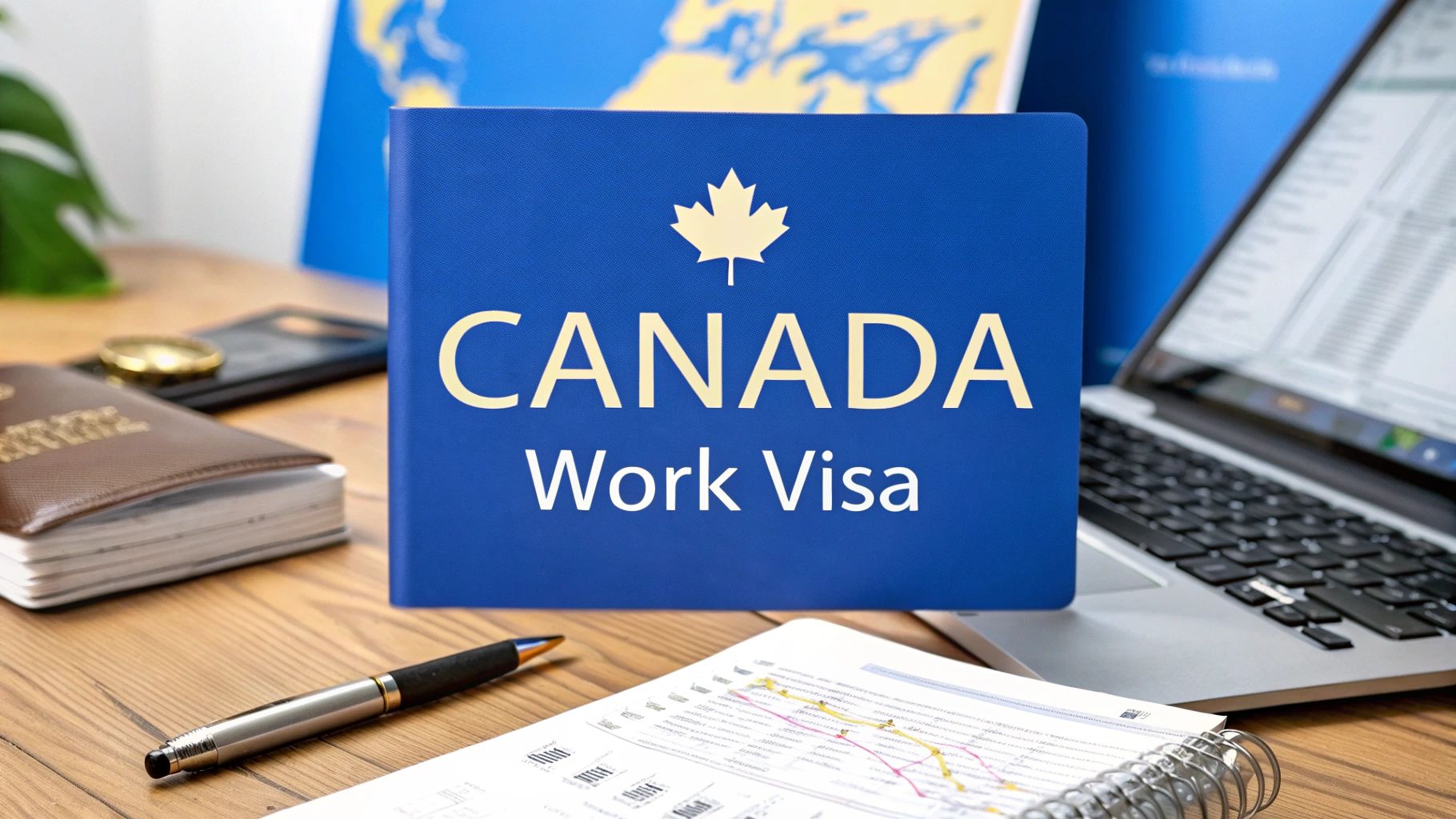
How to Get a Work Visa in Canada: A Nigerian’s Guide
So, you're looking to get a work visa for Canada from Nigeria. The usual route starts with a job offer from a Canadian employer, who often needs to get a Labour Market Impact Assessment (LMIA) to hire you. It’s a process, for sure, but totally manageable once you know the steps.
It all boils down to collecting the right documents, proving you’ve got the skills for the job, and applying through the immigration stream that makes the most sense for you. Let's break down exactly how to approach this journey from Nigeria.
Your Guide to Working in Canada
If a career in Canada is on your mind, you've come to the right place. This guide is designed for Nigerian professionals like you, cutting through the official jargon to give you a clear roadmap. We’ll focus on the practical steps that actually matter for your application.
Think of the Canadian work permit as more than just a visa; for many Nigerians, it's the first major step towards permanent residency. It’s a well-trodden path. Nigerians are now one of the top groups of new permanent residents in Canada, so you're in good company. Many who have successfully made the move started their journey on temporary work or study permits.
Our goal here is to give you the confidence and know-how to make your Canadian dream a reality.
Understanding the Basics
The whole process can seem like a mountain to climb, but it really comes down to three things: checking your eligibility, picking the right program, and putting together a rock-solid application.
Here’s a sneak peek at what we’ll cover:
- The Main Pathways: We’ll look at the big ones, like Express Entry and the Provincial Nominee Programs (PNPs).
- Permit Types: You'll learn the crucial difference between an employer-specific work permit (tied to one company) and an open work permit (which lets you work for almost any employer).
- Nigerian-Specific Advice: We'll tackle common hurdles for Nigerians, like how to get your degree from a Nigerian university validated for Canada or prove your funds when they're in Naira.
A successful application is about more than just filling out forms. It’s about telling a compelling story to the immigration officer—a story that shows you’re qualified, prepared, and a fantastic addition to the Canadian workforce.
Once you land that Canadian work permit, the next step is hitting the job market. To get a head start, you should check out the best job search websites to see what's out there.
For a comprehensive look at the entire journey, from A to Z, take a look at our complete guide on how to relocate to Canada from Nigeria. It’s the perfect starting point for this life-changing move.
Finding Your Best Pathway to a Canadian Work Permit
Choosing the right immigration programme is easily the biggest decision you'll make on your journey to working in Canada. Think of it like deciding whether to take the Lekki-Epe Expressway or the Third Mainland Bridge to get to the Island; your best route depends on where you're starting from, where you're going, and the traffic on the day.
For your Canadian work visa, your skills, experience, and whether you already have a job offer are the factors that will point you down the right path. Let's break down the most common routes for Nigerian professionals so you can see exactly which one fits your situation.
This visual guide gives a quick overview of how to start thinking about your options, depending on whether you have a Canadian job offer in hand.
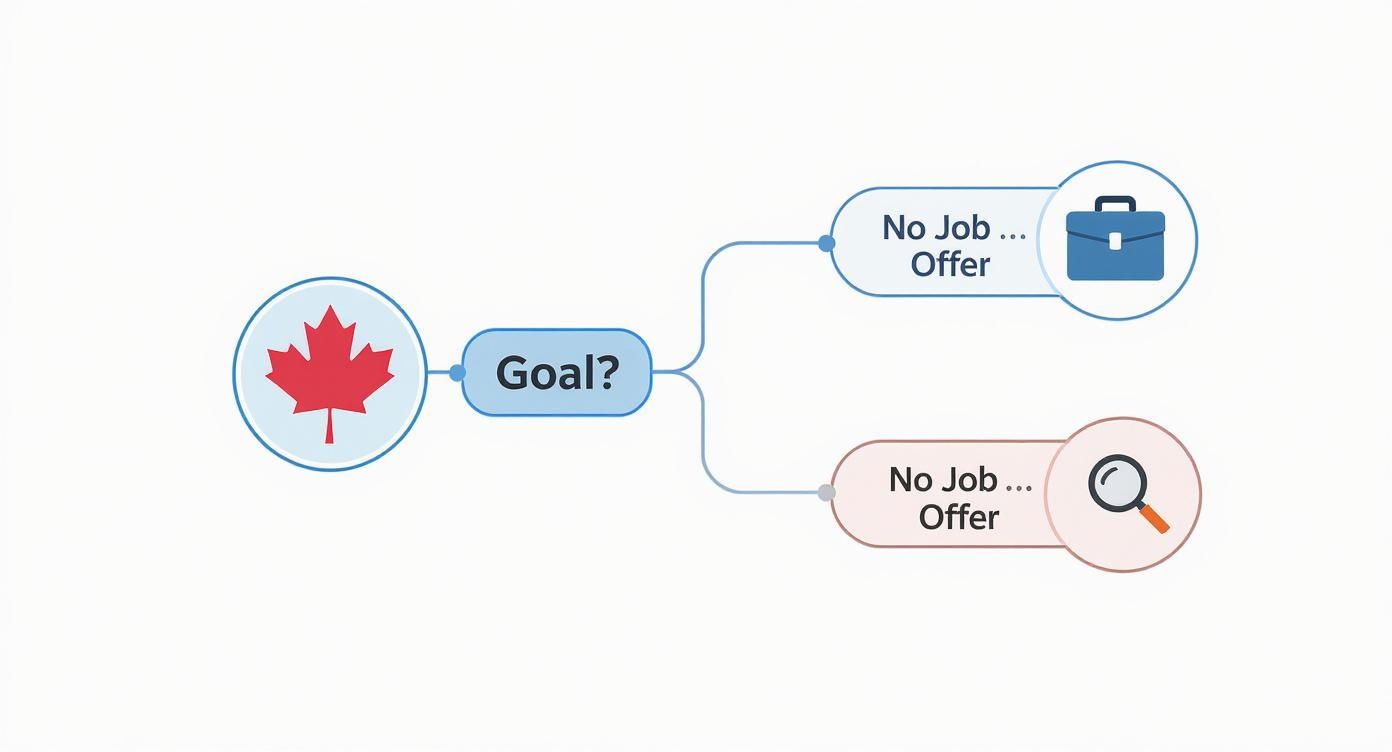
As you can see, a job offer opens up some very direct pathways. If you don't have one, your focus will need to shift to programmes that value your specific skills and professional background.
To help you compare your options at a glance, here’s a breakdown of the most popular routes.
Top Canadian Work Visa Routes for Nigerians
This table compares the most common work permit pathways to help you choose the best fit for your skills and career goals.
Pathway Requires Job Offer? Key Requirement Best For… Temporary Foreign Worker Program (TFWP) Yes Positive LMIA Anyone with a job offer from an employer willing to go through the LMIA process. International Mobility Program (IMP) Usually LMIA-Exemption Professionals at multinational firms or those whose work benefits Canada significantly. Provincial Nominee Program (PNP) Varies In-demand skills in a specific province Skilled workers whose profession is needed by a particular province (e.g., tech, healthcare). Now, let's look at what each of these really means for you.
The Temporary Foreign Worker Program (TFWP)
This is one of the most direct routes, but it hinges on one crucial document: a Labour Market Impact Assessment (LMIA).
An LMIA is basically proof from the Canadian government that an employer needs to hire a foreign worker because no Canadian citizen or permanent resident is available to do the job. Your potential employer in Canada has to show they advertised the role and couldn't find a local to fill it. This part is their responsibility, not yours, but it’s the key that unlocks this pathway.
If a company gives you a job offer backed by a positive LMIA, your chances of getting a work permit are extremely high. This leads to an employer-specific work permit, which means you are tied to that one employer.
To even get to the job offer stage, your application needs to stand out. It's a good idea to learn how to craft a compelling resume summary that catches the eye of Canadian recruiters.
The International Mobility Program (IMP)
So, what happens if there’s no LMIA? Don't worry, that’s where the International Mobility Program (IMP) comes in. This programme covers work permit streams that are exempt from the LMIA requirement because they bring a significant benefit to Canada.
A perfect example for Nigerians is the Intra-Company Transfer. If you work for a multinational company in Lagos—think of a major bank, tech firm, or an oil and gas company that also has an office in Calgary or Toronto—you could be eligible for a transfer.
This is a fantastic option for experienced professionals. If you're in a senior managerial role or have specialised knowledge, your company can move you to its Canadian branch without needing an LMIA. It makes the entire process much, much smoother.
Provincial Nominee Programs (PNPs)
This is where things get really interesting for skilled Nigerians. Each of Canada's provinces has the power to "nominate" individuals they need for permanent residency based on their local economic demands. Many of these PNPs have streams that first grant you a work permit so you can start working in the province right away.
Provinces are always on the lookout for specific skills. For instance:
- Alberta: Has a massive demand for tech talent and healthcare workers.
- Ontario: The Ontario Immigrant Nominee Program (OINP) frequently targets professionals in IT, finance, and the skilled trades.
- Saskatchewan: Often seeks people with experience in agriculture, healthcare, and engineering.
If your profession is in demand in a particular province, a PNP could be your golden ticket. A nomination shows that a province specifically wants you, which makes your application incredibly strong. For many, securing a provincial nomination isn't just about getting a work permit—it's a powerful first step towards permanent residency.
Some PNP streams are also linked with the federal Express Entry system. If you're considering this route, you'll want to get familiar with creating an Express Entry profile to be ready.
Choosing the right pathway is more than just paperwork; it directly impacts your chance of success. Your strategy matters. The overall approval rate for Canadian work permits was recently around 69%, but some streams performed much better. The TFWP, for example, had a 92% approval rate—proving just how much a solid job offer with an LMIA can clear the way for you.
Your Essential Document Checklist
Getting your application file together is a bit like packing for a major trip—you need to be organised and make sure nothing important is left behind. This isn't just about collecting papers; it's about telling a clear and convincing story to the Canadian immigration officer who will be reviewing your case. Let's go through the essential documents you'll need to gather right here in Nigeria.
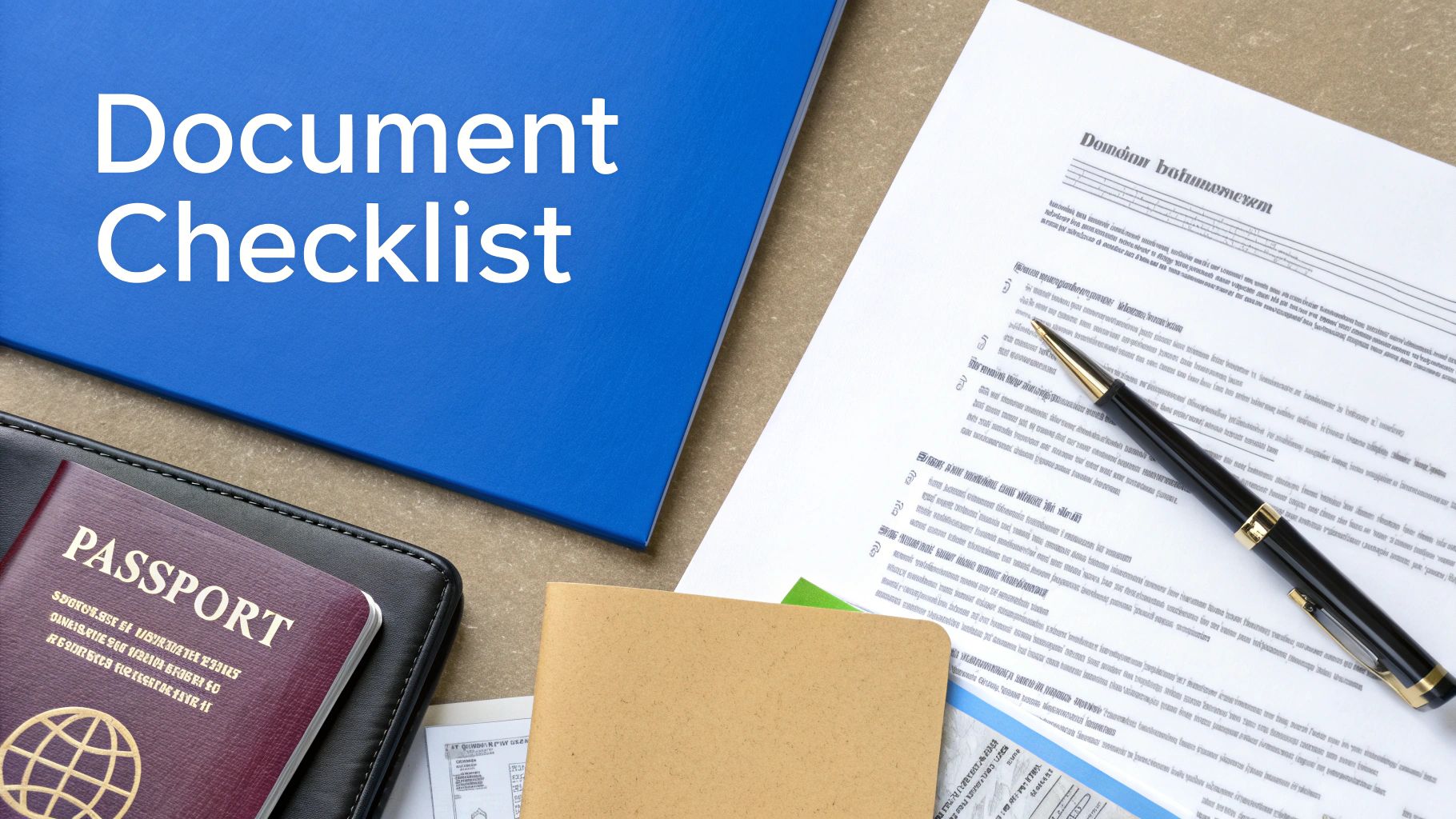
Think of each document as a chapter in your story. It shows your qualifications, your financial readiness, and your potential to thrive in Canada. Getting this part right from the get-go is honestly one of the best ways to sidestep delays and give your work visa application the best possible chance of success.
Nailing Your Proof of Funds
Let's be real, this is often the biggest hurdle for Nigerian applicants. You have to prove you’ve got enough cash to support yourself when you first land in Canada. Immigration, Refugees and Citizenship Canada (IRCC) needs assurance that you can handle your initial expenses before that first Canadian pay cheque comes in.
Your Nigerian bank statements are the main piece of evidence here, and the key words are clarity and consistency. Don't just hand over a statement showing the final balance. You'll need a solid six-month statement of account that shows a clean and understandable transaction history.
A word of advice: steer clear of sudden, large deposits from friends or family just before you print the statement. These are what many of us call "Sapa" funds, and they can be a massive red flag for visa officers. If you did receive a large gift, you absolutely must include a notarised Gift Deed explaining where the money came from.
Don't forget, all your funds will be in Naira (NGN). You must get an official letter from your bank confirming the closing balance and its equivalent in Canadian Dollars (CAD) based on the exchange rate for that day. It's a small step that makes a huge difference.
For a deeper look into this crucial requirement, we've put together a detailed guide on how to prepare your proof of funds for a Canadian visa application.
Validating Your Nigerian Education
Canada needs to know that your degree from a Nigerian university stacks up against a Canadian one. This is sorted out with an Educational Credential Assessment (ECA). You can't just send in your certificate; it has to be officially assessed by a designated organisation.
For most of us in Nigeria, the go-to choice is World Education Services (WES). The process generally looks like this:
- Get a WES Account: First, you'll register on the WES Canada website to get your reference number.
- Request Your Transcripts: This is the tricky part. You'll have to contact your university in Nigeria—whether it's UNILAG, Covenant, or ABU Zaria—and ask them to send your official transcripts directly to WES. This can often cause delays, so my advice is to start this as early as possible!
- WES Does Its Thing: Once WES gets your transcripts, they'll evaluate your education and give you a report that confirms its Canadian equivalent. For example, a Bachelor's degree from a recognised Nigerian university is usually seen as equal to a Canadian four-year Bachelor's degree.
This ECA report is a non-negotiable requirement for many immigration pathways, so make it a top priority.
Proving Your English Language Skills
Your ability to communicate effectively in English is a big deal. Even though it's Nigeria's official language, you still have to prove your proficiency with a designated language test. The most common one you'll take is the International English Language Testing System (IELTS) General Training test.
The aim is to hit a specific Canadian Language Benchmark (CLB) score. While different work permit streams have different minimums, a higher score always works in your favour. You should really aim for at least a CLB 9, which usually means getting these scores on your IELTS test:
- Listening: 8.0
- Reading: 7.0
- Writing: 7.0
- Speaking: 7.0
Don't take the test lightly. Use online practice materials, zero in on your weak spots, and maybe even consider a prep course. A strong IELTS score is one of the most powerful ways to boost your entire profile.
Getting Medical and Police Clearances
Finally, you need to show that you're in good health and have a clean record.
For the medical exam, you can't just visit your local hospital. You must book an appointment with an IRCC-approved panel physician in Nigeria. You'll find designated clinics in major cities like Lagos and Abuja. They'll do the check-up and send the results directly to IRCC for you.
As for the police clearance certificate, you'll need to apply for this through the Nigeria Police Force Criminal Investigation Department (CID). This certificate confirms you don't have a criminal history. This process can take several weeks, so be sure to apply for it well ahead of time to avoid any last-minute panic.
Getting Your Application Across the Finish Line
Alright, you've gathered all your documents, and you're on the home stretch. This is where precision and honesty become your best friends. Even a tiny mistake at this stage can lead to frustrating delays or, worse, a refusal. We're going to make sure that doesn't happen.

Let's walk through the actual submission process on the IRCC portal and, more importantly, highlight the common tripwires I've seen catch many Nigerian applicants off guard.
The Application and Payment Process
Your journey officially kicks off on the Immigration, Refugees and Citizenship Canada (IRCC) website. First things first, you’ll need to create your secure IRCC account. Think of this as your personal dashboard for everything that follows. It's where you'll fill out the main form—usually the IMM 1295 (Application for Work Permit Made Outside of Canada)—and upload all those documents you've worked so hard to prepare.
Go slowly and methodically through the form. I can't stress this enough: double-check every single detail. A typo in your name, date of birth, or passport number can cause major headaches down the line.
Now, let's talk about fees, because this is a real sticking point for many in Nigeria. IRCC only accepts online payments via credit card (Visa, Mastercard, American Express). The problem? Due to banking restrictions on international transactions, your standard Naira card will almost certainly be declined. The most reliable way around this is to use a domiciliary account debit card or ask a trusted friend or relative living abroad to handle the payment for you.
To help you budget, here’s a breakdown of what you can expect to pay.
Estimated Costs for a Canadian Work Visa Application
This table breaks down the typical fees you'll encounter. I've included both Canadian Dollars (CAD) and estimated Nigerian Naira (NGN) to help with your financial planning.
Fee Type Cost in CAD Estimated Cost in NGN Work Permit Processing Fee $155 ~₦217,000 Biometrics Fee (per person) $85 ~₦119,000 Open Work Permit Holder Fee $100 ~₦140,000 Employer Compliance Fee (paid by employer) $230 ~₦322,000 Just a heads-up: The NGN estimates are based on a fluctuating exchange rate and are really just for your initial planning. Always check the current rate before making a payment.
Having a clear picture of these costs upfront helps you prepare and avoid any last-minute financial surprises.
The Golden Rule: Honesty is Everything
If you take only one piece of advice from this guide, let it be this: do not misrepresent anything. In Canadian immigration law, misrepresentation (which is just a formal way of saying lying or providing false information) is a massive red flag. If they catch you, you could be banned from entering Canada for five years. It’s just not worth the risk.
Be completely transparent, especially about these two areas:
- Travel History: Never hide a previous visa refusal, whether it was for the UK, the US, or anywhere else. They have ways of finding out. It's always better to declare it and briefly explain what happened and what has changed since then.
- Work Experience: Don't invent jobs or exaggerate your duties to fit a certain NOC code. IRCC can, and often does, verify employment history with past employers.
A common worry is an employment gap. Maybe you took a year off for NYSC or to care for a sick parent. Don't try to sweep it under the rug. Address it head-on in a letter of explanation. Being upfront builds trust with the visa officer.
Think of the Letter of Explanation (LOE) as your chance to talk directly to the person reviewing your file. Use it to clarify anything that might look unusual. For example, if you recently deposited a large sum of cash into your account, explain that it was from the sale of a family car and include a copy of the sale agreement. A good LOE can turn a potential red flag into a non-issue.
The Biometrics Appointment in Nigeria
Once your application is submitted and the fees are paid, you'll get a Biometric Instruction Letter (BIL) in your IRCC account. Your next move is to book an appointment at a Visa Application Centre (VAC). In Nigeria, you have locations in Lagos and Abuja.
This part is pretty straightforward. You'll show up at the VAC for your scheduled appointment with your passport and the BIL. They’ll take your fingerprints and a digital photo, and you’ll be out of there in under 30 minutes. This is a mandatory step; your application simply won't be processed until your biometrics are on file.
What Happens After You Apply
You’ve finally hit that "submit" button and your biometrics are in the system. Now comes the hard part: the wait. This is often the most nerve-wracking stage, where you might find yourself constantly refreshing your email or checking your IRCC account for any sign of life.
Let’s be honest, the waiting game can feel endless. To get a handle on it, your first stop should be the official IRCC processing times tool. For applicants from Nigeria, these timelines can really differ depending on which work permit stream you used. Just remember, the time shown is an average. A clean, straightforward application can sometimes sail through faster, while a more complex case will naturally take longer.
You can keep an eye on things by logging into your secure IRCC account. The status updates are pretty basic, usually shifting from "Submitted" to "In Progress" before a final decision is made. It’s a slow burn, but any movement is a positive sign.
When You Get Good News
Getting that approval notification is a moment you won't forget. But what you receive in your IRCC account isn't the visa sticker itself. Instead, you'll get a Port of Entry (POE) Letter of Introduction.
Think of this letter as your golden ticket. It is not your work permit, but it is the crucial document you must show the border officer when you land in Canada.
So, what’s next?
- Print Your POE Letter: Keep a crisp, printed copy with your passport. Whatever you do, don't pack it in your checked luggage! You'll need it as soon as you get off the plane.
- Plan Your Arrival: It's time to book your flight and get your documents in order for the airport. This includes your passport, proof of funds, and the address of where you'll be staying initially.
- At the Airport: When you arrive, an officer from the Canada Border Services Agency (CBSA) will check your documents and likely ask a few simple questions. If everything is in order, they will print and issue your official work permit right there.
Your POE letter comes with an expiry date. You absolutely must plan your travel to arrive in Canada before this date passes. It cannot be extended, so pay close attention to it.
Getting Settled After Arrival
With your physical work permit in hand, your first two errands should be getting a Social Insurance Number (SIN) and opening a Canadian bank account. The SIN is a nine-digit number that's essential for working in Canada and accessing government benefits. You can apply for one at any Service Canada Centre.
If Your Application Is Refused
Seeing a refusal is incredibly disappointing, but it doesn’t have to be the end of your Canadian dream. The first thing you must do is carefully read the refusal letter to understand exactly why it was turned down. The visa officer will give their reasons, often pointing to specific parts of the immigration act.
These notes are your roadmap for what to fix. Maybe you didn't provide enough proof of funds, or they weren't convinced you'd leave Canada when your permit expires. Instead of feeling defeated, use this feedback to build a much stronger application for next time. Sometimes, a more detailed letter of explanation or additional supporting documents can make all the difference.
It's also worth remembering that Canada's immigration policies are constantly being updated. The government recently announced reforms to manage the number of temporary residents, with changes planned for programmes like the International Mobility Program. This signals a growing emphasis on pathways to permanent residency for temporary workers, making long-term planning more important than ever. Keep up with the latest Canadian immigration news to stay on top of any changes that might affect you.
Answering Your Top Questions
When you're navigating the path to a Canadian work visa from Nigeria, a lot of specific questions are bound to pop up. Let's dig into some of the most common ones I hear from applicants, so you can get clear answers and move forward with confidence.
Do I Need Proof of Funds If I Have a Canadian Job Offer?
This is a big one, and the short answer is: yes, almost always. While a job offer from a Canadian employer is the cornerstone of a strong application, it doesn't get you off the hook for showing settlement funds.
Think about it from the visa officer's point of view. They need to be sure you can hit the ground running without any financial trouble. What happens if there's a hiccup with your first paycheque? What about the upfront costs of a rental deposit, setting up utilities, or just getting around before your salary starts flowing?
Having your own funds proves you’ve thought through these initial hurdles. It's your safety net, showing you're fully prepared for the move and won't face hardship the moment you land. This makes your application that much more convincing.
Can I Bring My Family with Me on a Work Visa?
You absolutely can, and this is one of the best parts of Canada's immigration system. If you land a work permit for a skilled role—that's any job under NOC TEER 0, 1, 2, or 3—your family can usually come with you.
Here's the breakdown:
- Your Spouse or Partner: They can often get an open work permit. This is a huge advantage, as it lets them work for nearly any employer in Canada, giving your family a potential second income right away.
- Your Dependent Children: They can join you and are typically able to enrol in Canadian public schools without needing their own study permit.
The key is to include your family in your initial application. This ensures everyone's paperwork gets processed together.
Expert Tip: Don't forget to adjust your proof of funds calculation. The required amount increases for each dependant, so you'll need to plan ahead to meet the financial requirements for your whole family.
What Is an Open Work Permit Versus an Employer-Specific One?
Knowing the difference here is crucial, as they offer completely different experiences in the Canadian job market.
A employer-specific work permit, often called a 'closed' permit, is what most first-time applicants get. It links you to one company, one job title, and one location. If you’re coming through the Temporary Foreign Worker Program (TFWP), this is almost certainly the type of permit you'll receive.
Then you have the open work permit. This is the holy grail for many, as it allows you to work for virtually any employer, anywhere in Canada. It offers incredible freedom, but it's much harder to qualify for. Open permits are typically reserved for specific situations, like for the spouses of skilled workers or international students who've graduated from a Canadian college or university.
How Long Does the Work Visa Process Take from Nigeria?
Ah, the million-dollar question. Honestly, processing times are a moving target. They can change dramatically based on the type of permit you're applying for and how swamped Immigration, Refugees and Citizenship Canada (IRCC) is at any given moment.
We've seen straightforward applications get approved in a few weeks, while more complex cases can take several months. The best thing you can do is control what's in your power: submit a flawless application. That means every document is included, every form is filled out correctly, and there are no mistakes.
Your most reliable source is the official IRCC processing times tool. Check it regularly to get the most current estimates for applications filed from Nigeria.
Feeling overwhelmed? JapaChat can help clear things up. As Nigeria's first AI immigration expert, it's designed to give you instant, accurate answers to your questions about getting a Canadian work visa. Get the clarity you need to plan your move. Sign up for free today.
-
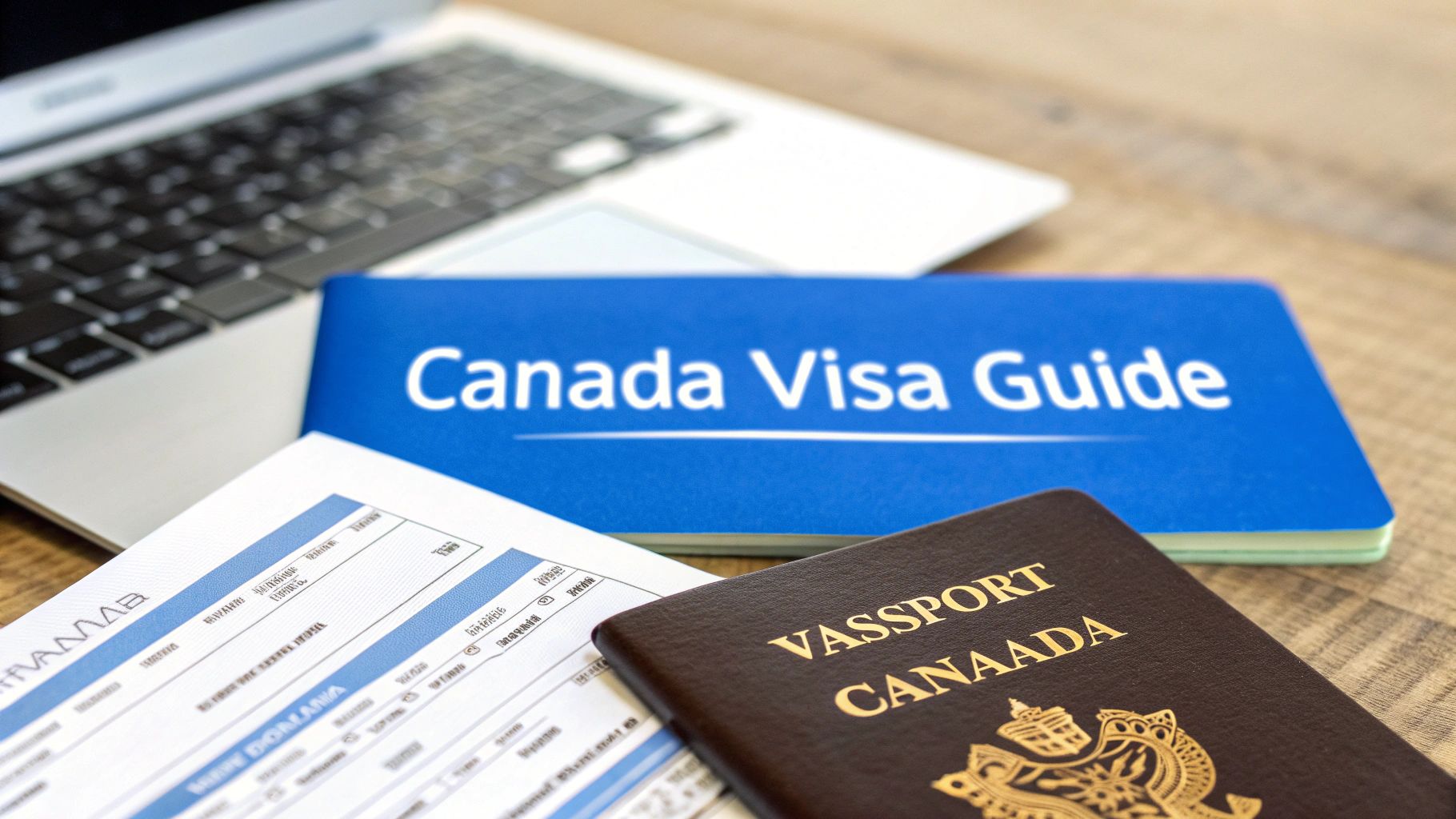
Canada Visit Visa Requirement for Nigerians
So, you’re dreaming of a trip to Canada? That’s the easy part. Turning that dream into a reality means navigating the visa application process, which can feel a bit daunting for first-timers from Nigeria. For Nigerian citizens, getting a Canadian visitor visa—officially known as a Temporary Resident Visa (TRV)—is a mandatory first step whether you're visiting for a holiday, seeing family in Brampton, or attending a business meeting in Calgary.
Think of the application less like a complicated puzzle and more like a detailed checklist for a very important journey.
Unlocking Your Canadian Travel Plans
Getting your hands on a Canadian visitor visa from Nigeria is certainly a challenge, but it's absolutely achievable. The key is meticulous preparation and a solid understanding of what the visa officers are looking for. Your application is essentially your story told through documents, and you're the main character: a genuine visitor with compelling reasons to return to Nigeria.
The process is far more than just filling out forms. It's about building a strong case that proves three critical points:
- You have a legitimate, well-defined reason for your visit.
- You have enough money to cover your entire trip without needing to work illegally in Canada.
- You have deep, unbreakable ties to Nigeria that guarantee you'll leave Canada when your visit is over.
Why Every Single Detail Matters
Your success boils down to presenting an application that is clear, completely honest, and backed up with solid proof. This guide is designed to close the gap between dreaming about your trip and actually making it happen, breaking down every Canada visit visa requirement into simple, manageable steps. We'll cut through the noise and rumours to focus on what really works, from proving your financial stability to effectively demonstrating your ties to home.
The heart of a successful application is convincing the visa officer of your intentions. They need to see a clear, credible picture of your life in Nigeria and understand precisely why you will return home after your visit.
It’s also important to be realistic. In recent years, the approval rate for Nigerian applicants has been challenging. This tells us that every application is scrutinised very carefully, leaving no room for error.
Once you get that visa stamp, the real fun begins! You can start planning the exciting parts of your trip, like getting ready to explore Canada's national parks for an adventure you'll never forget.
Getting Your Document Checklist in Order
Think of your visa application as a story you're telling the visa officer. Every document is a chapter, and together, they must paint a clear picture of who you are, why you want to visit Canada, and why you'll definitely return home to Nigeria. It's not just about ticking boxes; it's about building a rock-solid case that leaves no room for doubt.

Attention to detail here is everything. One small mistake or a forgotten document can mean long delays or, worse, a straight-up refusal. Let’s get this part right from the start.
The Must-Have Application Documents
First things first, let's cover the absolute essentials. These are the non-negotiables that form the backbone of your application.
-
Valid Nigerian International Passport: This is your most important travel document. Make sure it’s valid for the entire time you plan to be in Canada and has at least one completely blank page for the visa stamp. No page, no visa. Simple as that.
-
IRCC-Standard Photographs: Don't just pull any old passport photo out of a drawer. You'll need two recent photographs that meet the very specific requirements of Immigration, Refugees and Citizenship Canada (IRCC). We're talking exact size, a plain white background, and a neutral facial expression. My advice? Go to a professional photo studio in places like Ikeja or Wuse and tell them it's for a Canadian visa application; they'll know the exact specifications.
-
Completed Application Forms: You’ll need to fill out several forms, including the main one, IMM 5257 (Application for Visitor Visa). Be meticulous. Double-check every detail for accuracy and make sure the information is consistent across all your documents. Any contradictions will raise a red flag.
Showing You Can Fund Your Trip
This is a major hurdle where many applications from Nigeria stumble. You must convince the visa officer that you have enough money to comfortably pay for your entire trip without needing to find work in Canada. It's all about proving you won't become a financial burden on their system.
This is where your bank statements come in. You'll need to provide your personal bank statements for the last four to six months. What they are looking for is a history of stable finances, not a huge lump sum that suddenly appeared a week before you applied. That's a classic sign of borrowed funds—what we call "sponsorship-by-the-bedside"—and a major red flag.
A strong bank statement tells a story of financial responsibility. It shows your trip is a planned and affordable expense, not a desperate attempt to 'japa'.
If you're a salaried employee in Lagos, your monthly paycheque should be clearly visible coming into your account. If you run a business in Aba market, there should be a consistent flow of transactions that reflect your business activities. The goal is to show a healthy closing balance that easily covers your flights, accommodation, and spending money.
For a deeper dive into this crucial aspect, check out our guide on how to show proof of funds for a Canadian visa.
Explaining Your Purpose of Travel
So, why Canada? Your answer needs to be crystal clear, detailed, and completely believable. This is where your Purpose of Travel Letter (sometimes called a Letter of Explanation) comes in.
This letter is your one chance to speak directly to the person reviewing your file. A vague line like "for tourism" just won't cut it. You need to lay out your plans. Where are you going? What will you see and do? How long will you stay? If you're visiting your sister in Toronto for her graduation, include a formal invitation letter from her and a copy of the graduation invitation. If you're attending a tech conference in Vancouver, attach your registration confirmation and flight itinerary.
Inadequate documentation, especially around the purpose of visit and proof of funds, is one of the top reasons for visa refusal for Nigerians. Making sure these documents are well-organised and tell a convincing story has never been more important.
Proving Your Unbreakable Ties to Nigeria
Let's get straight to the point: this is the make-or-break section of your entire application. The visa officer reviewing your file has one primary question on their mind: "Is this person going to return to Nigeria after their visit?" Your mission is to provide so much compelling evidence that the only logical answer is a resounding "yes."
Think of your application as telling a story. The story needs to clearly show that your life, your responsibilities, and your future are all firmly planted in Nigeria. A short trip to Canada is just a temporary chapter, not a new book. Every document you submit from here on out should reinforce this one central theme.
Building Your Case with Strong Ties
So, what are these "strong ties"? They are the tangible, verifiable reasons that practically force you to come back home. It's not just about having money in the bank; it's about having a life you've built and are committed to. Let’s break down what this looks like for a Nigerian applicant.
-
Stable Employment: This is a big one. A letter from your employer (on company letterhead) confirming your permanent role, your salary, and—crucially—an approved leave letter for the specific dates of your travel is pure gold. It proves you have a job to come back to.
-
Family Responsibilities: Are you married? Do you have kids in school here in Nigeria? These are powerful anchors. Including your marriage certificate and your children’s birth certificates paints a vivid picture of a family life that depends on your return.
-
Business Ownership: If you're a business owner, you have a massive advantage. Your Corporate Affairs Commission (CAC) registration documents, business bank statements, and tax clearance certificates are solid proof that you have an enterprise that needs you at the helm.
-
Property Ownership: Owning property is another fantastic way to show you’re not going anywhere. Documents like a Certificate of Occupancy (C of O) or a registered Deed of Assignment for land or a house in places like Lekki or Asokoro are compelling evidence of your deep roots in Nigeria.
A visa officer is trained to spot an applicant who might be looking for a way to overstay. Your job is to present the profile of someone with far too much to lose back home to even think about it. Your life in Nigeria must look stable, established, and full of promise.
Avoiding the Pitfall of Weak Ties
Just as strong ties can get you approved, weak ones can get you a swift refusal. One of the most common mistakes Nigerian applicants make is assuming a hefty bank balance is all the proof they need. It isn't.
Money is fluid; it can be moved anywhere in the world, and the visa officer knows this. In fact, without a stable job, family, or property to back it up, a large sum of money can look suspicious. It might even seem like you've sold off your assets to fund a one-way trip.
What they want to see is a combination of financial stability and deep-rooted personal commitments. This blend is what makes your intention to return believable. You also need to express this commitment powerfully in your own words. You can get more pointers by reading our detailed guide on how to craft a compelling letter of intent for your visa application.
Navigating the Online Application and Biometrics
Once you have all your documents in order, it's time to move things online. For Nigerian applicants, the entire process happens through the official Immigration, Refugees and Citizenship Canada (IRCC) portal. While it's definitely convenient, you need to be very careful to follow the technical rules to the letter.
Your first step is to create a secure IRCC account. This account is your personal dashboard for everything—submitting the application, paying the fees, and checking on its status. Think of it as your official file with the Canadian government, so double-check that every personal detail is spot on from the very beginning.
Mastering the IRCC Portal
With your account ready, the system will walk you through filling out the main application form, the IMM 5257. My advice? Take it slow. Every piece of information you enter here must perfectly mirror what’s in your supporting documents. Even a tiny mistake, like a typo in your name or passport number, can bring your application to a grinding halt.
After the forms are done, you’ll need to upload all your scanned documents. This is where a lot of applicants trip up, because the IRCC has very specific rules for file formats and sizes.
- Scan Properly: Don’t just snap a photo with your phone. Use a proper scanner at a business centre to create clear, readable PDF copies of every single document. A blurry bank statement is an easy reason for a visa officer to have doubts.
- Name Your Files Logically: Avoid generic names like "scan_001.pdf." Instead, label them clearly, for instance, "Tunde_Adeboye_Passport.pdf" or "Tunde_Adeboye_Bank_Statement.pdf". This simple step makes the visa officer's job much easier.
- Watch the File Size: The portal has a maximum file size for uploads. You might need to compress some of your larger files, but make sure you do it without making them blurry or hard to read.
All the documents you upload should work together to prove your strong ties to Nigeria.
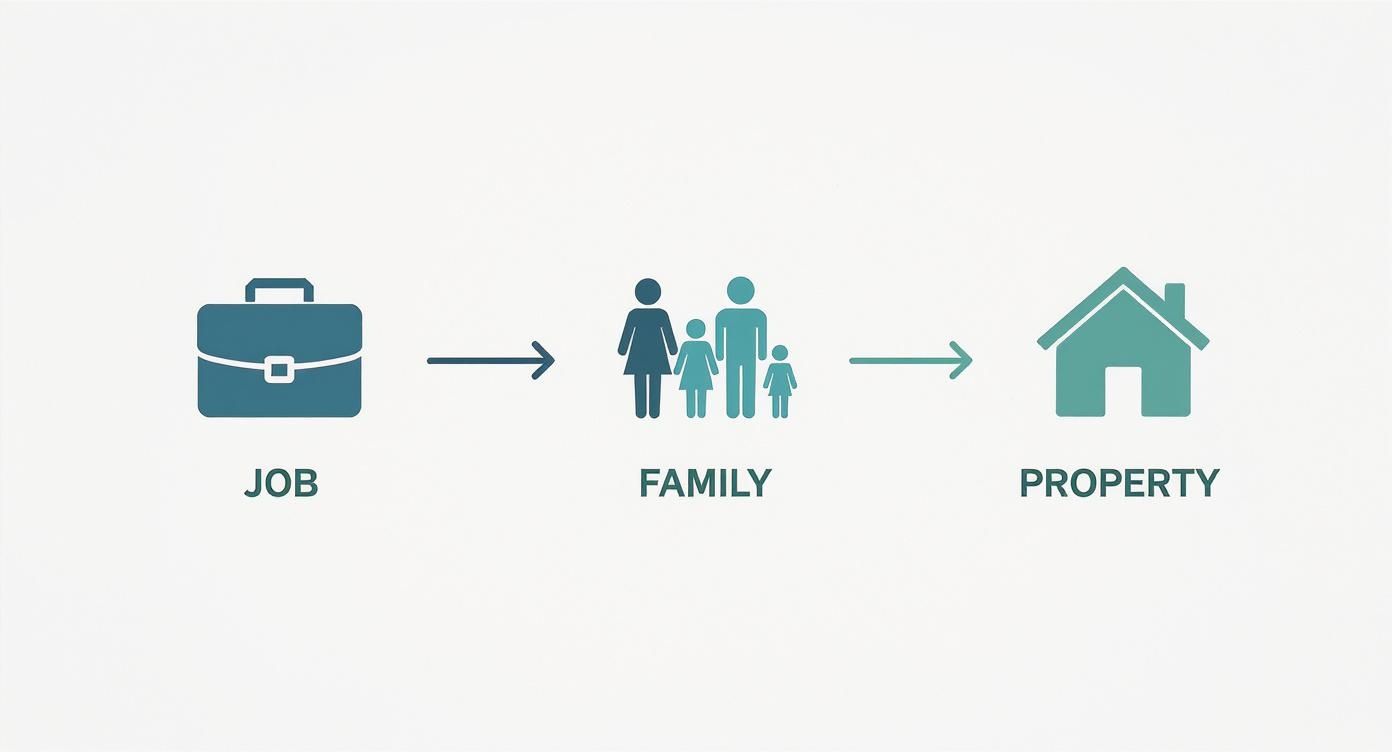
As you can see, a successful application isn't about just one thing; it's about showing you have deep-rooted commitments across different areas of your life back home.
The Biometrics Appointment
After you've submitted your application online and paid all the fees, you'll get a Biometric Instruction Letter (BIL) in your IRCC account. This step is mandatory. You will need to book an appointment at a Visa Application Centre (VAC) in either Lagos or Abuja to give your fingerprints and have a photo taken.
Your biometrics are your unique signature in the Canadian immigration system. If you don't complete this step within the 30-day deadline, your application will be automatically refused. There are no extensions or second chances.
Book this appointment the moment you receive the BIL letter, as available slots can disappear fast. When you go for your appointment, make sure you have your international passport, a printed copy of the Biometric Instruction Letter, and your appointment confirmation. The actual process is quick, usually over in less than 20 minutes. With that done, your part in the application process is officially complete.
Managing Your Application Timeline and Tracking Progress
So, you’ve submitted your application. Now comes the hard part: the wait. This period can feel like a nail-biting mix of hope and anxiety, but knowing what to expect and how to keep an eye on things can make it much more manageable. Let’s talk about how to navigate this waiting game.
First things first, processing times for applications from Nigeria are not set in stone and can often be longer than the global average. They're constantly shifting based on a whole host of factors—global events, the sheer volume of applications pouring in, and even the time of year can all play a part. You can get a better sense of how immigration statistics impact new arrivals on canvasimmigration.com.
Checking and Understanding Your Application Status
Your lifeline during this period is your IRCC secure account. This is the same portal you used to submit everything, and it's where every official update will appear. Make it a habit to check this account regularly so you don’t miss any important messages or requests for more information.
You’ll likely see a status that says "background check in progress." Don't let this worry you! It’s a completely standard part of the procedure for nearly every applicant and just means your file is actively being reviewed.
For a more granular look at what's happening, you should link your application within the IRCC portal. This unlocks a status tracker that gives you more specific updates on exactly where your file is in the process. For a walkthrough on how to do this, check out our guide on effective visa application tracking in our detailed article.
Several things can directly influence how long you'll personally have to wait:
- Application Volume: Applying during a popular travel season, like just before the summer holidays or Christmas, often means you're in a much longer queue.
- Case Complexity: A simple, straightforward application with all your ducks in a row will usually move faster. If you've had a previous visa refusal or have a complicated family or travel history, expect it to take a bit more time for a thorough review.
- Completeness of Your File: This is a big one. Any missing document or piece of conflicting information will absolutely cause delays, as the visa officer will have to pause your application to request the missing items from you.
Patience really is a virtue here. As tempting as it might be, bombarding IRCC with emails and calls won't speed anything up. Trust in the process and in the strong, complete application you put together.
Common Mistakes That Could Sink Your Application
Let's be blunt: thousands of applications from Nigeria get refused every year. It’s often not because the person wasn't eligible, but because of small, completely avoidable mistakes that screamed "red flag" to the visa officer. A single error can unfortunately be all it takes to derail a perfectly good application.

Think of this section as your cheat sheet for sidestepping the most common landmines we see Nigerian applicants hit. By knowing what these are, you can double-check your own file and give yourself a much better shot at success.
Mismatched Information Across Your Documents
Conflicting details are probably the fastest way to lose the visa officer's trust. Imagine you write down your monthly salary as ₦500,000 on the main application form (IMM 5257), but your bank statements only show an average of ₦350,000 coming in each month.
That kind of mismatch immediately plants a seed of doubt. The officer starts wondering which figure is correct and might just assume you’re not being truthful about your financial situation.
How to Fix It: Before you even think about hitting 'submit', lay out all your documents—digital or physical—and compare them. Your employment letter, pay slips, bank statements, and every single form must tell the exact same, consistent story. Consistency is everything.
A Vague or Unrealistic Travel Plan
So many people make the mistake of writing something generic like, "I want to visit for tourism." This tells the visa officer absolutely nothing. It sounds unplanned and makes them wonder if you have a genuine reason for visiting Canada.
An even bigger problem is a travel plan that just doesn't add up with your finances. If you’re on a modest salary but you're proposing a lavish, month-long tour across all of Canada's provinces, it's going to look unbelievable. The officer might think your real plan is to look for work.
Hiding a Previous Visa Refusal
This one is a deal-breaker. You absolutely cannot hide a past visa refusal. Canada shares immigration data with its allies like the US, UK, and Australia (they're part of an intelligence-sharing group called the "Five Eyes"). If you've been refused a visa by any of them and you don't declare it, they will find out.
Trying to hide a refusal is seen as deception, and it's almost a guaranteed way to get another refusal. It is always, always better to be honest about it.
- What you must do: Always declare any previous visa refusals from any country.
- How to explain it: Use your letter of explanation to briefly touch on it. Mention the country, the reason they gave for the refusal, and most importantly, show how your situation has changed for the better since then.
By steering clear of these common slip-ups, you're presenting a clear, honest, and believable case that ticks all the right boxes for the Canada visit visa requirements.
Frequently Asked Questions for Nigerian Applicants
Going through the Canada visit visa process can definitely stir up a lot of questions. Let's tackle some of the most common ones we hear from Nigerian applicants with clear, practical answers.
How Much Money Is Enough for Proof of Funds?
There isn't a magic number set in stone, but what the visa officer really cares about is stability and having enough for your trip. For a typical two-week visit, a good rule of thumb is to show you have access to between CAD $3,000 to $5,000 (roughly ₦3 million to ₦5 million, depending on the exchange rate) per person. This is after you’ve already paid for your flights and accommodation.
But here’s the crucial part: the history of the money matters more than the final balance. A huge lump sum suddenly appearing in your account right before you apply is a massive red flag. They need to see a consistent pattern of savings and income over at least four to six months, which proves the money is truly yours and not just borrowed to make your account look good.
Does an Invitation Letter Guarantee My Visa?
No, an invitation letter is not a golden ticket. While it doesn't guarantee your visa will be approved, it can seriously strengthen your application by adding credibility to your reason for visiting, especially if you're staying with family or friends.
Think of it this way: a strong invitation letter supports your story, but it can't fix fundamental weaknesses in other parts of your application, like shaky finances or weak ties to Nigeria. Your application has to be solid on its own.
To make the letter count, it must include your host's details, proof of their legal status in Canada (like a copy of their PR card or passport), a clear explanation of your relationship, and details on who is footing the bill for the trip.
What Should I Do If My Visa Is Refused?
Getting a refusal is tough, but it's not necessarily the end of your Canadian dream. The very first thing you need to do is read the refusal letter from IRCC carefully. It will spell out exactly why they made that decision. Whatever you do, don't just rush to reapply with the exact same documents.
Your focus should be on fixing the specific problems they pointed out. For instance, if the refusal was because of weak ties to Nigeria, you should only reapply once your situation has genuinely changed for the better—maybe you’ve landed a more permanent job or bought a property. The key is to submit a much stronger application that directly addresses their previous concerns.
Feeling overwhelmed? JapaChat is here to help. Get instant, clear answers to your specific immigration questions from Nigeria's first AI immigration expert. Start planning your journey with confidence. Get started for free at https://japachat.com.
